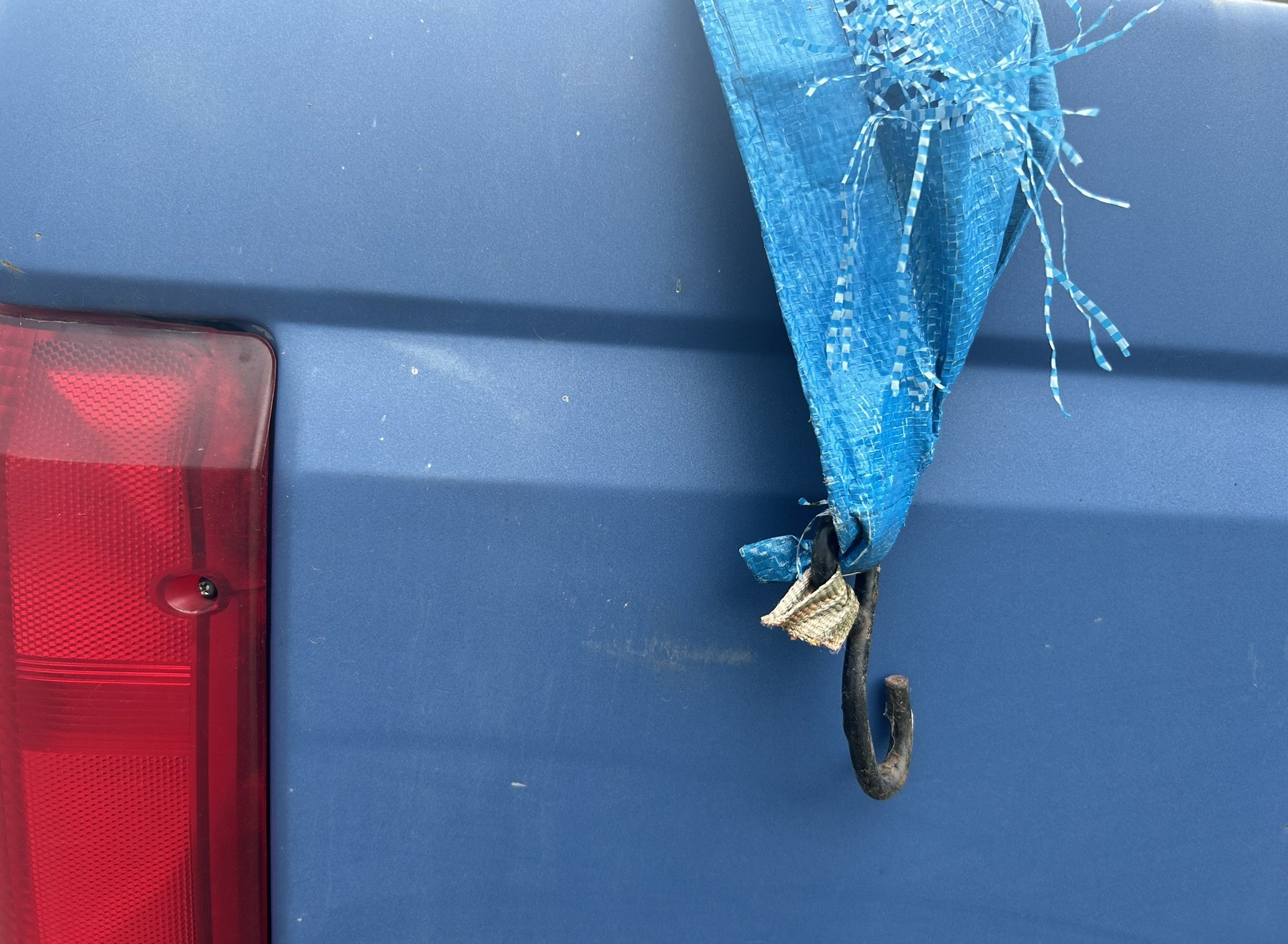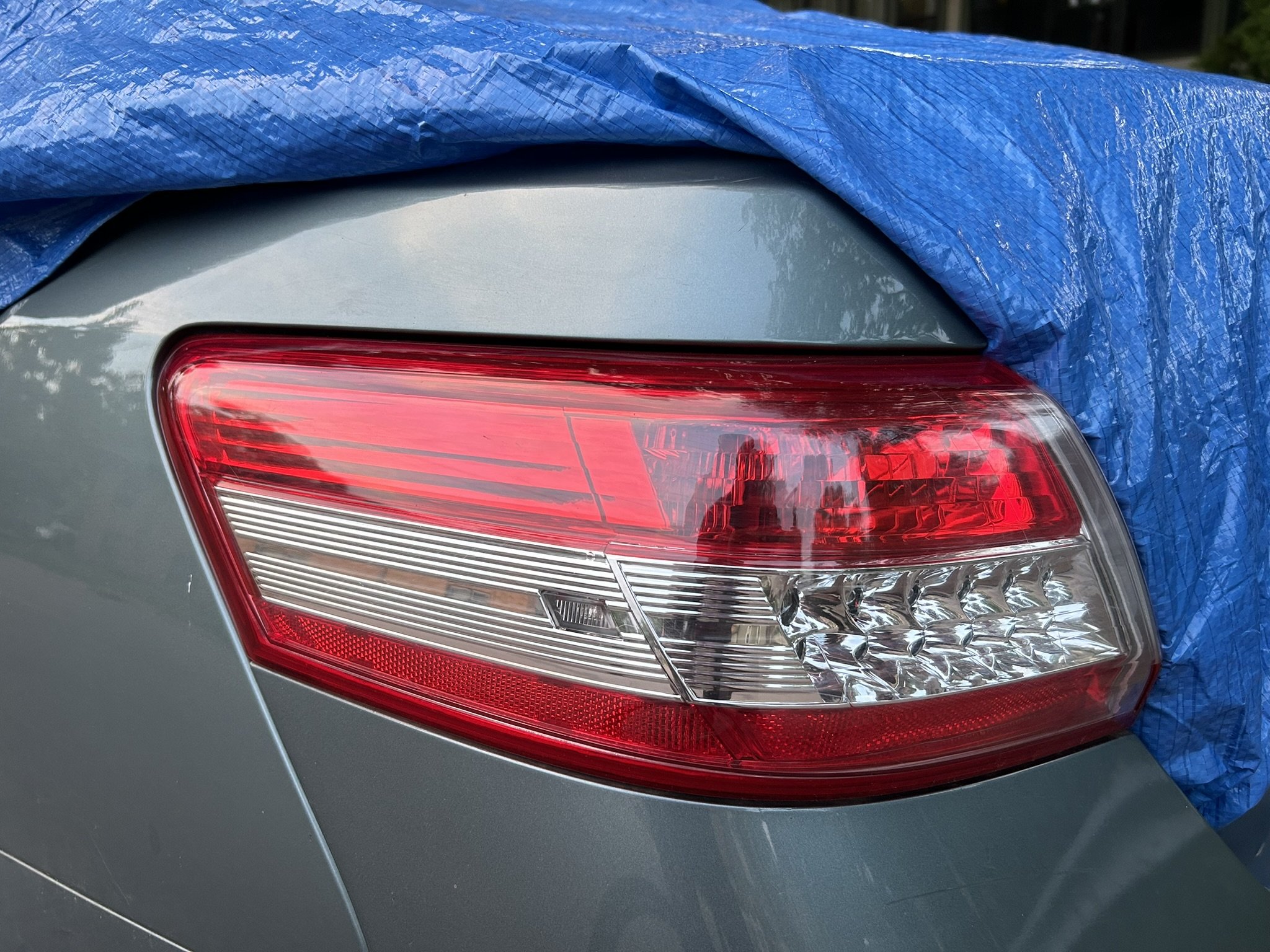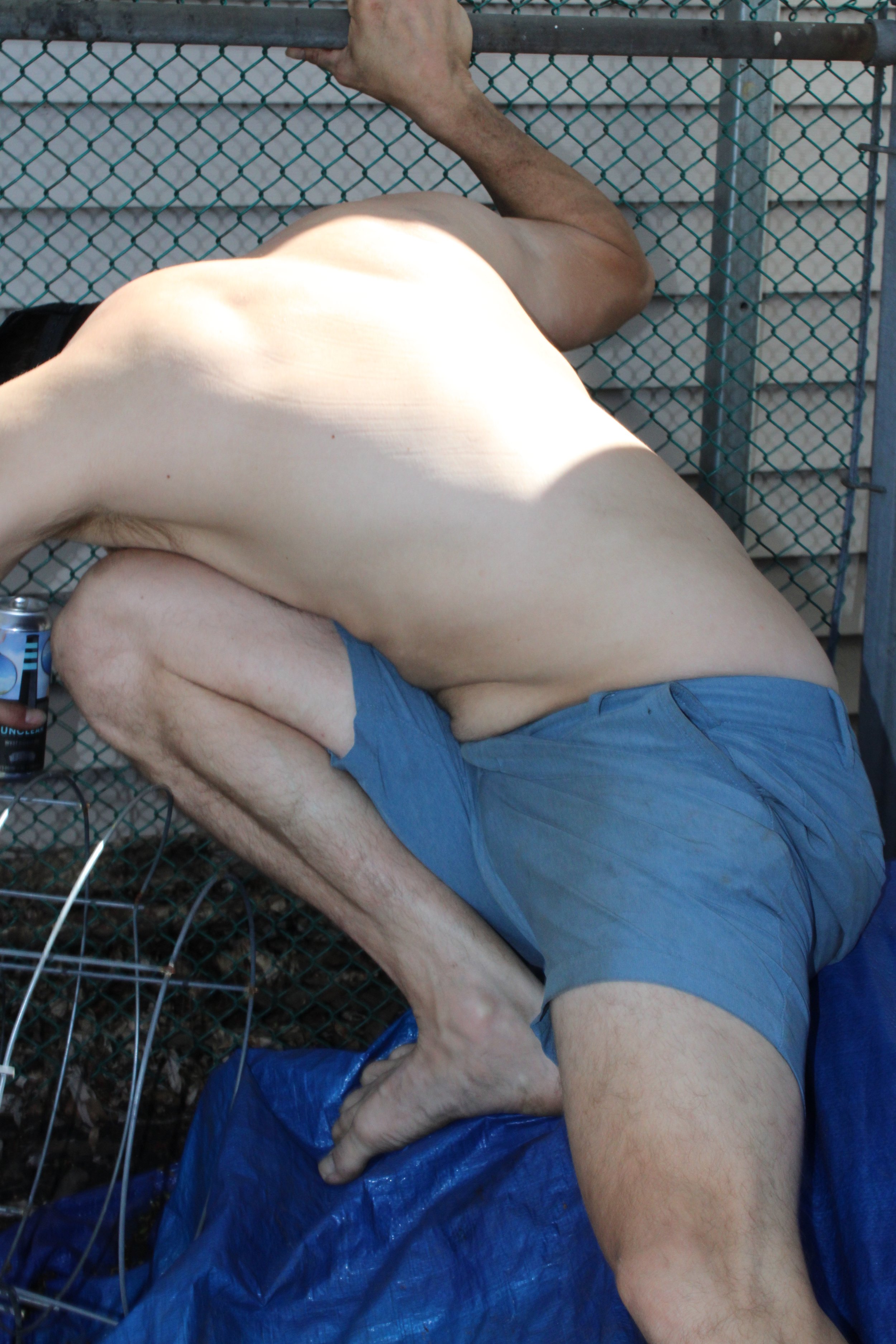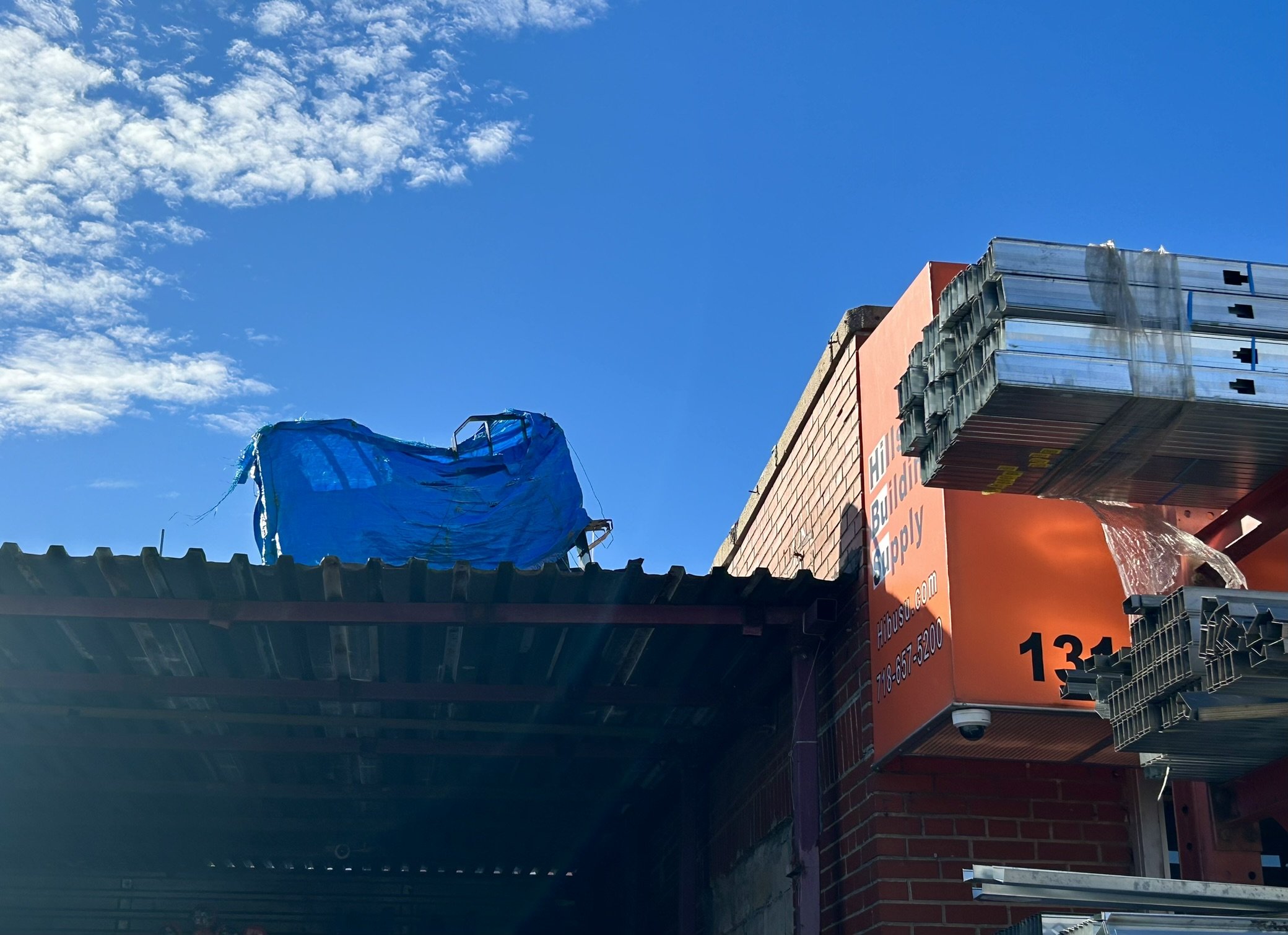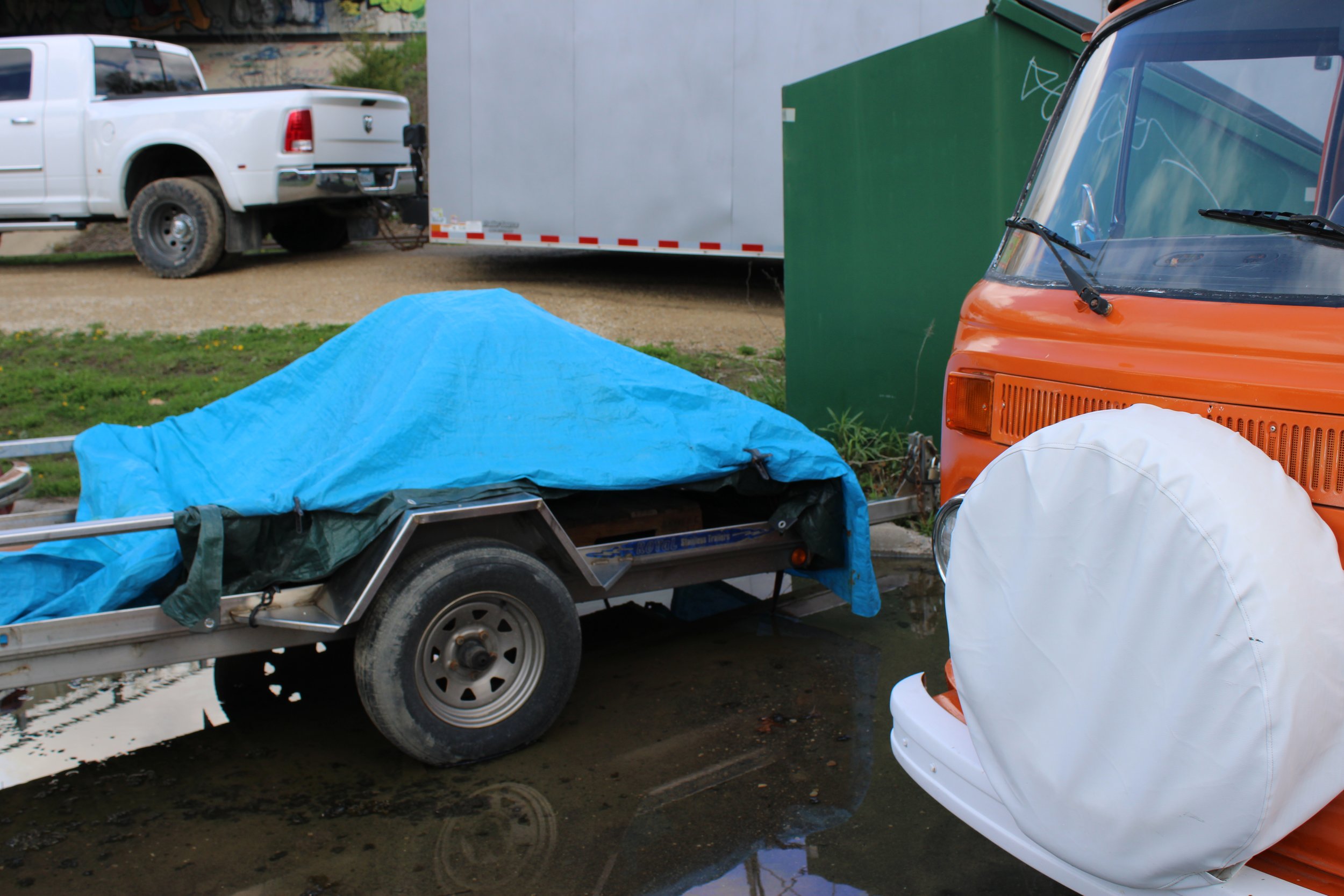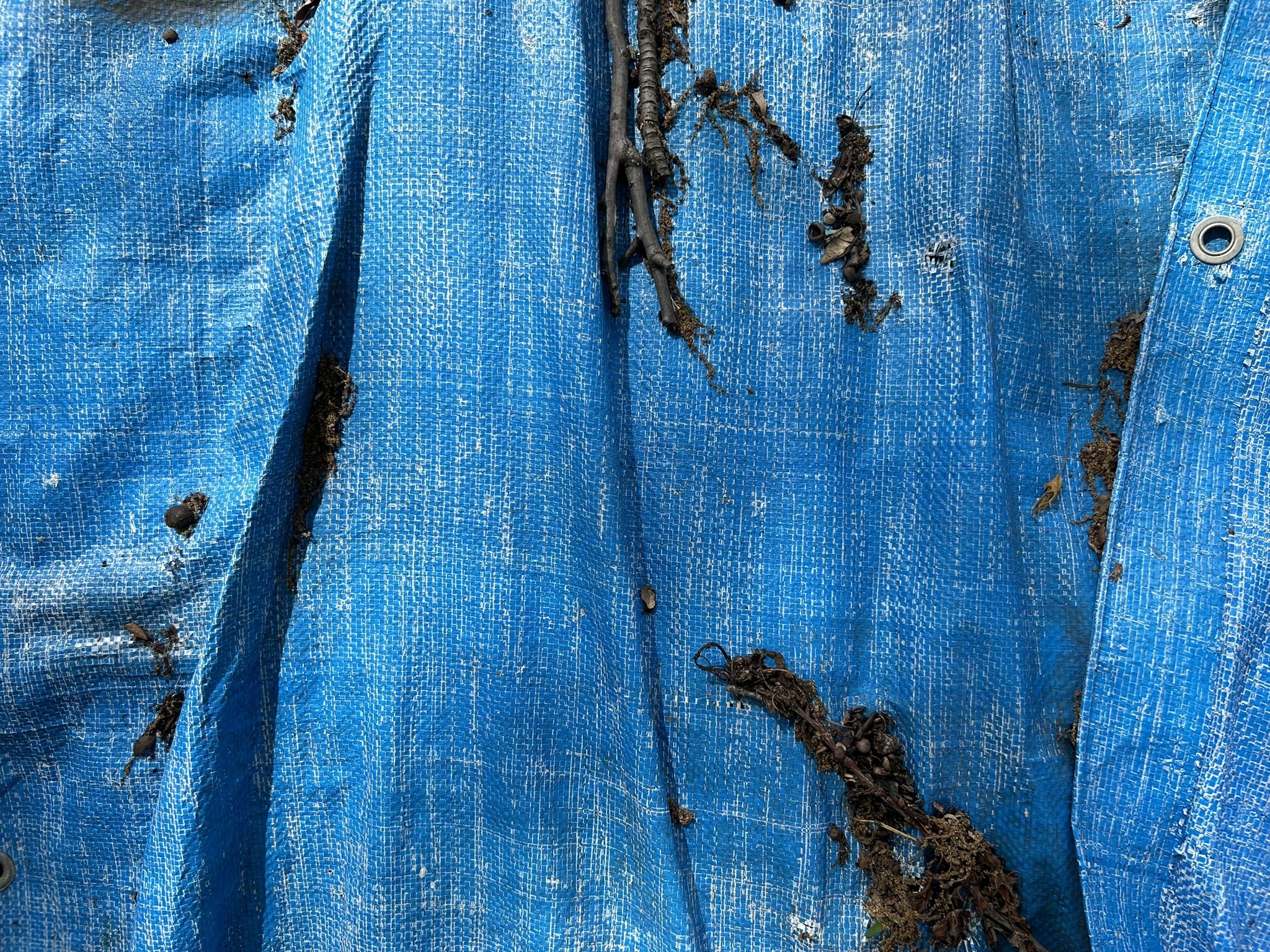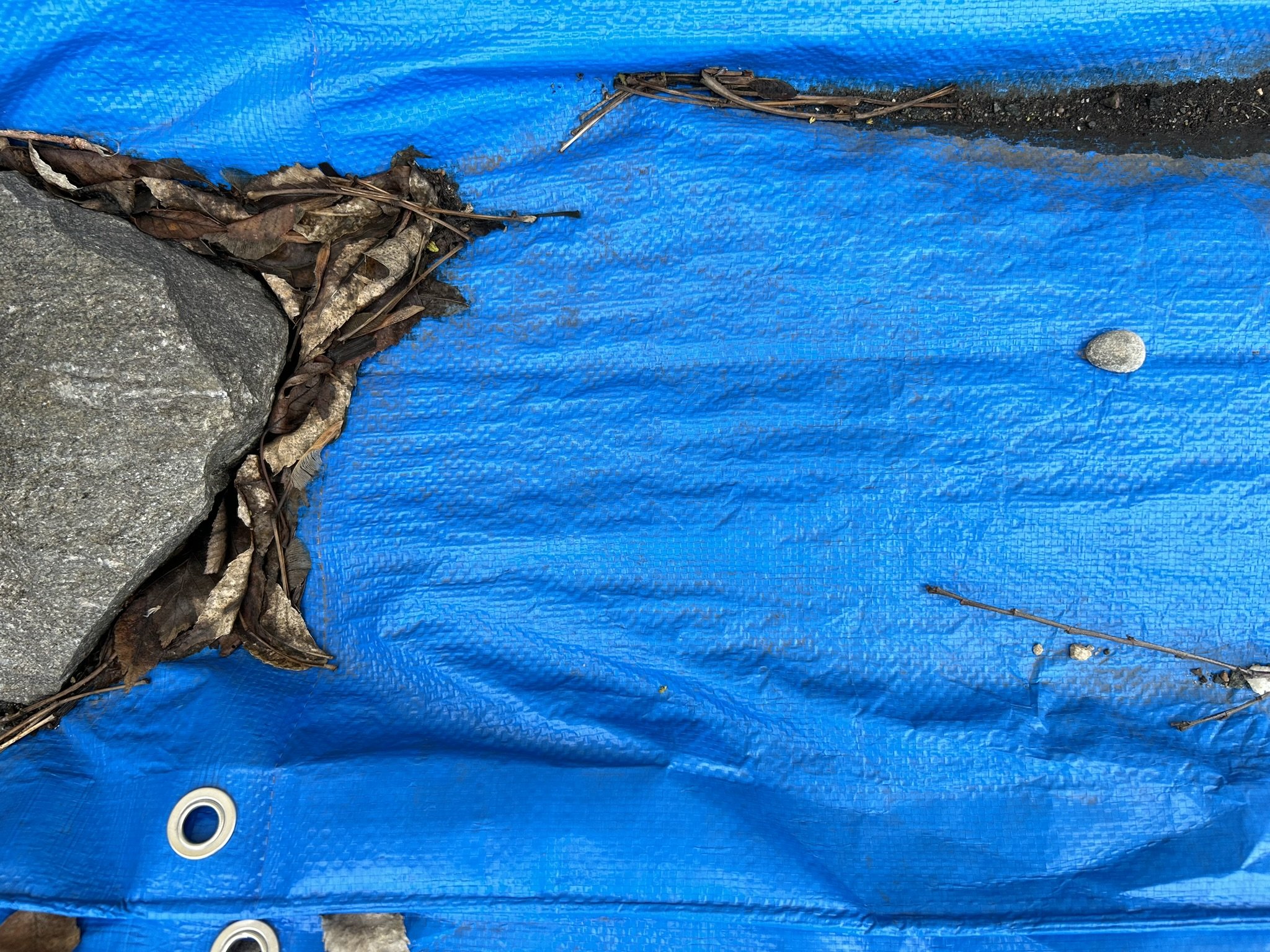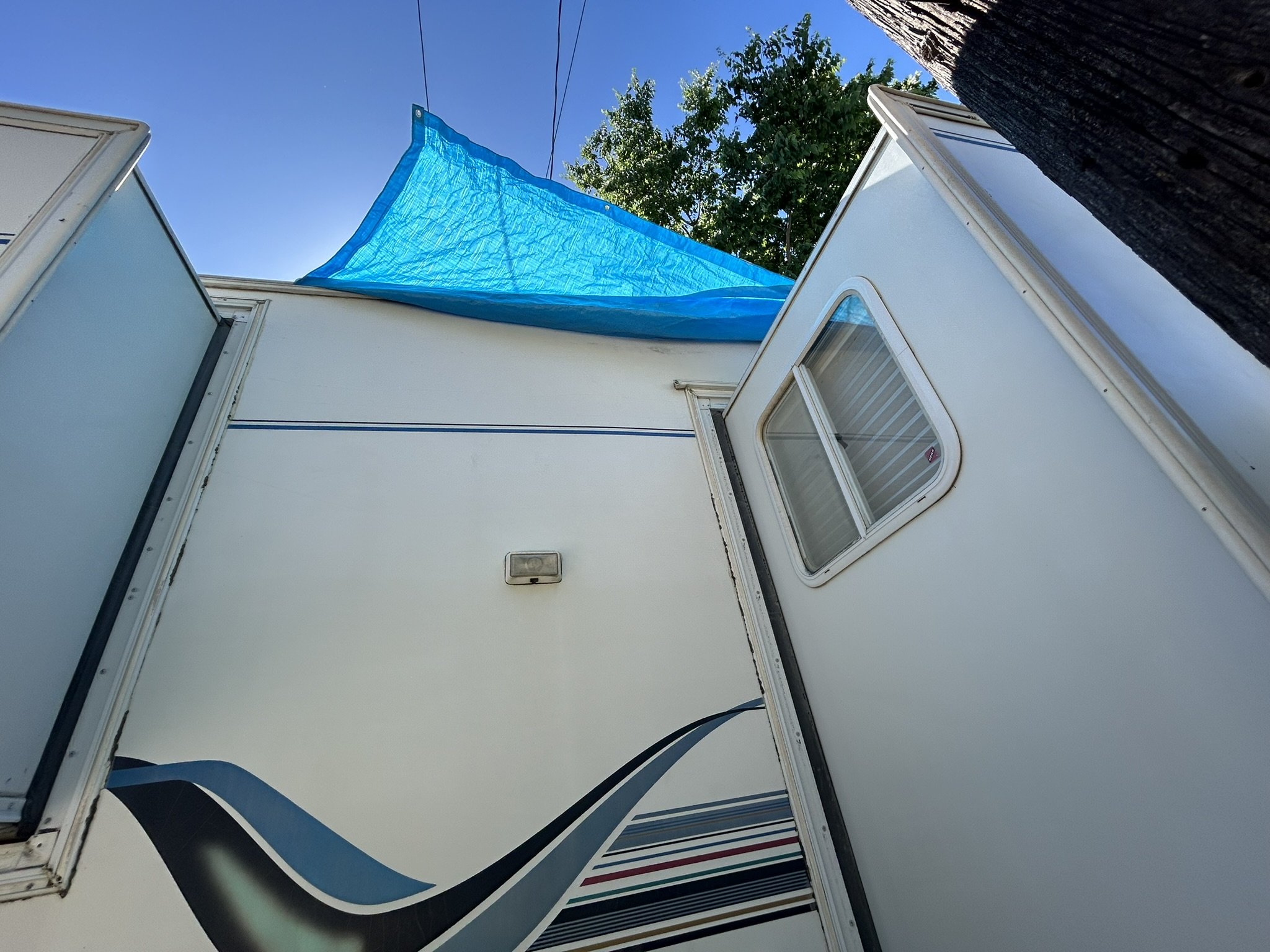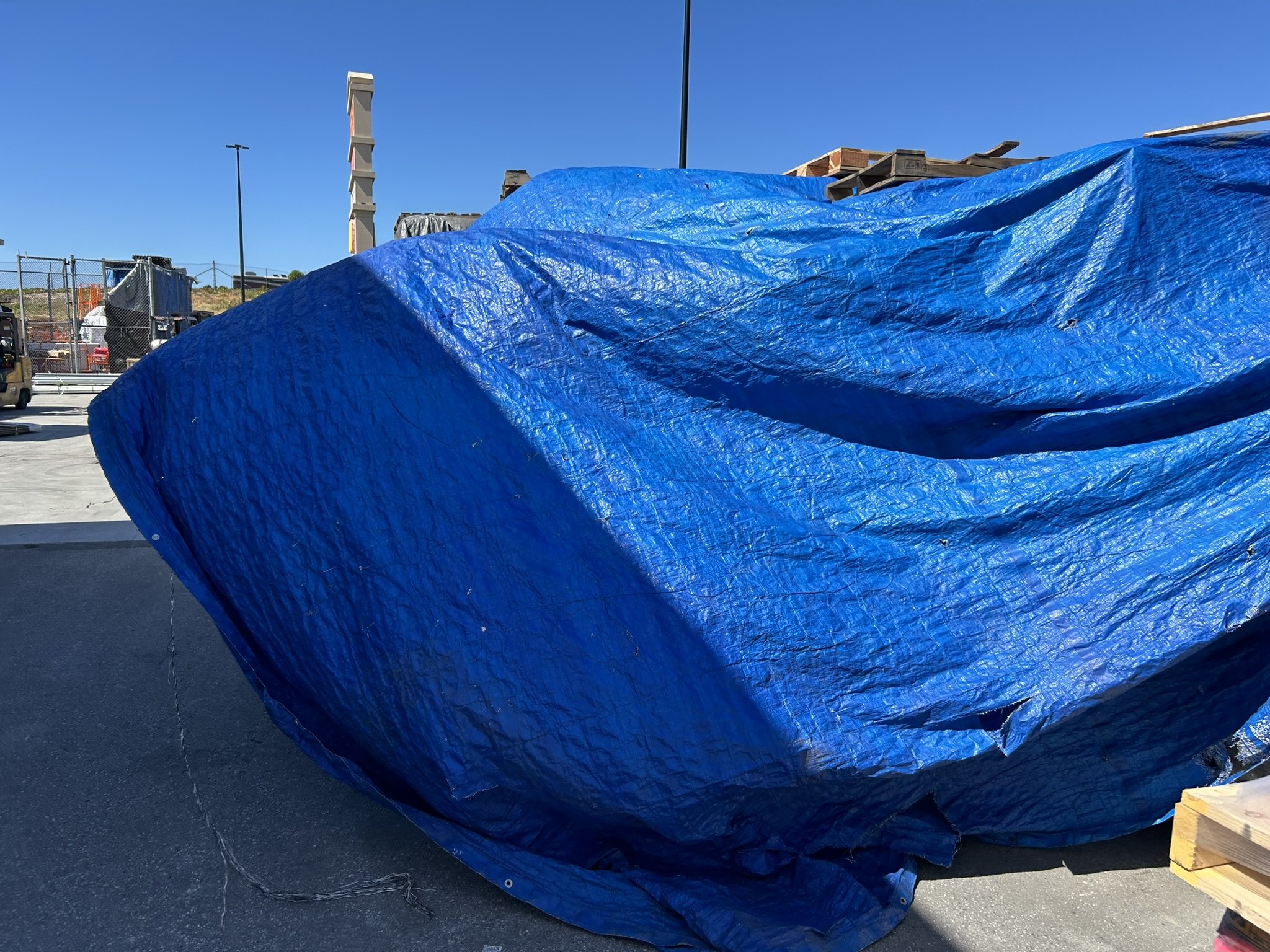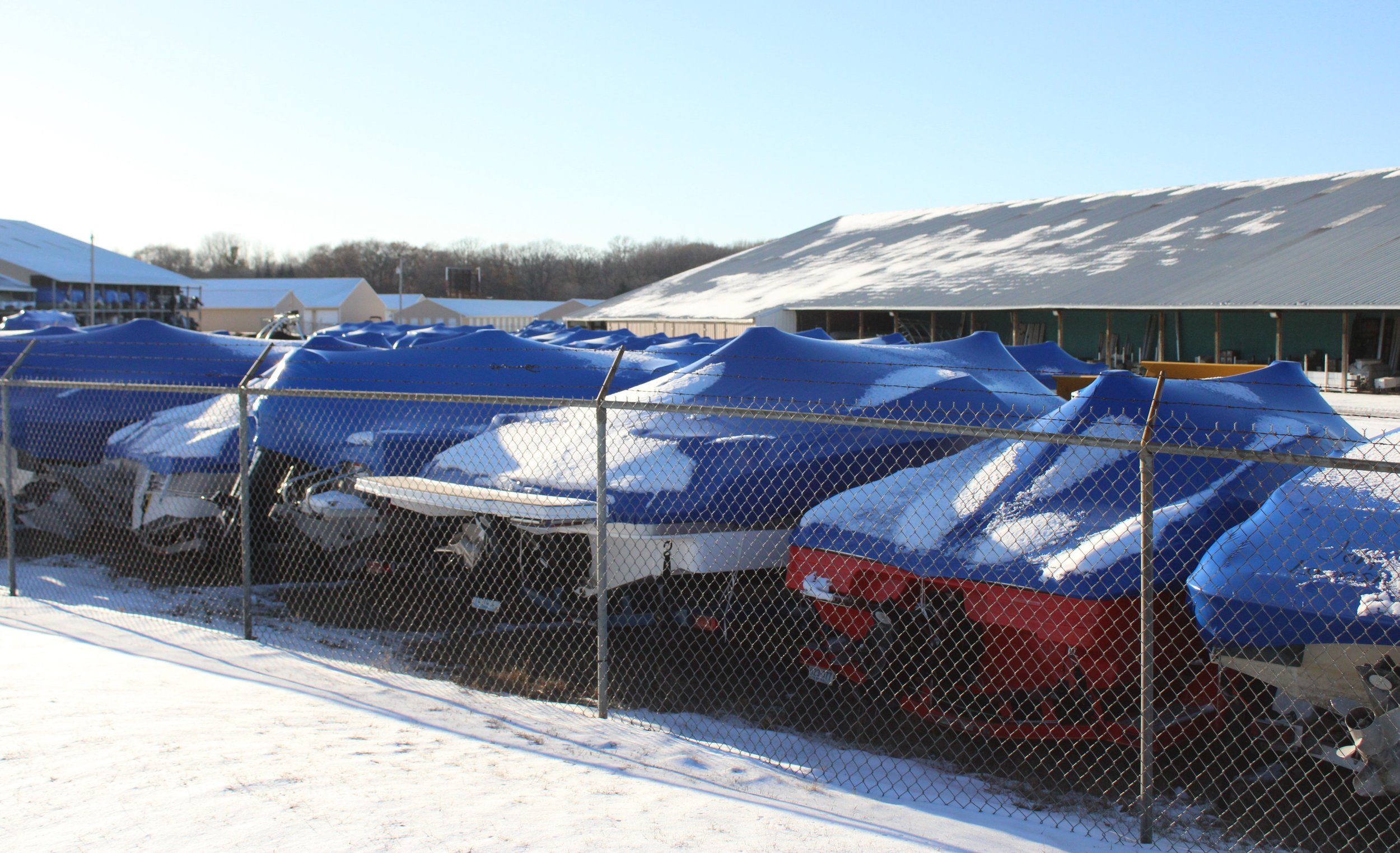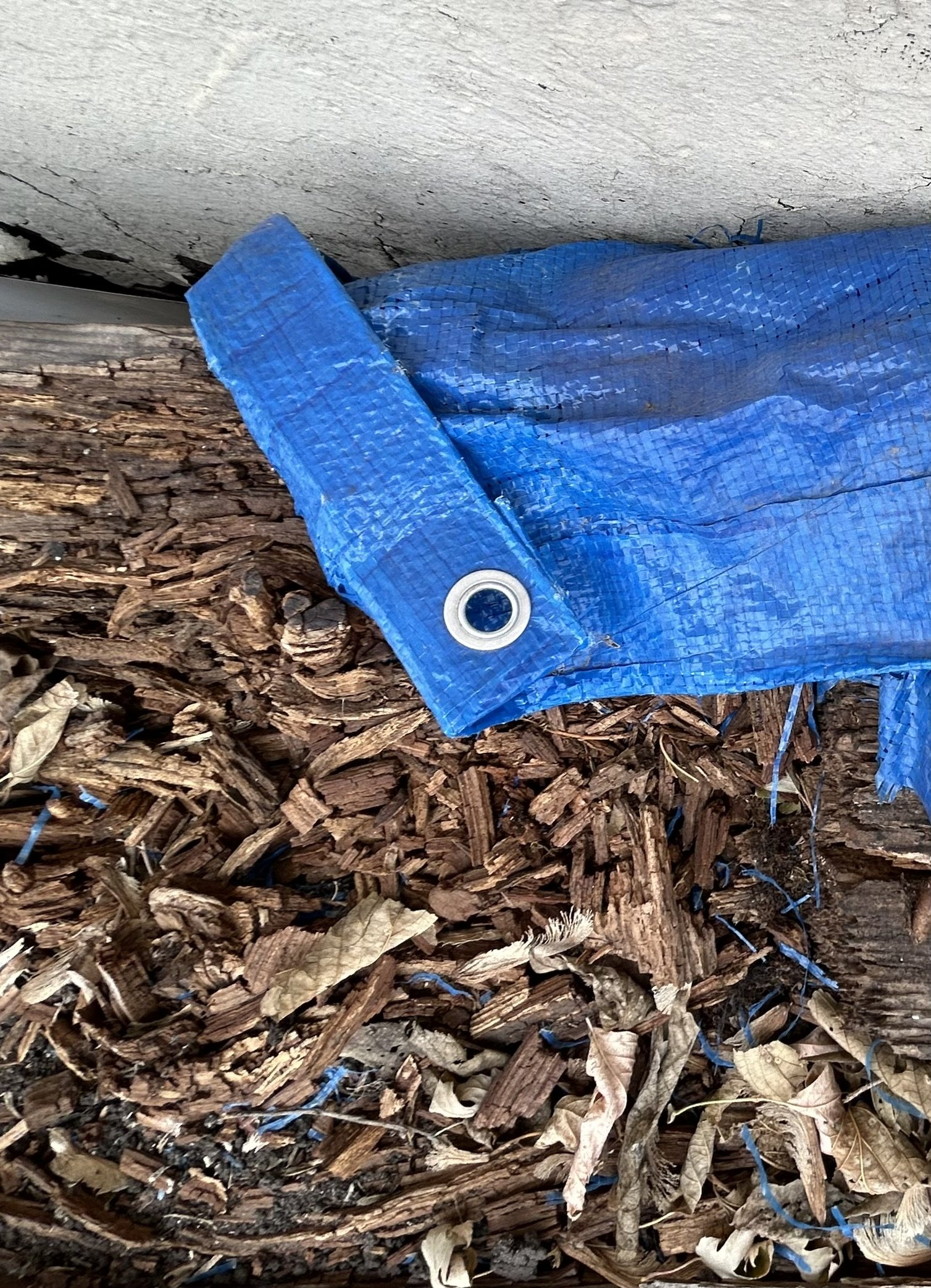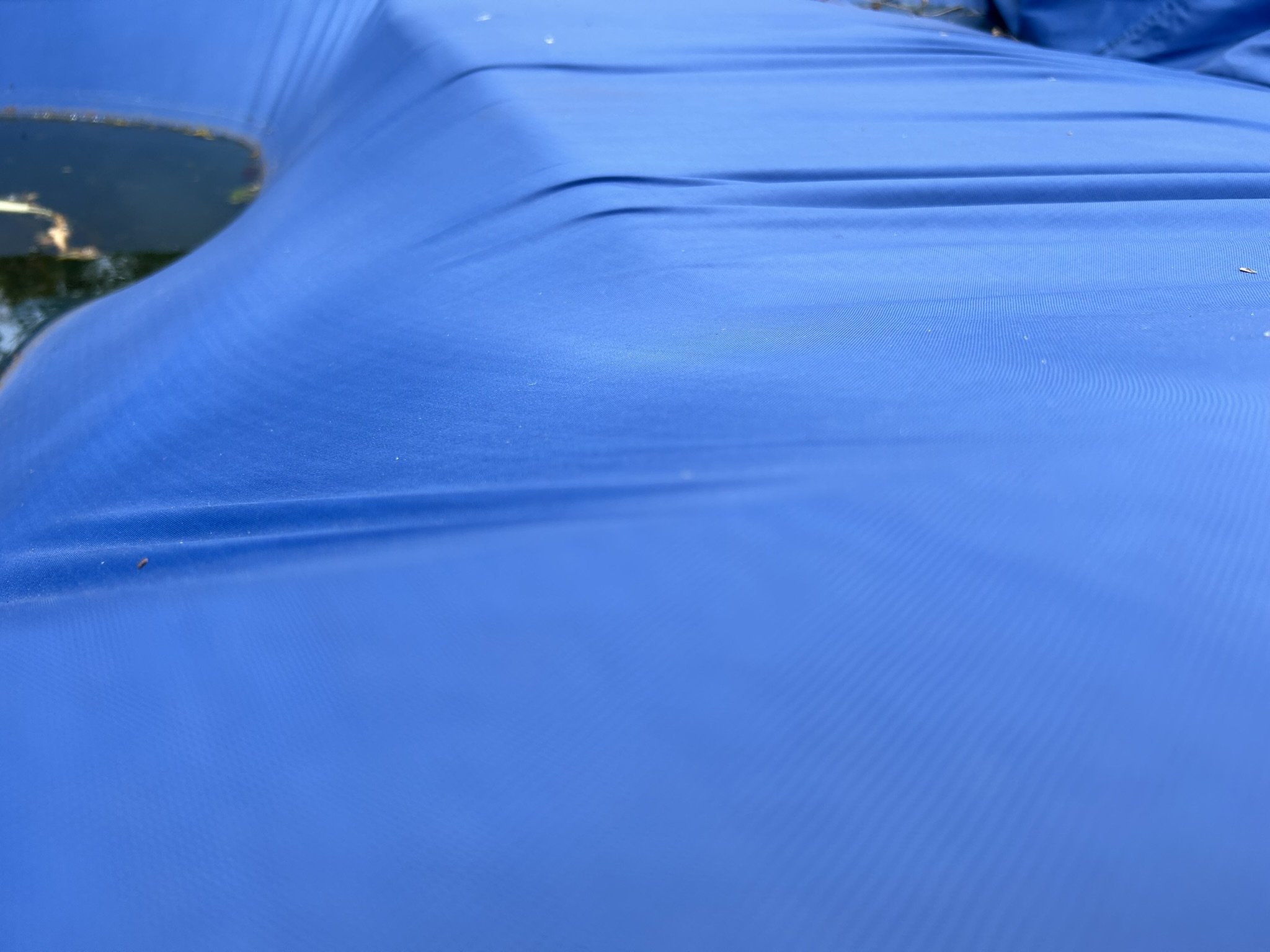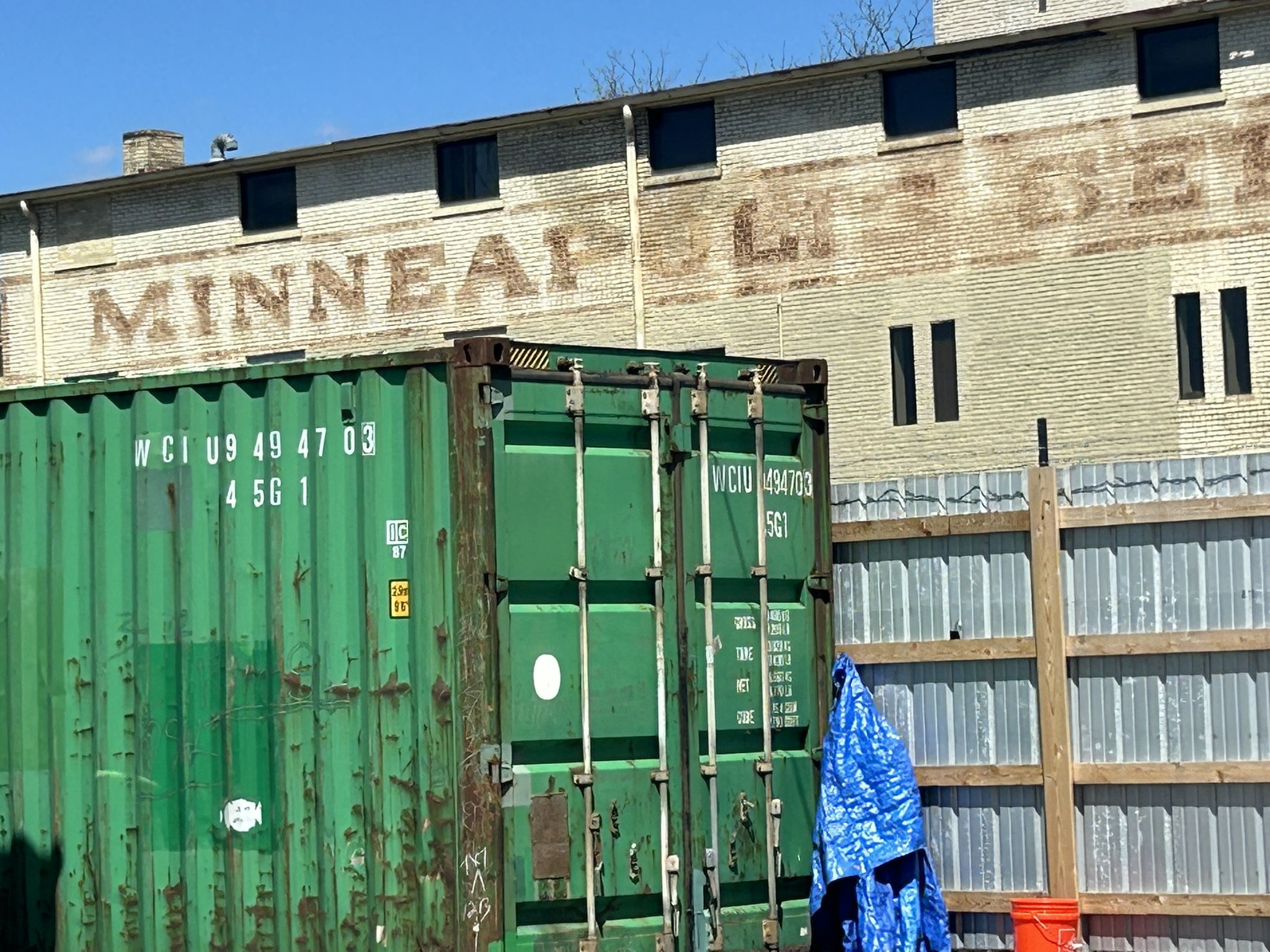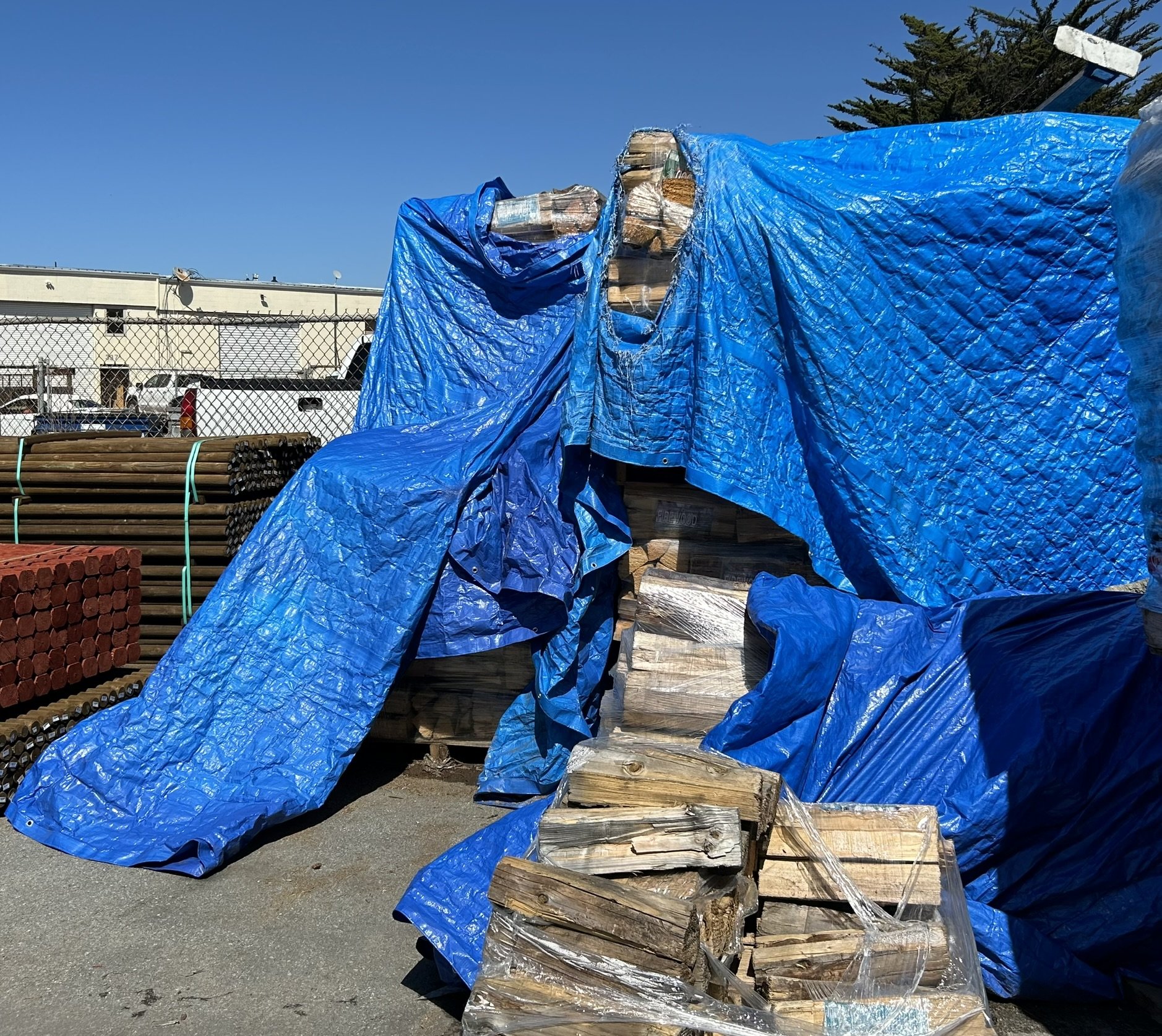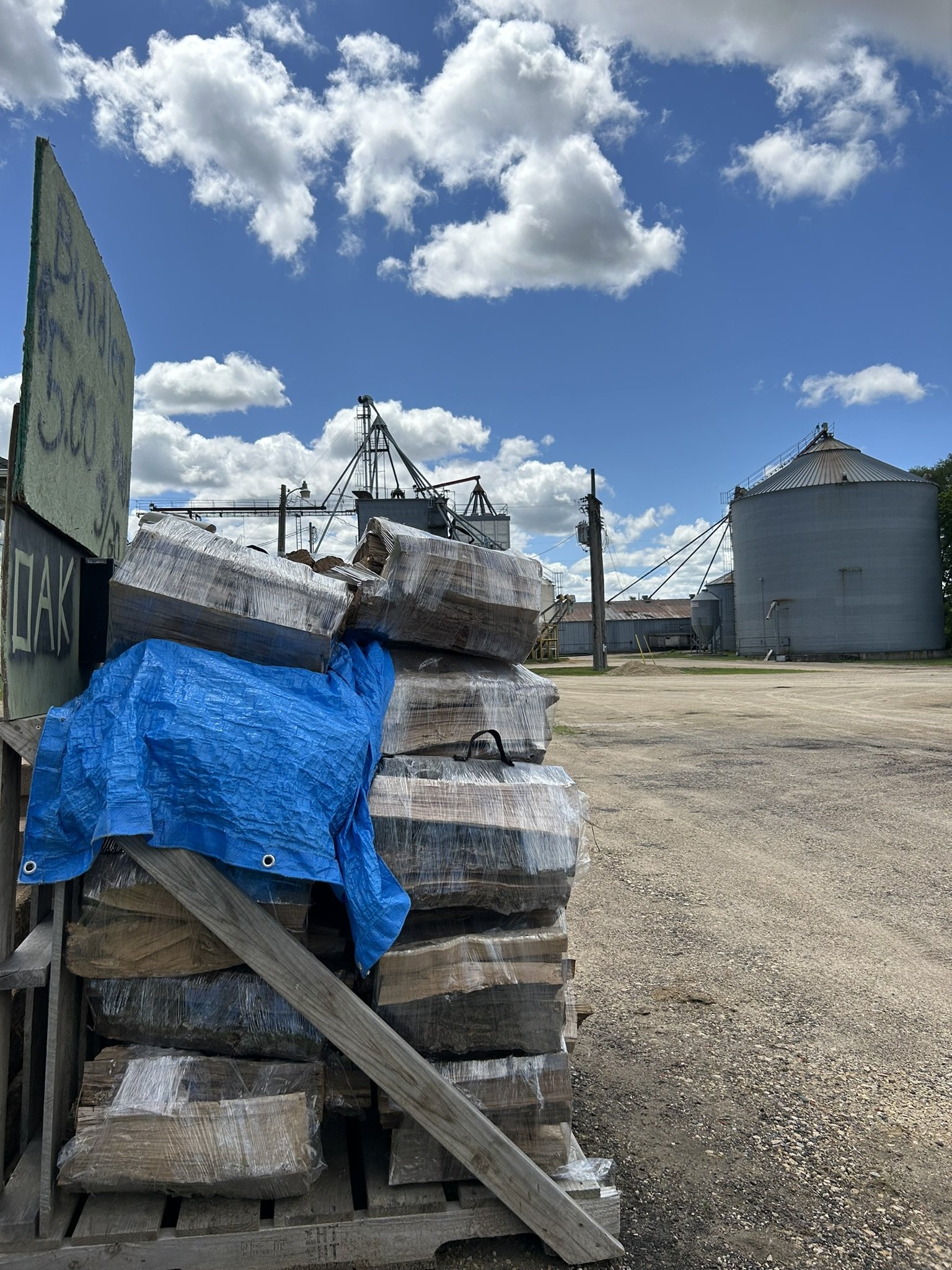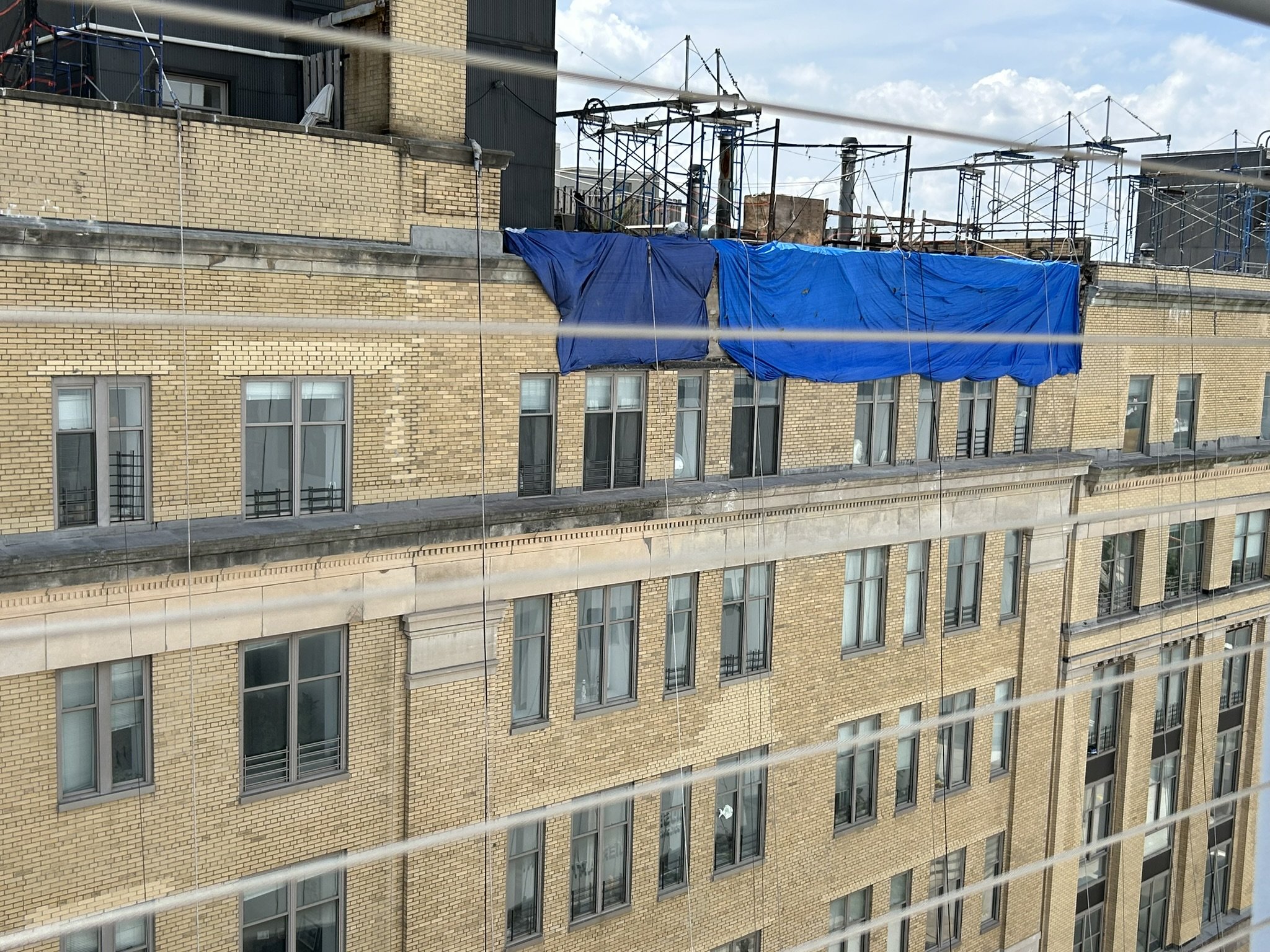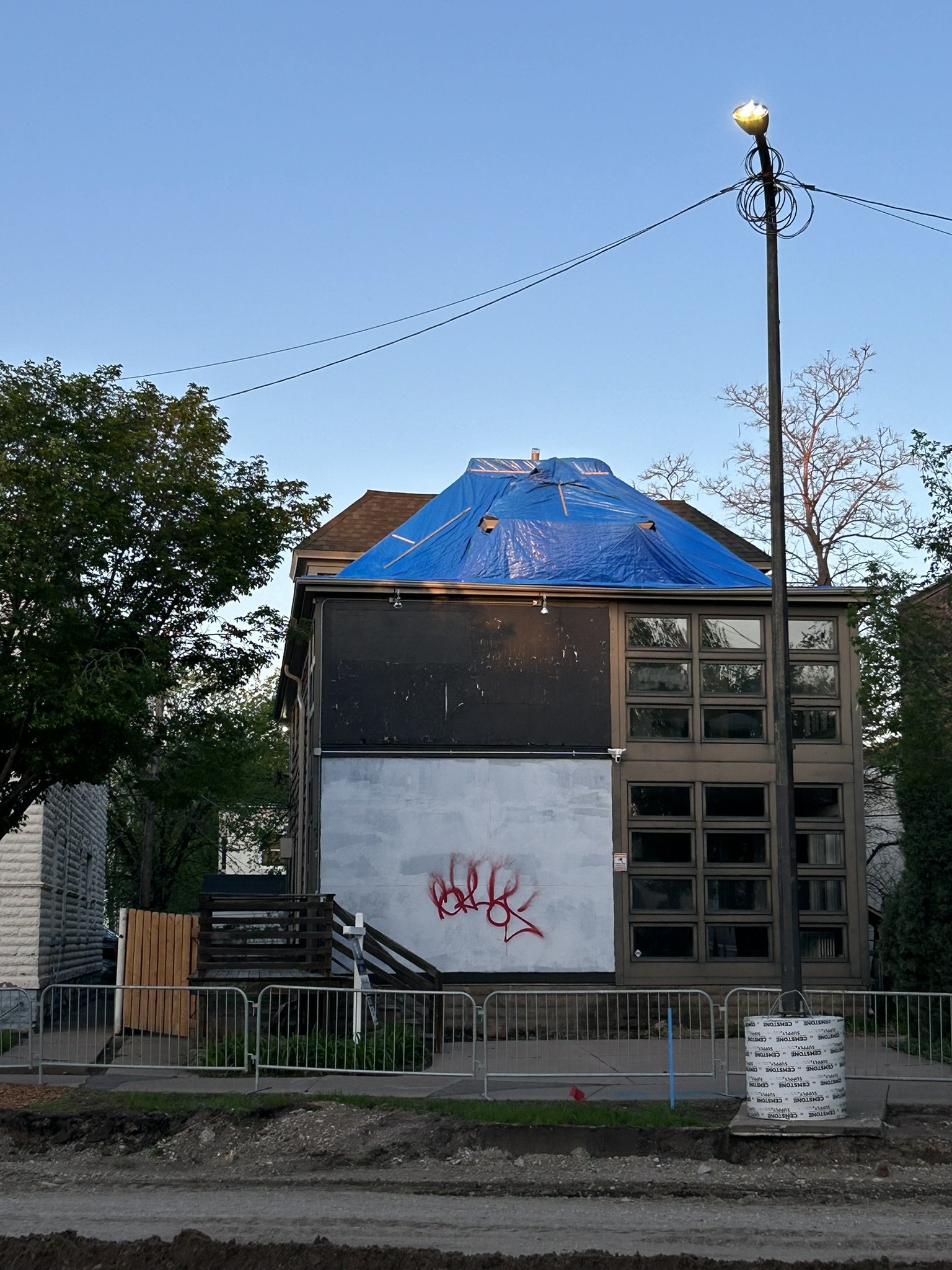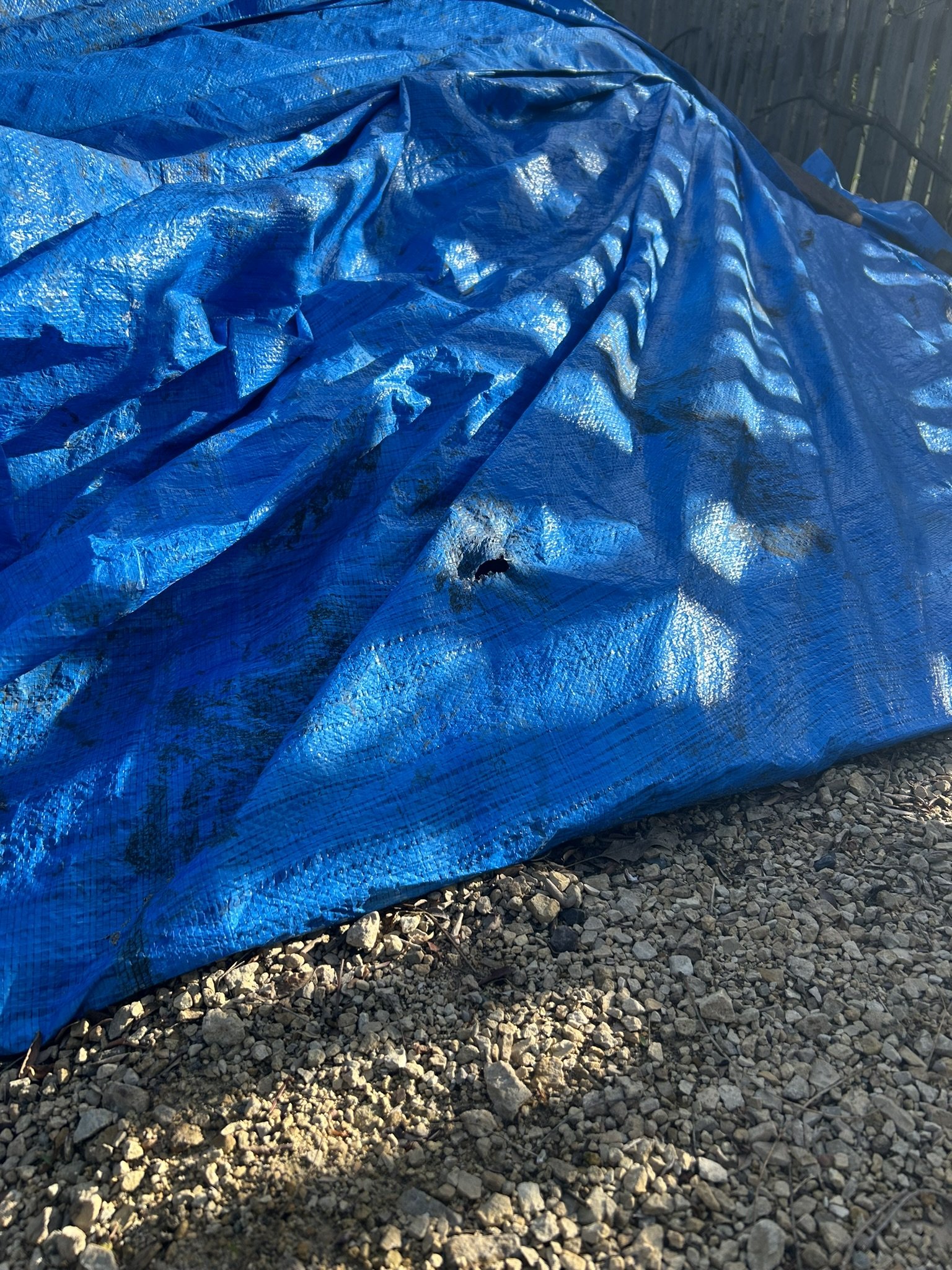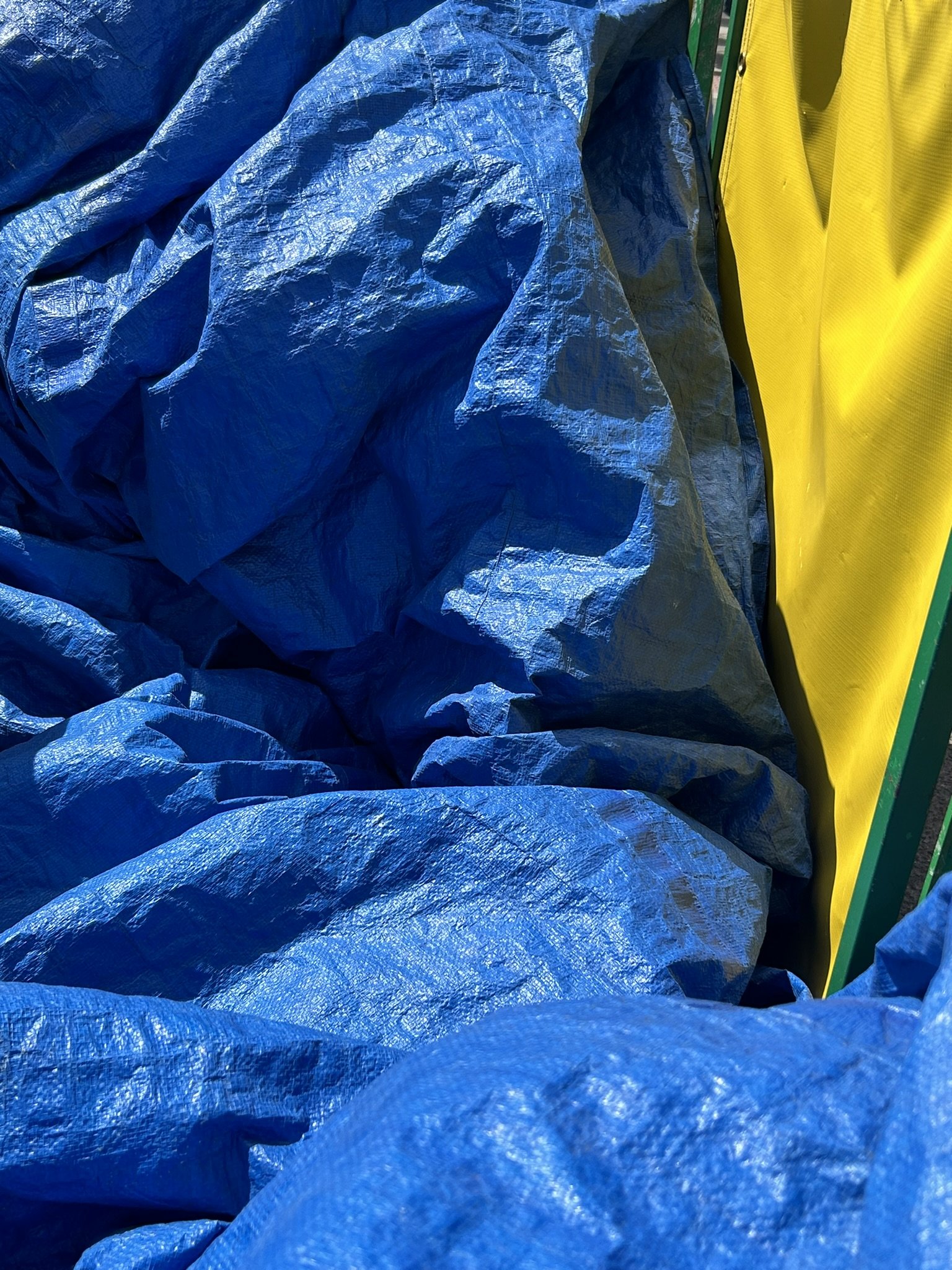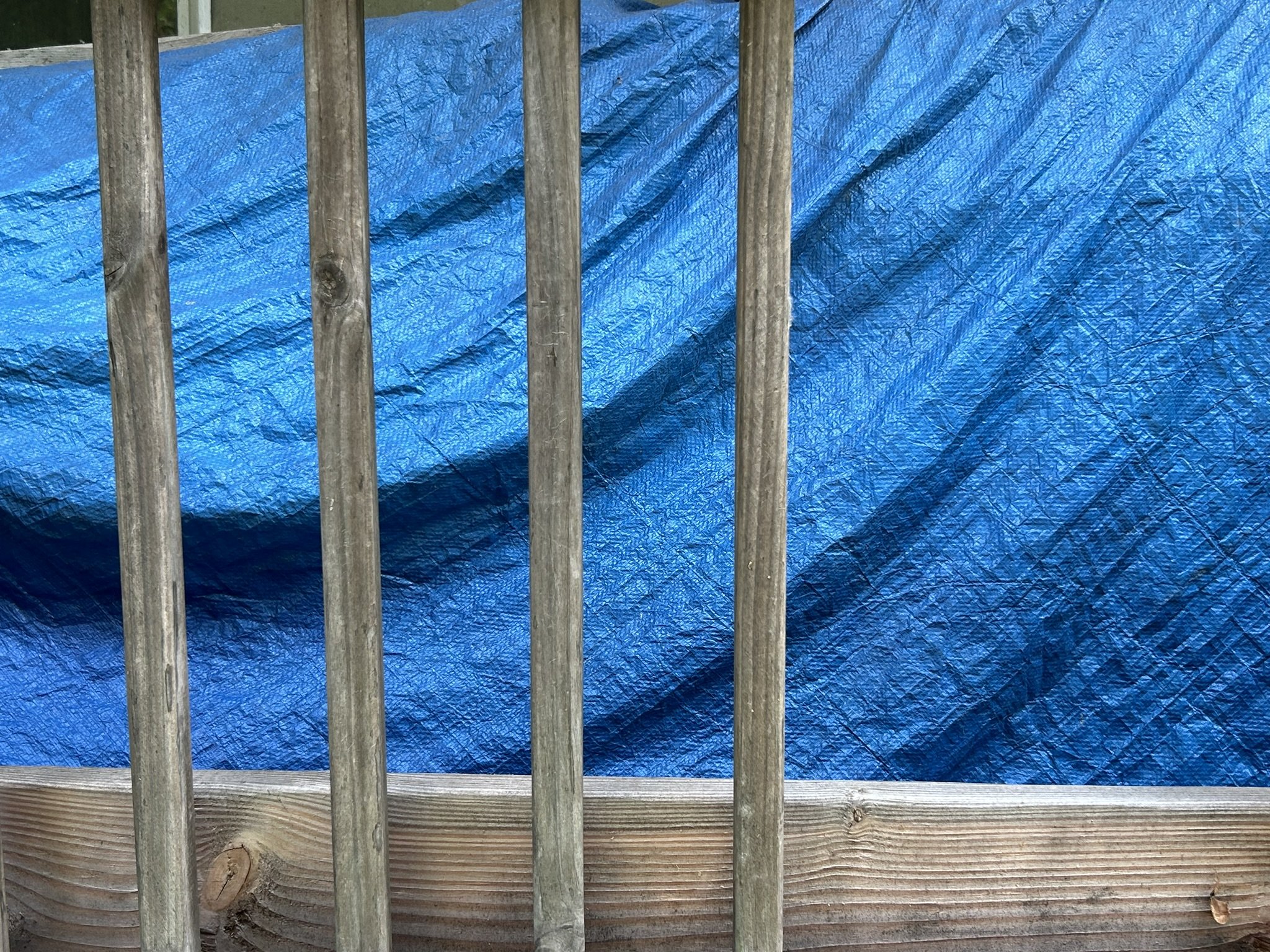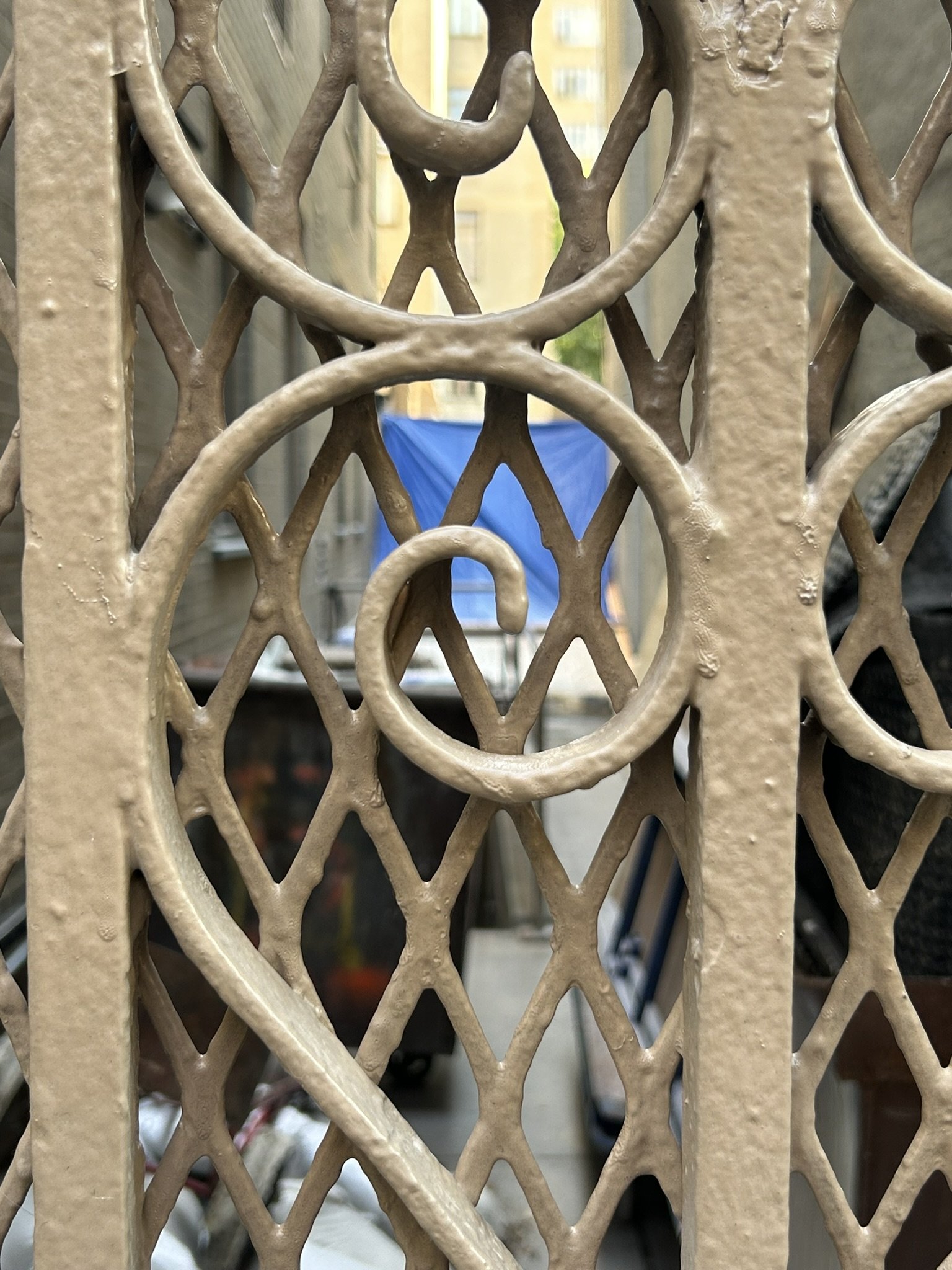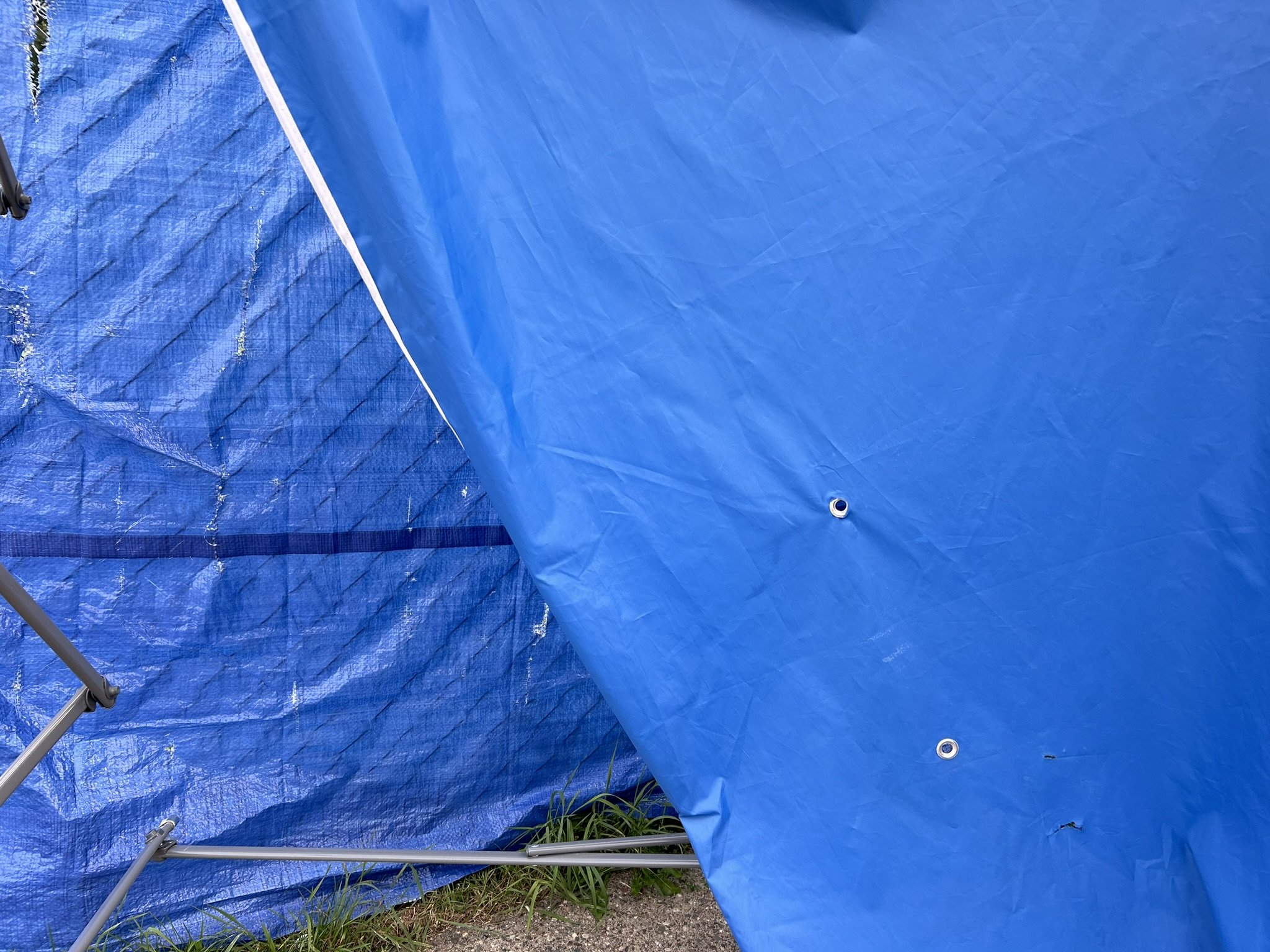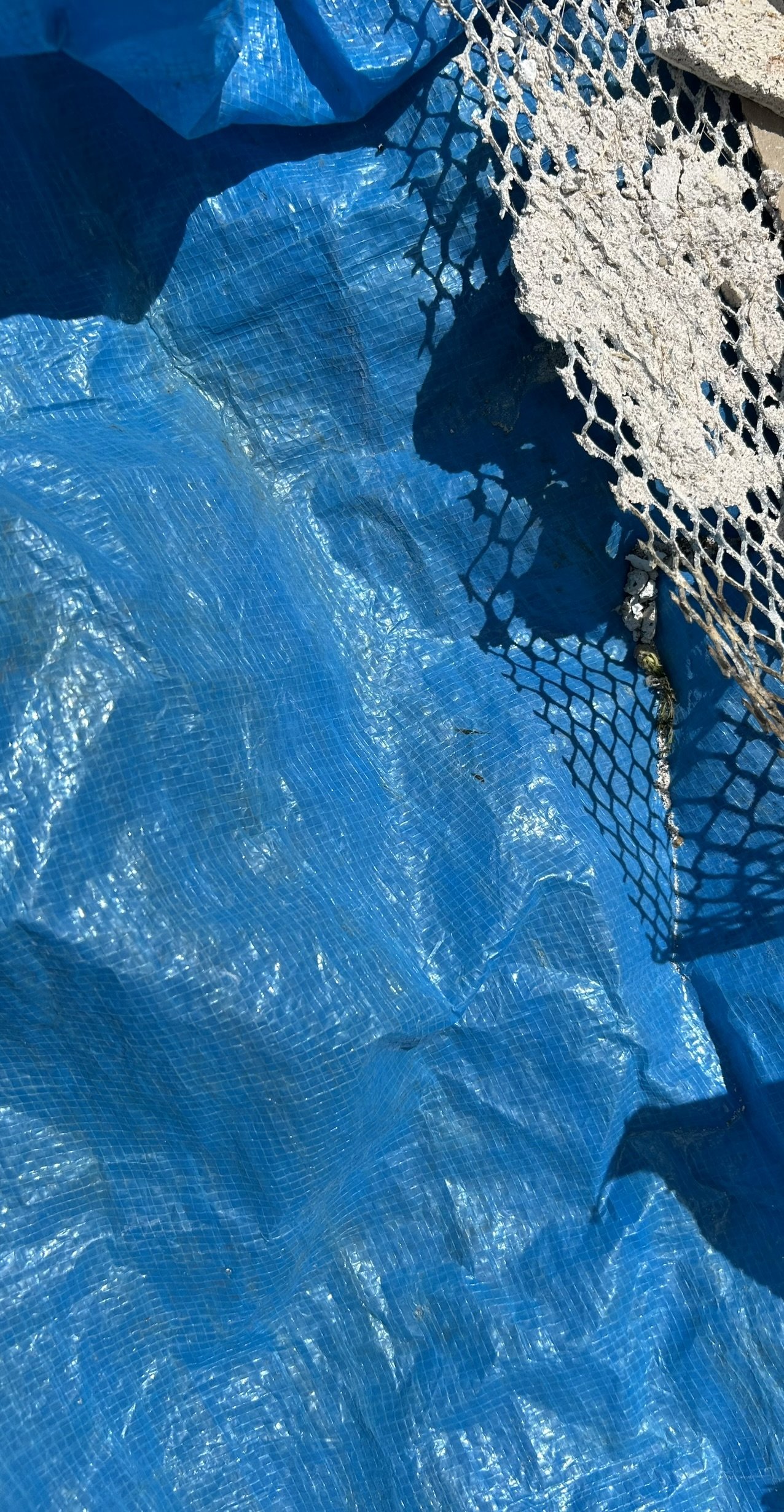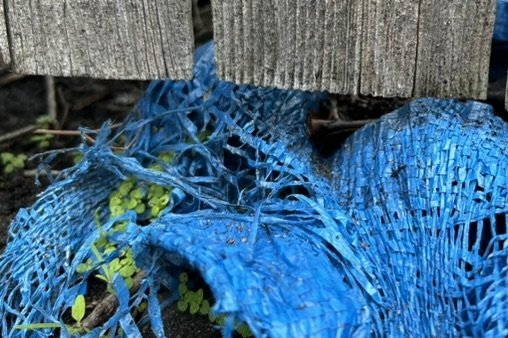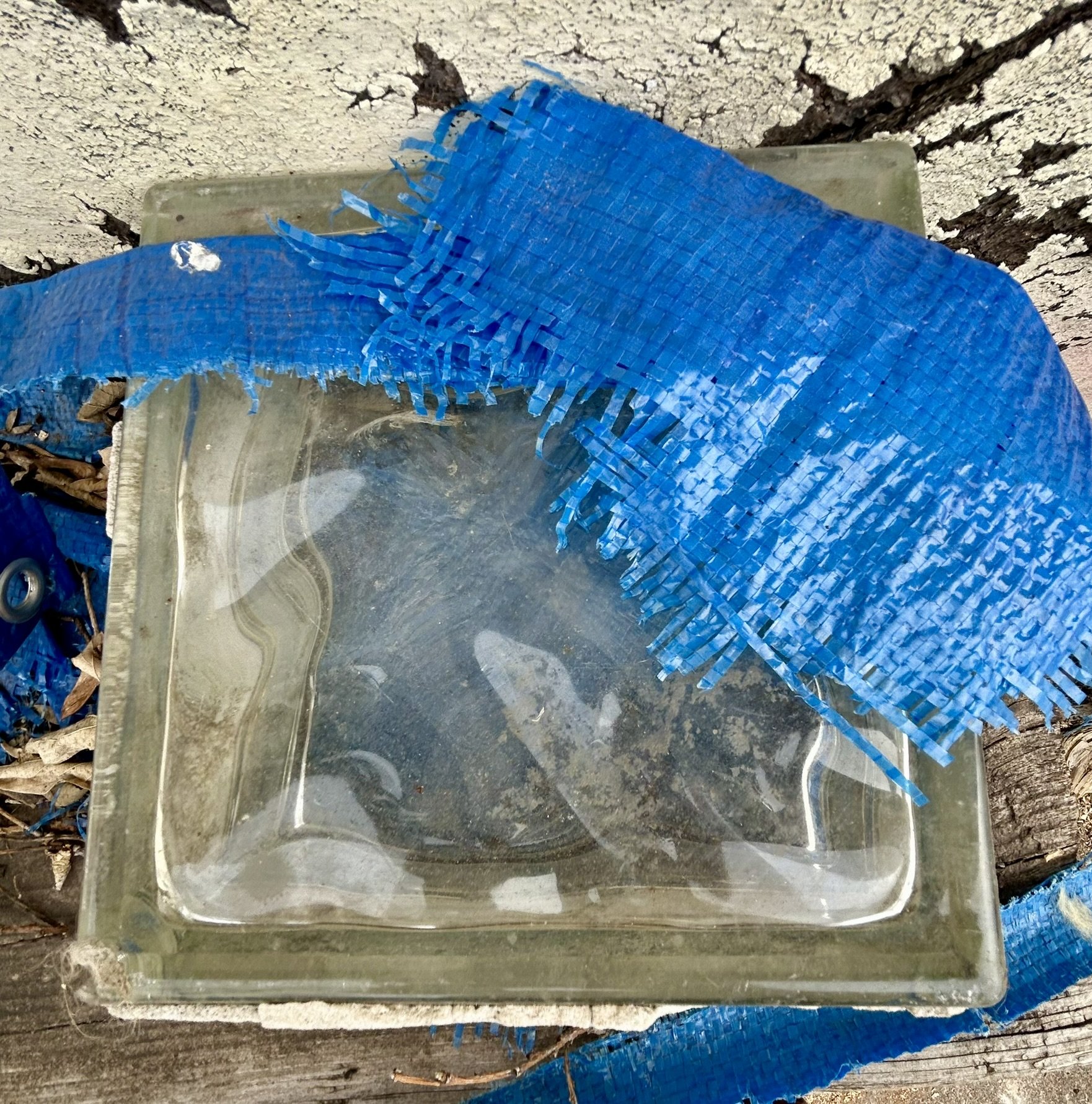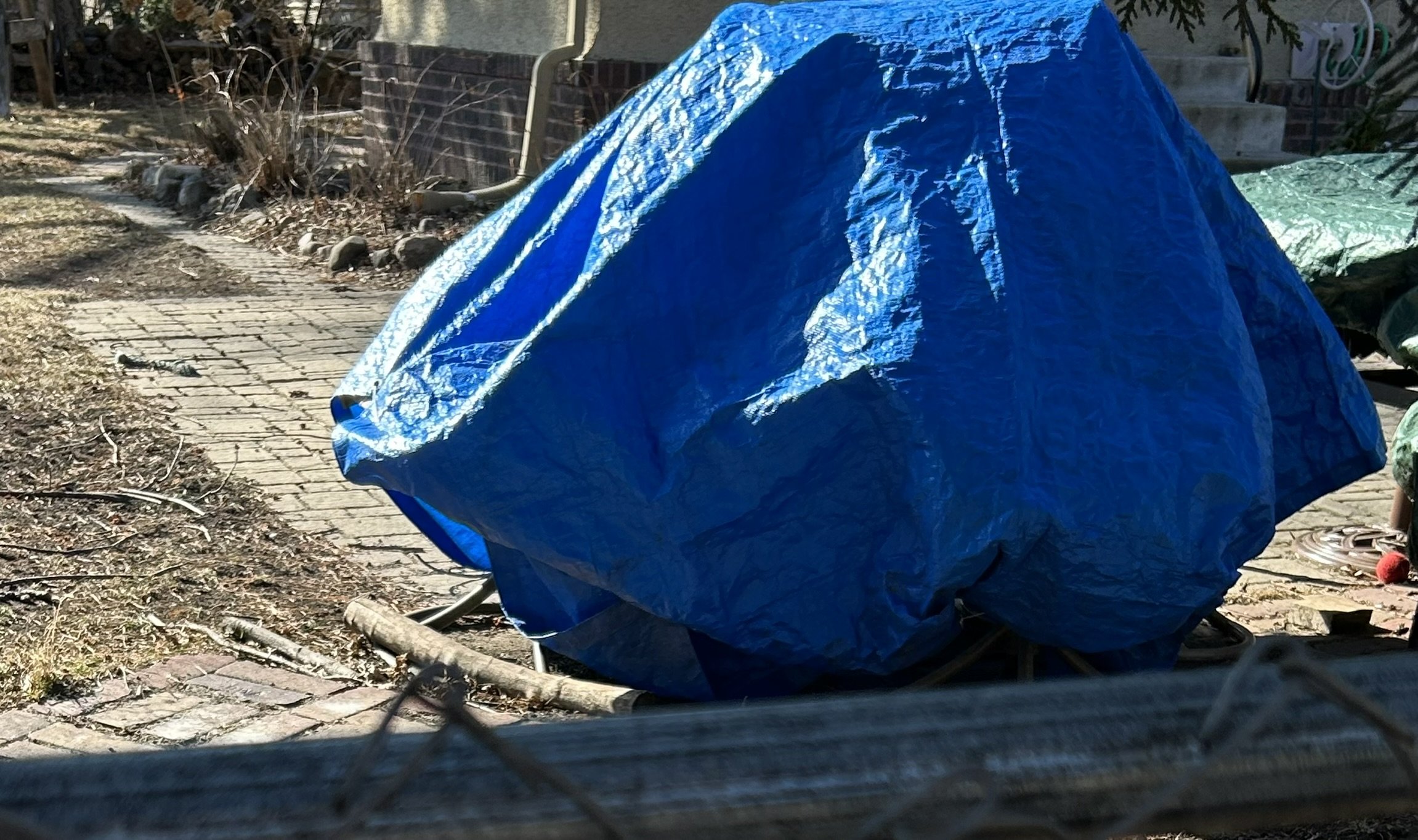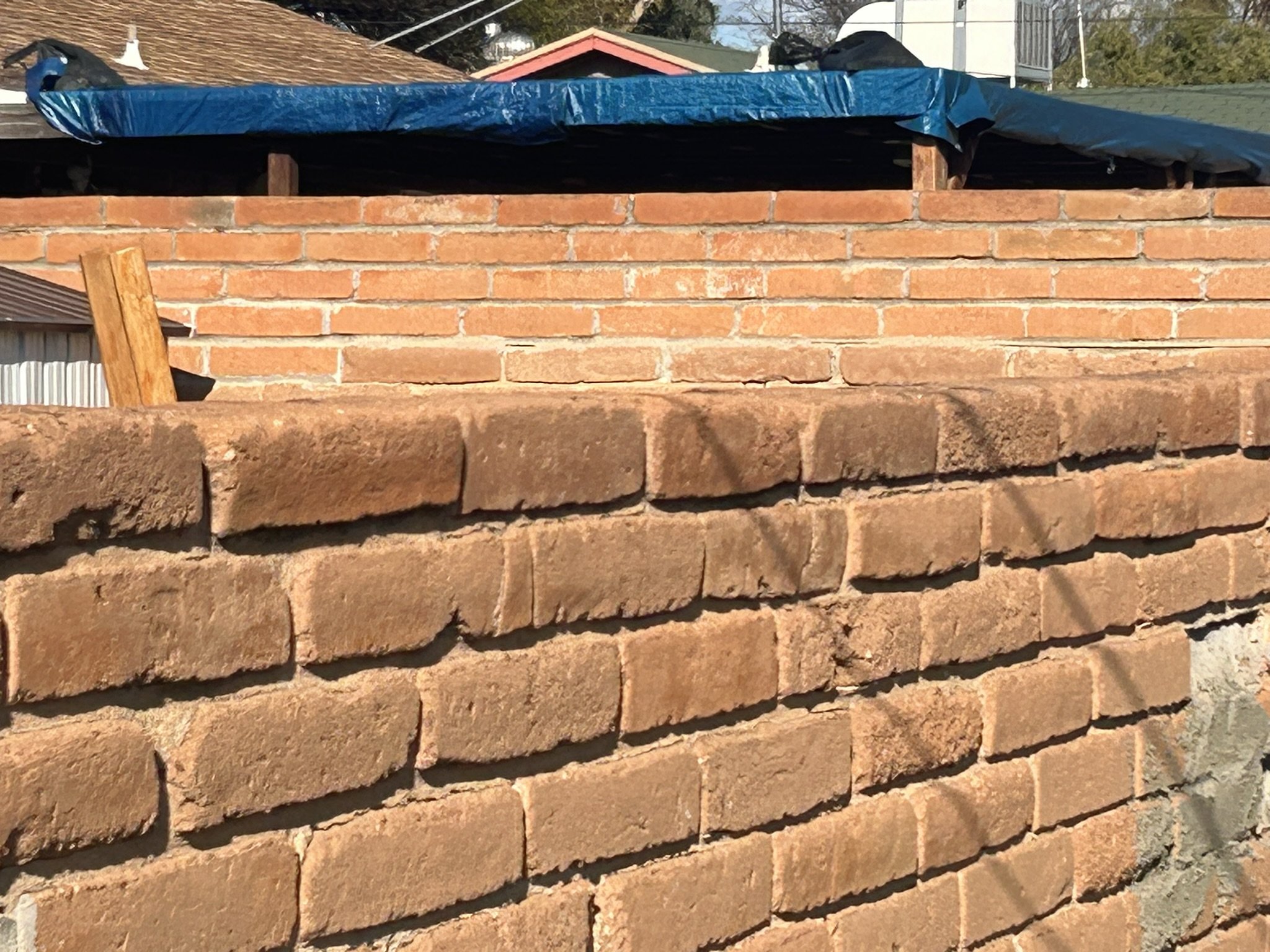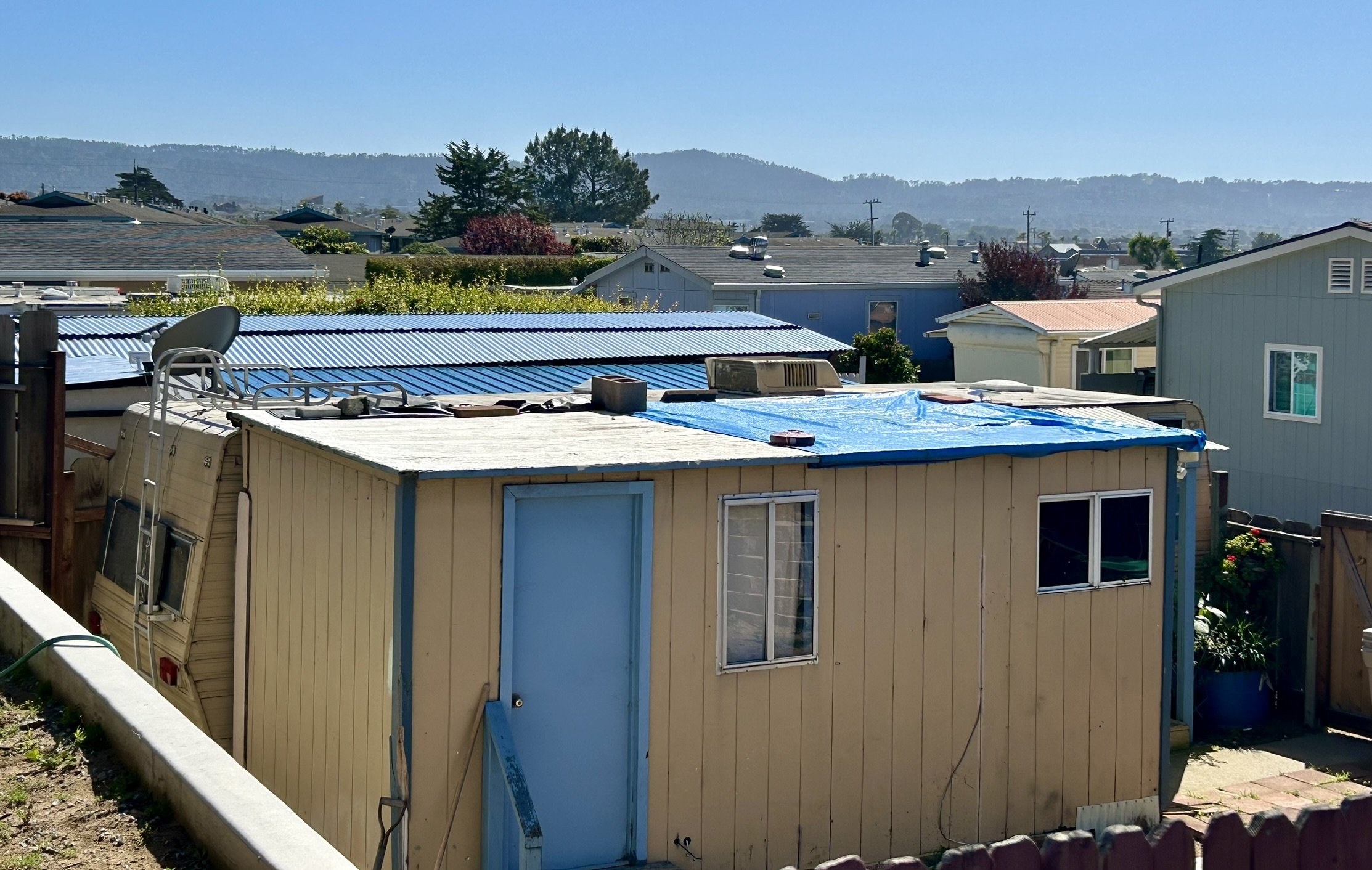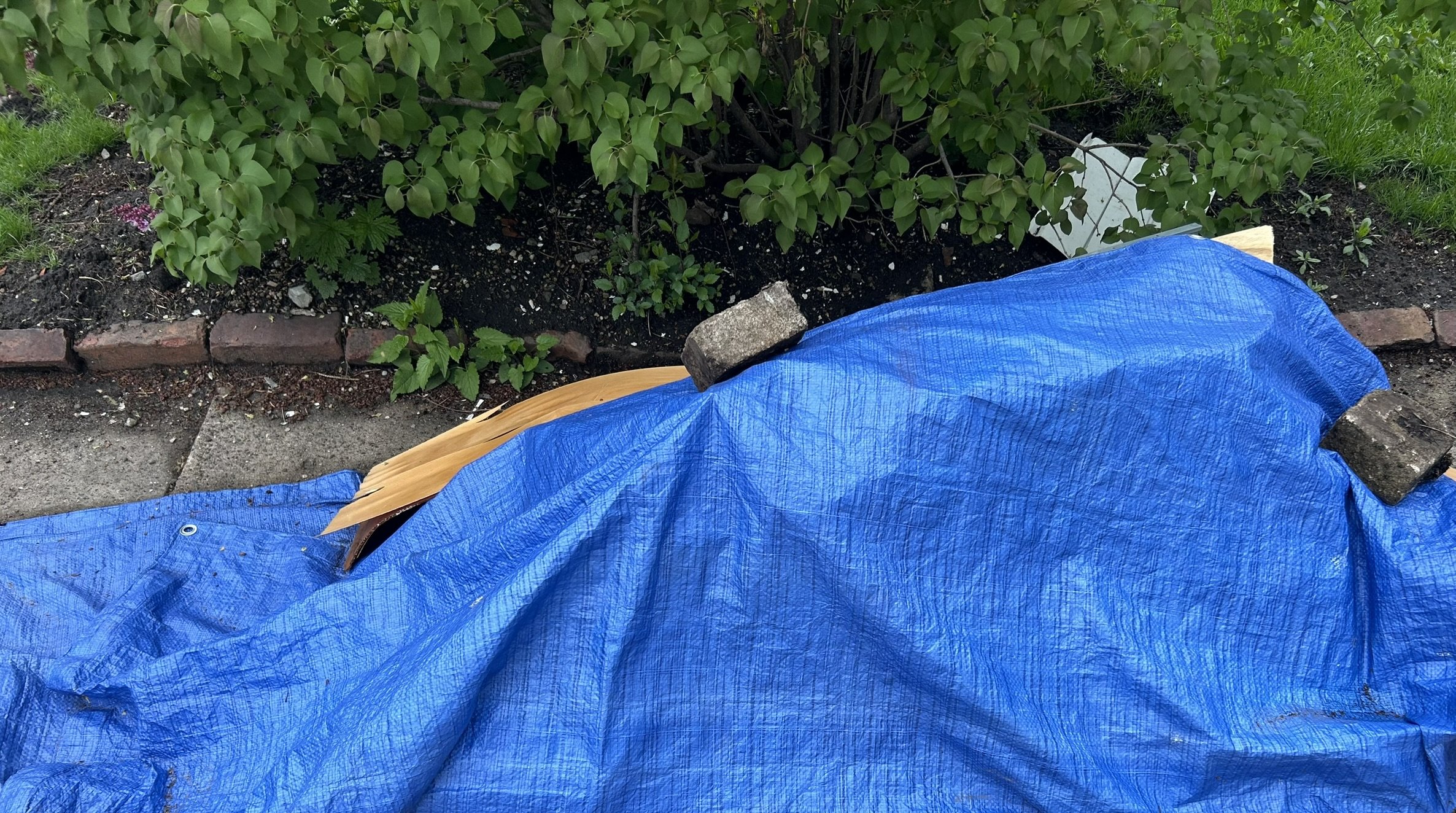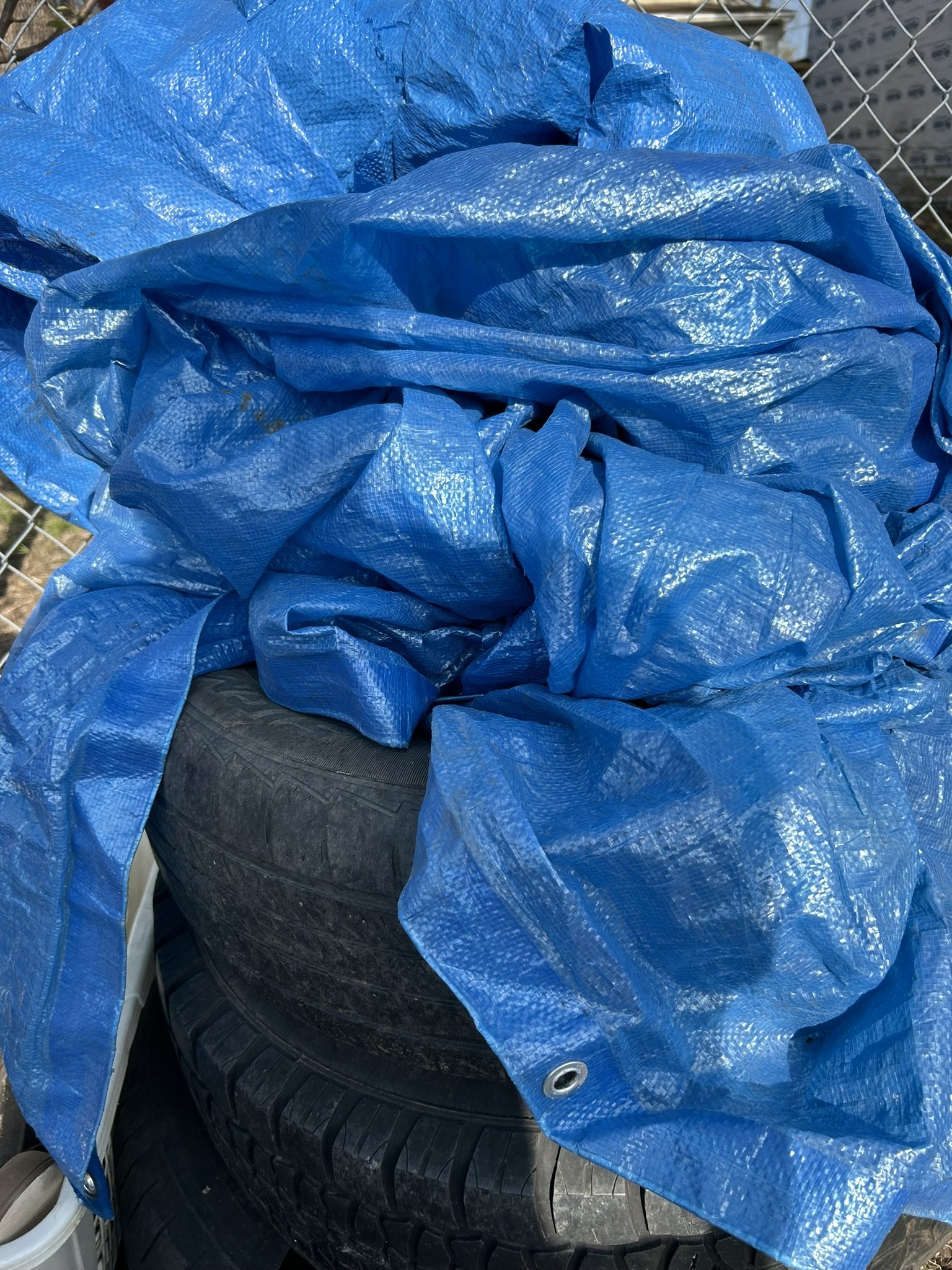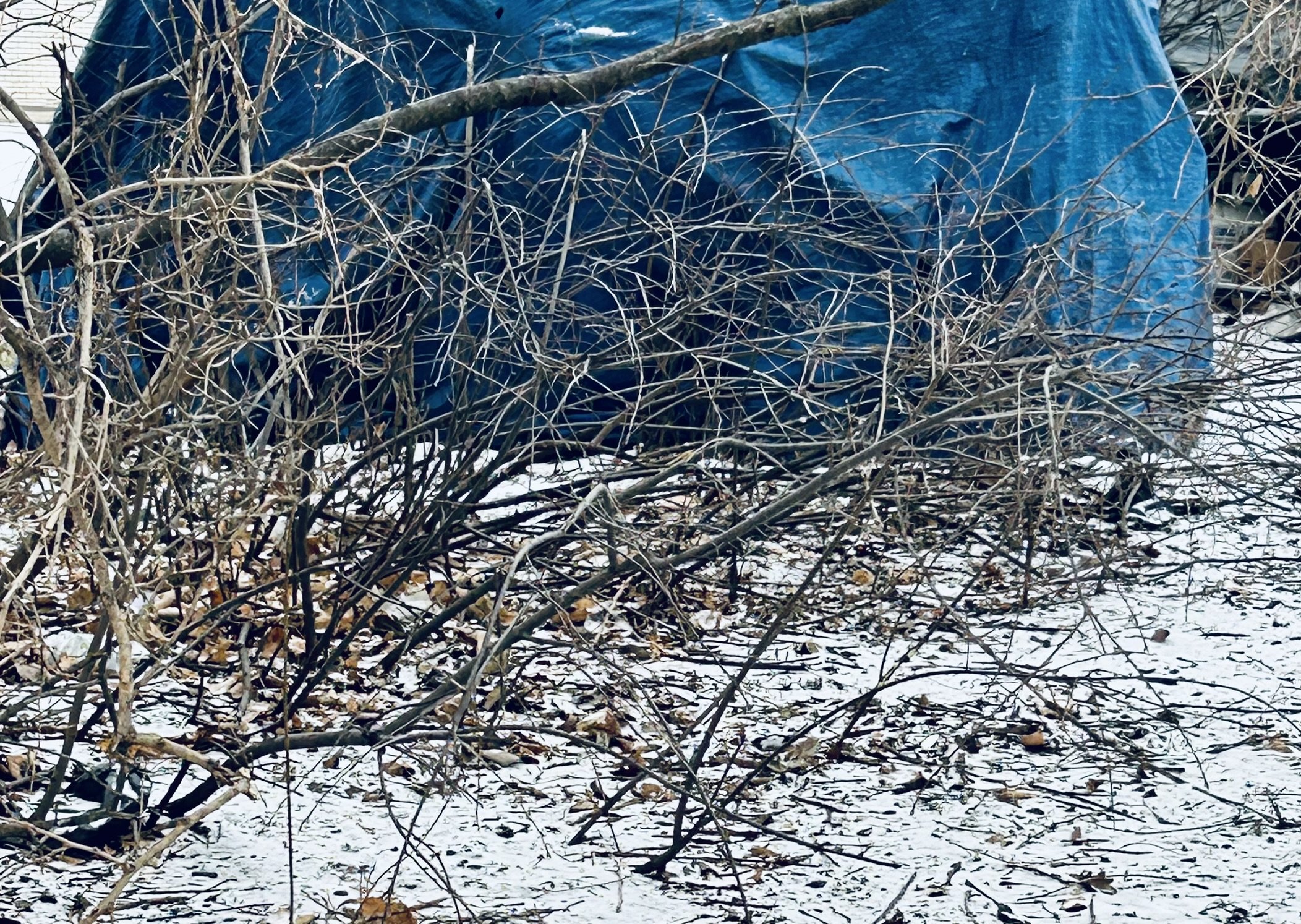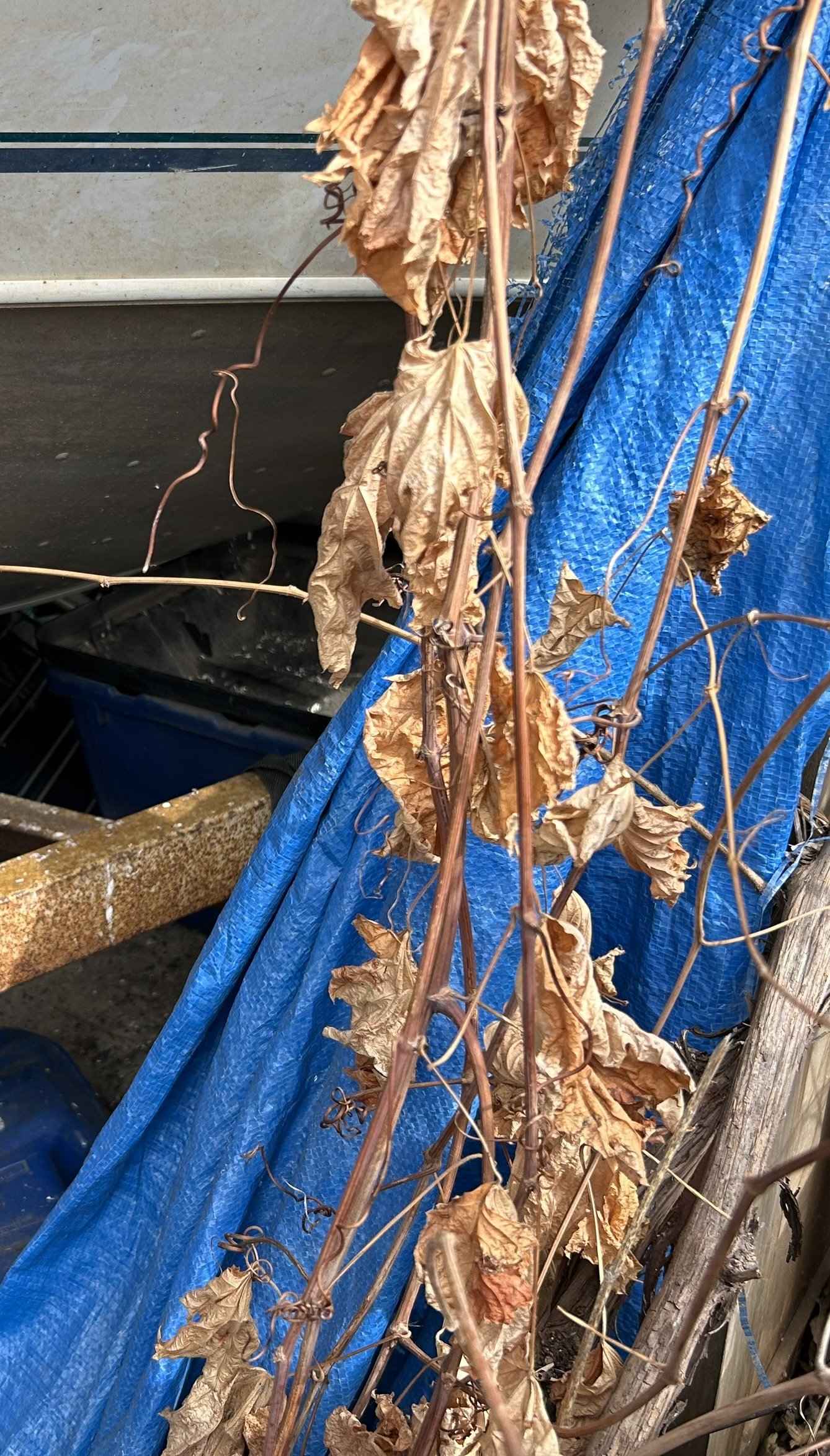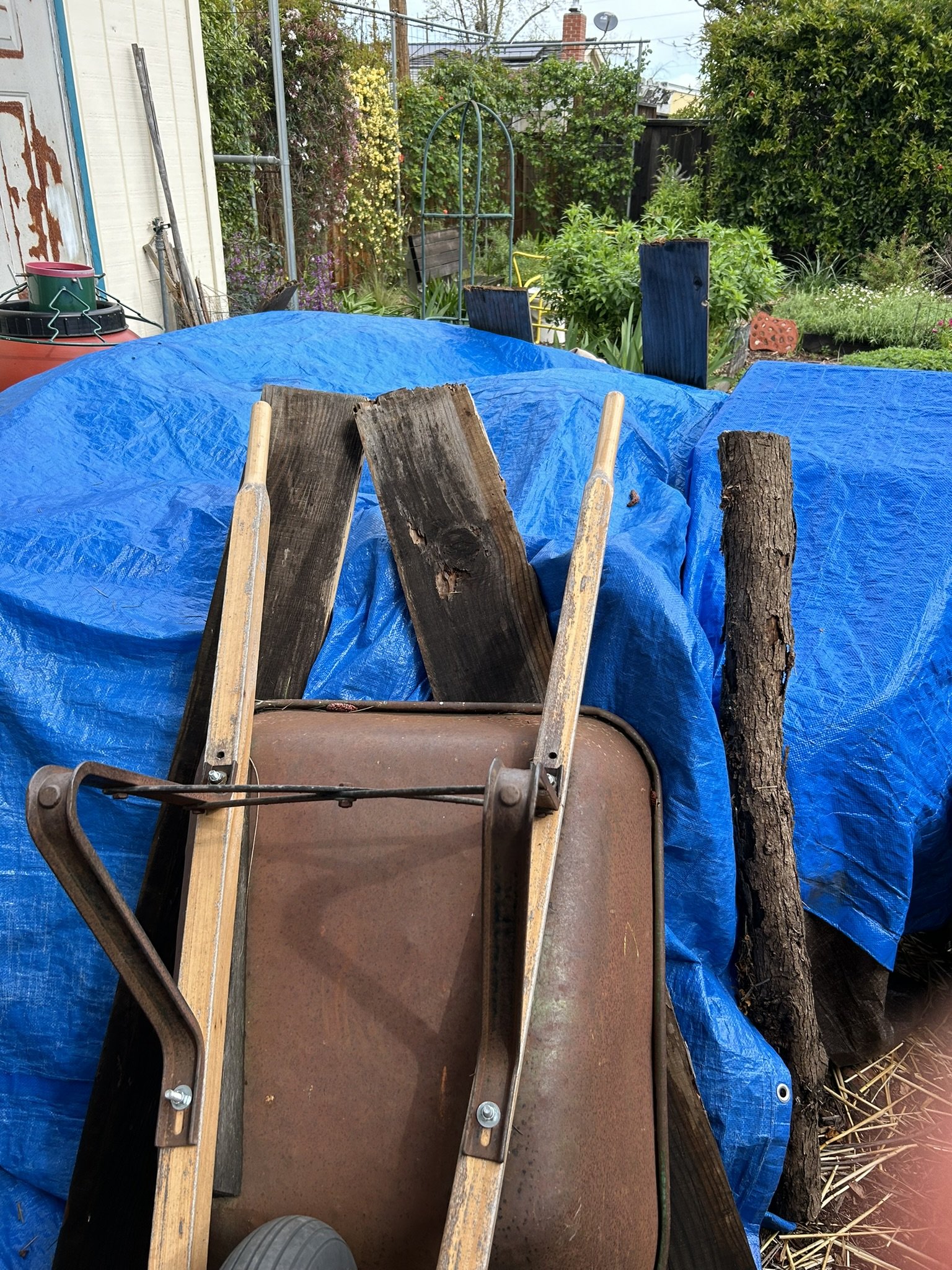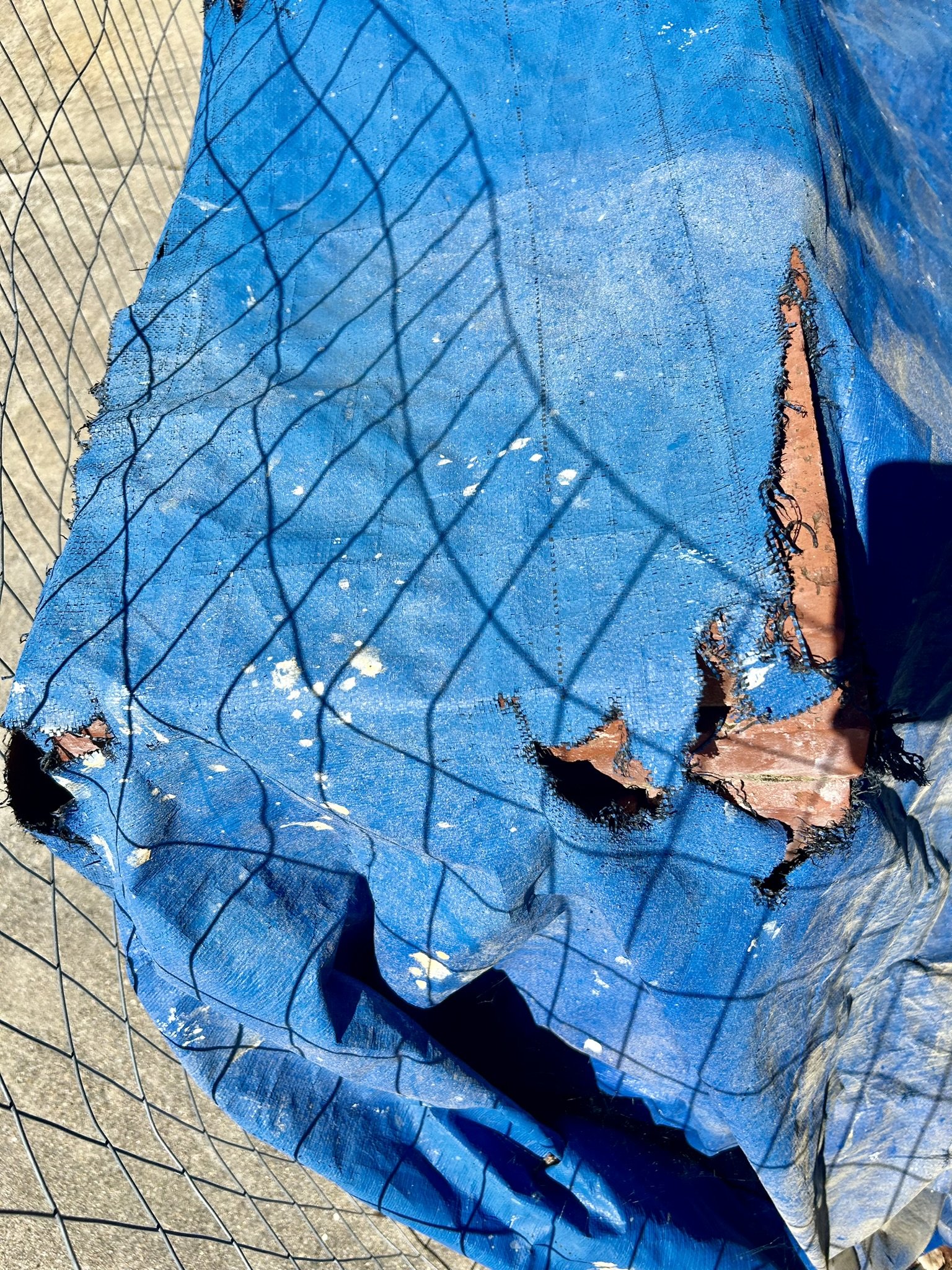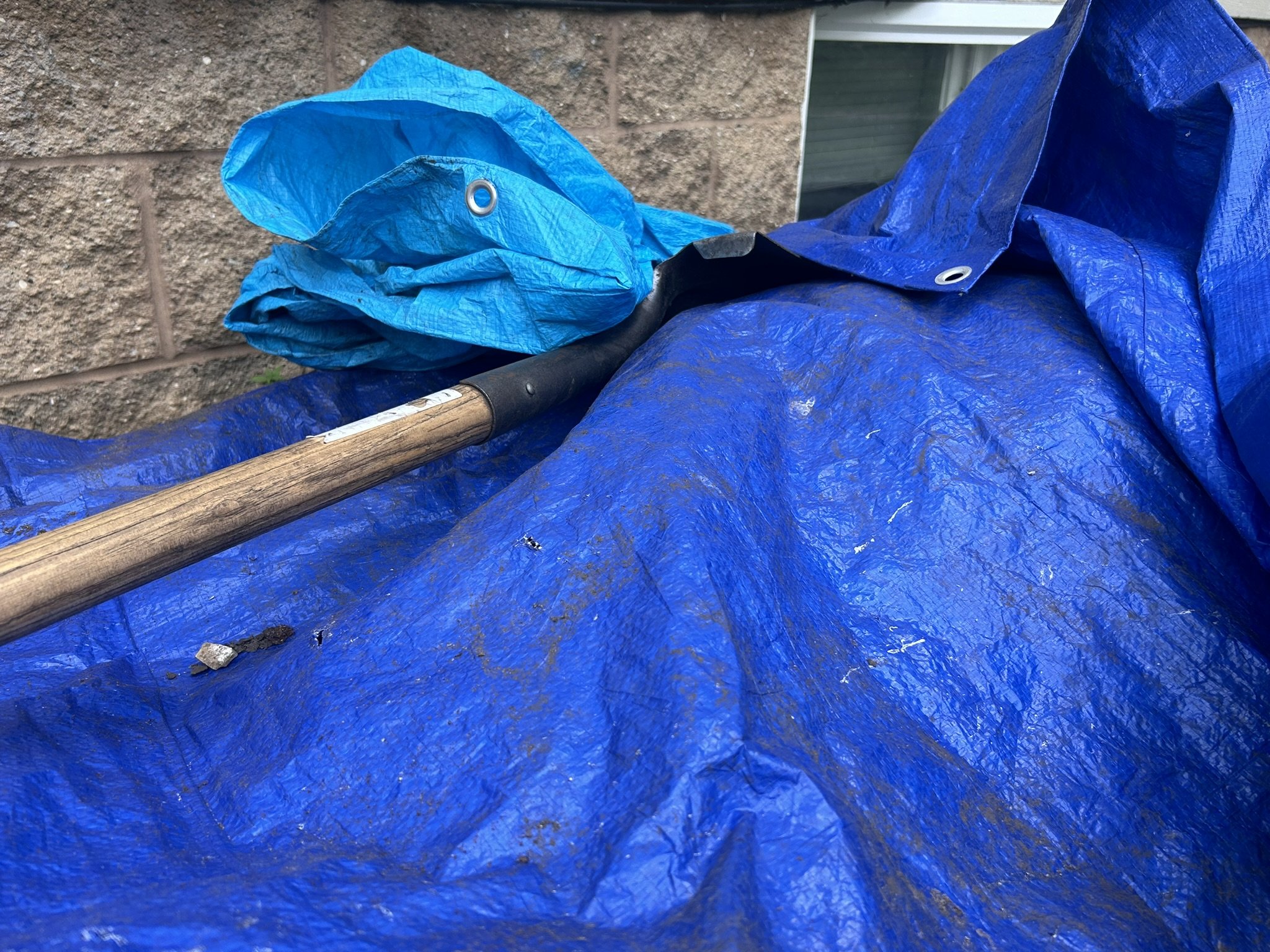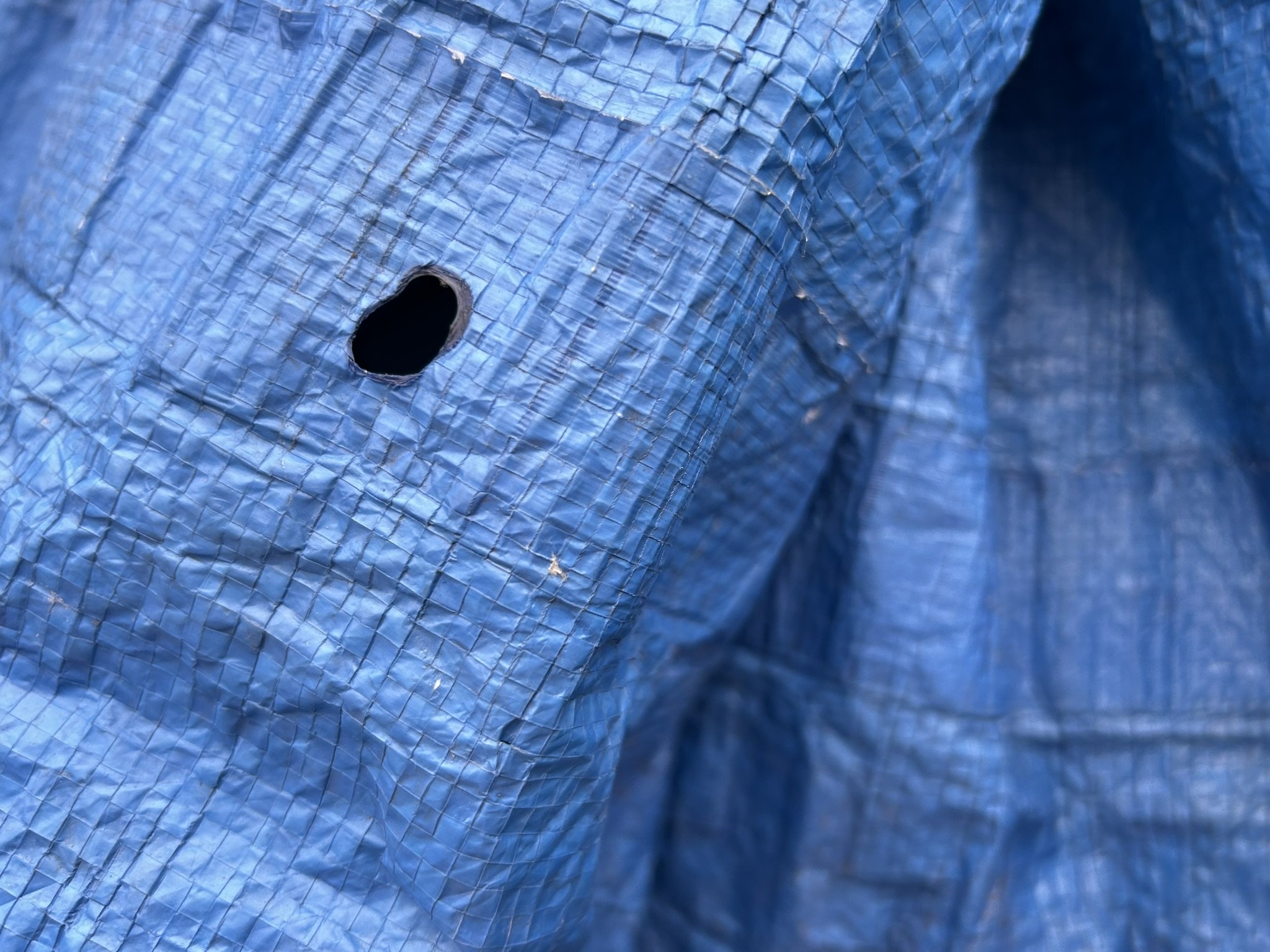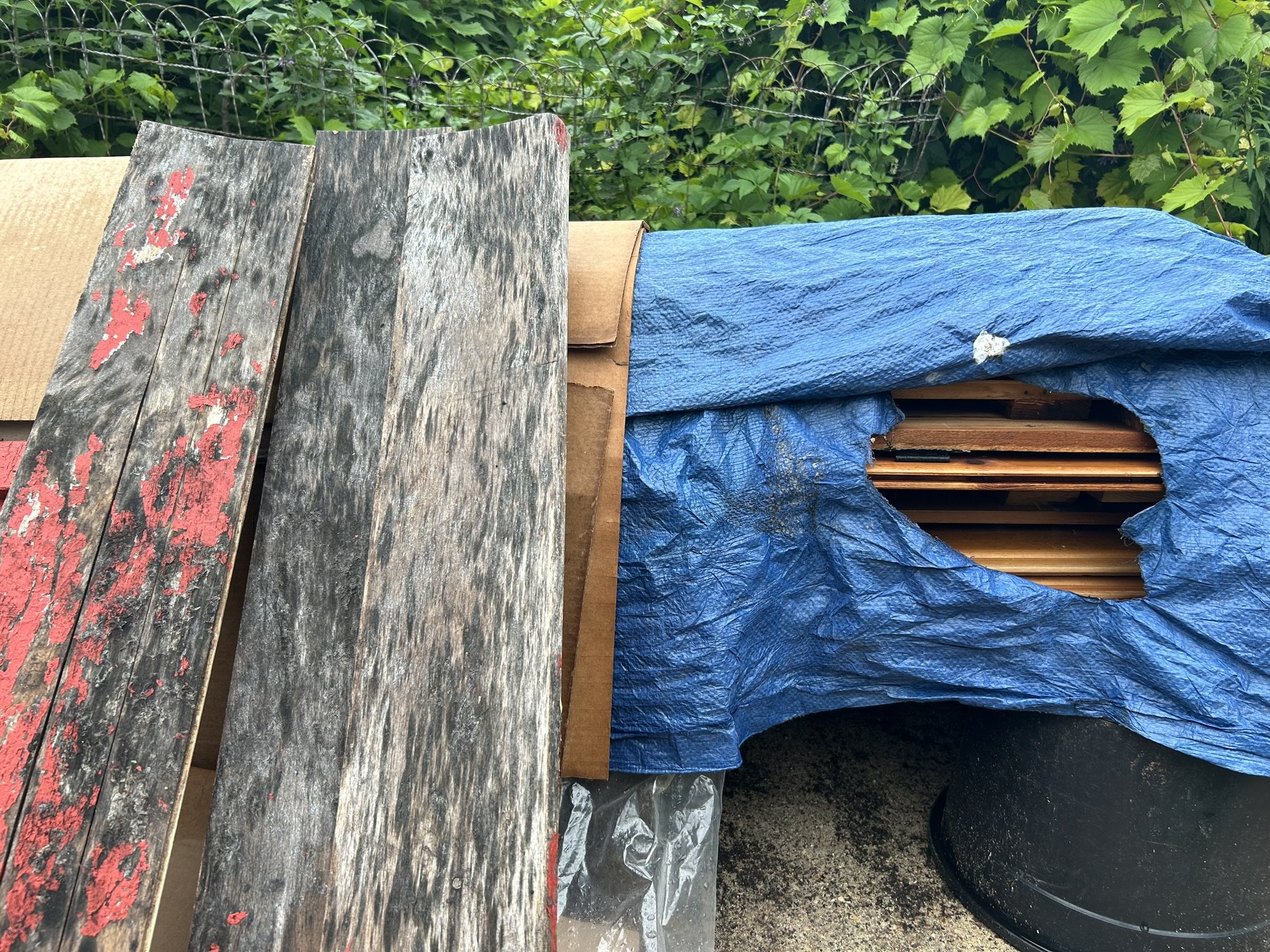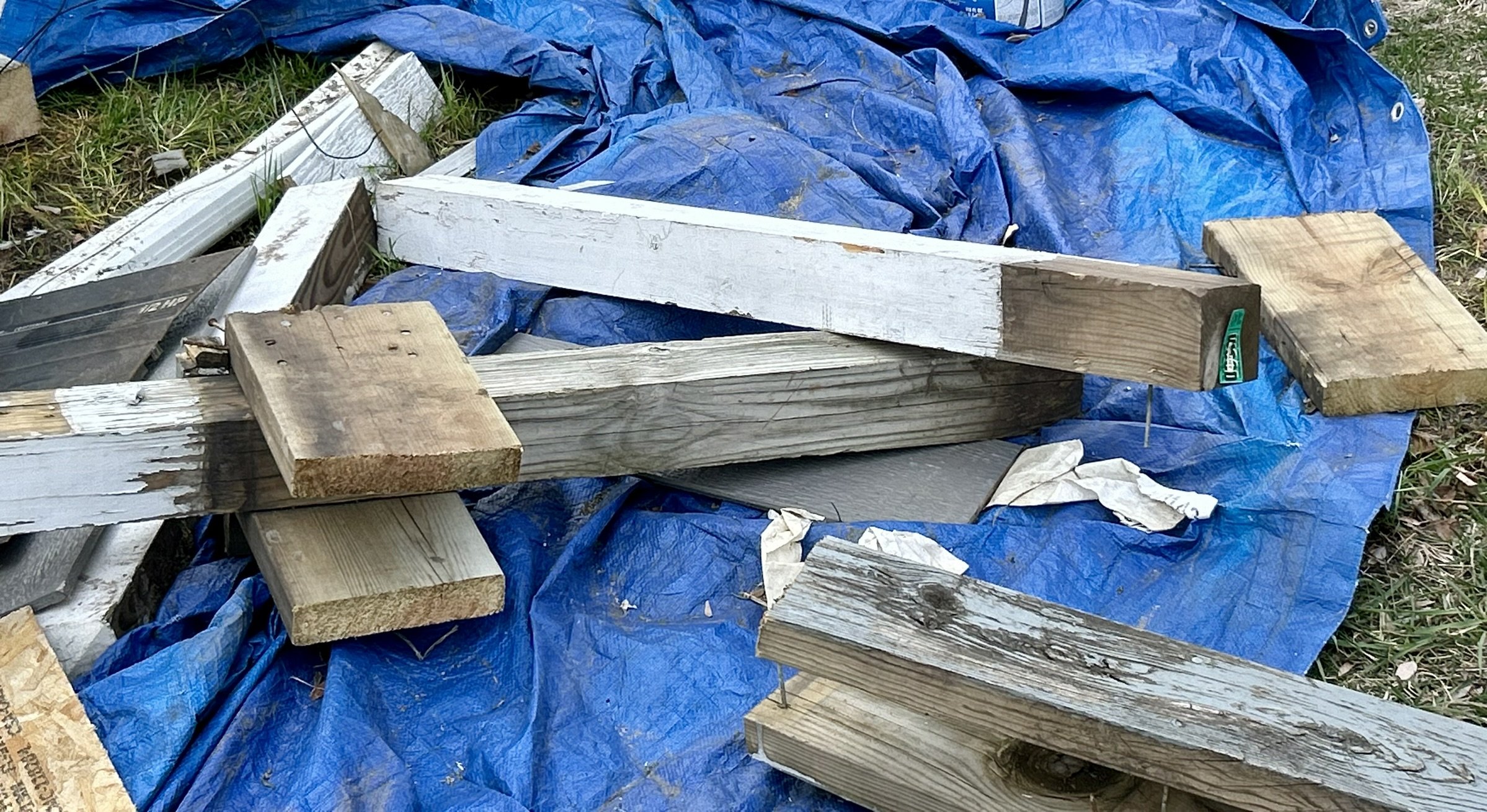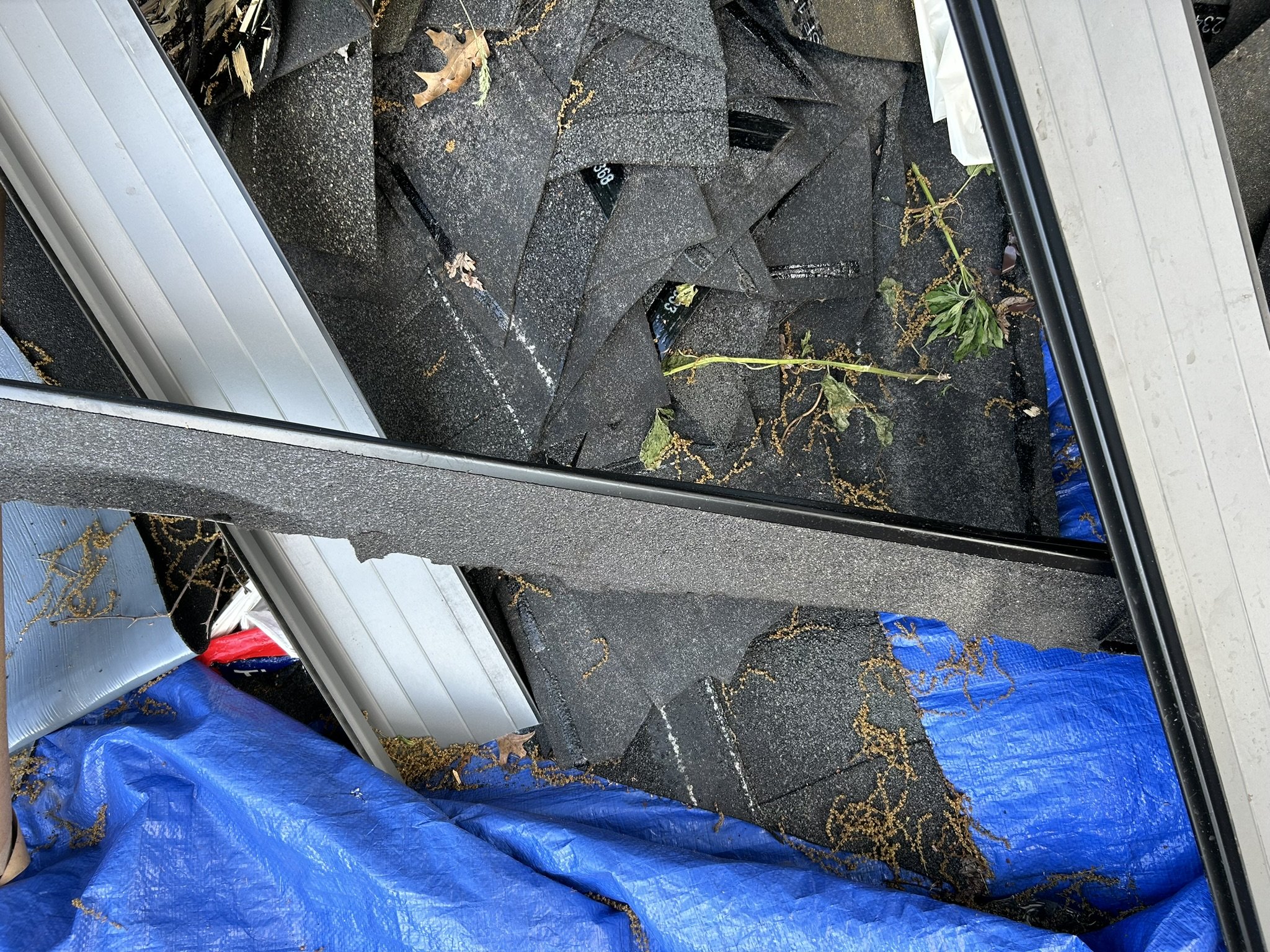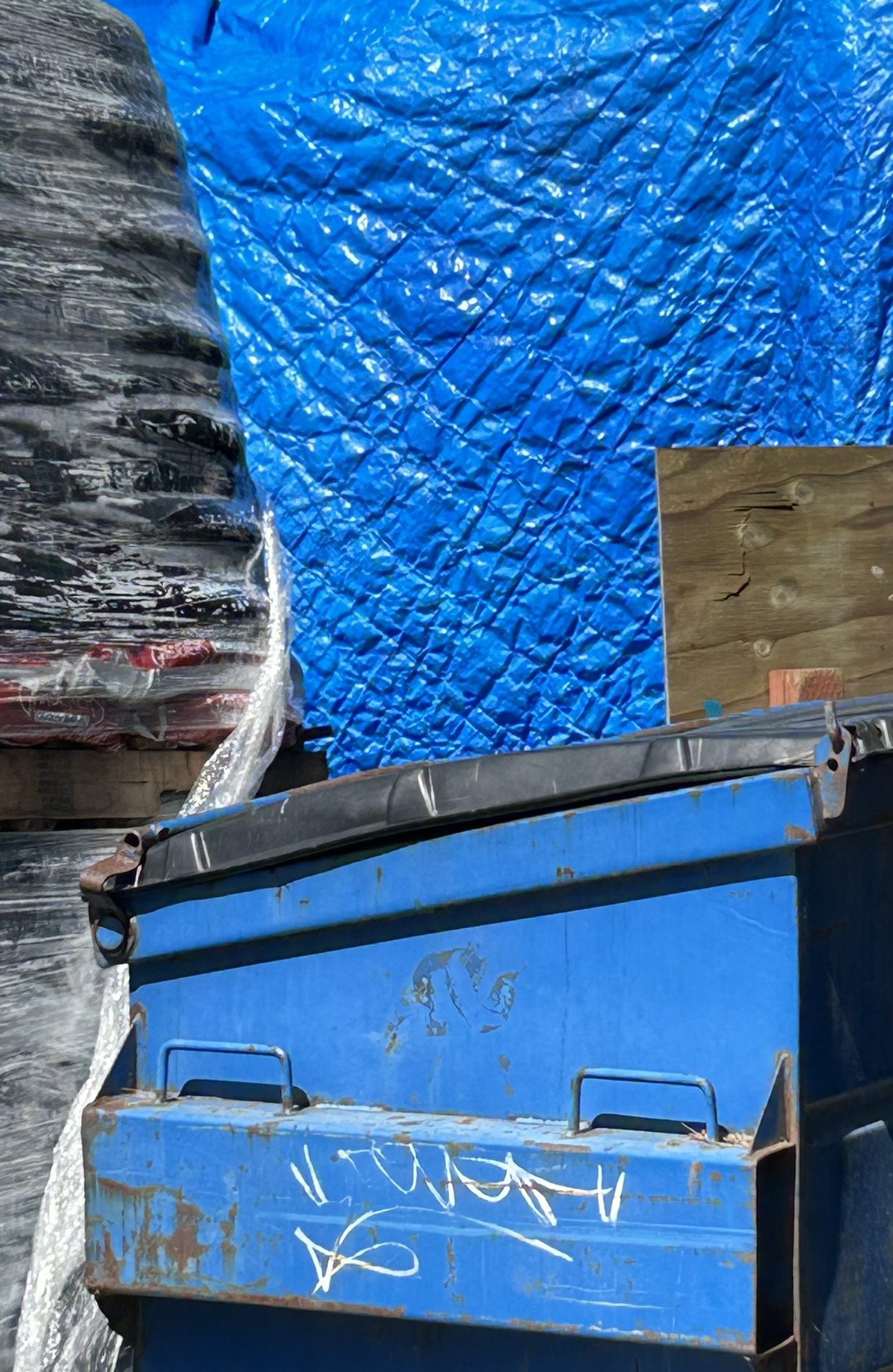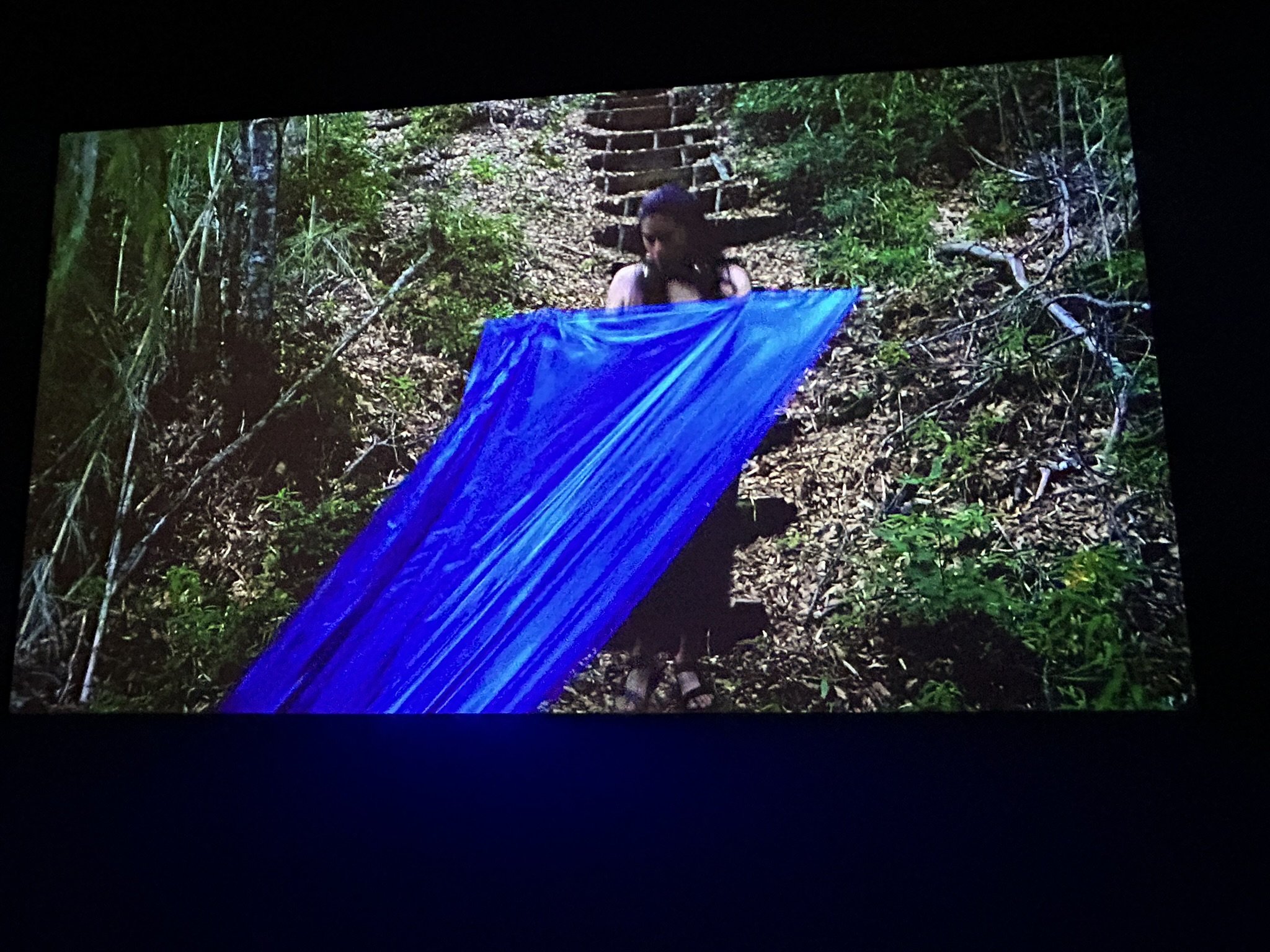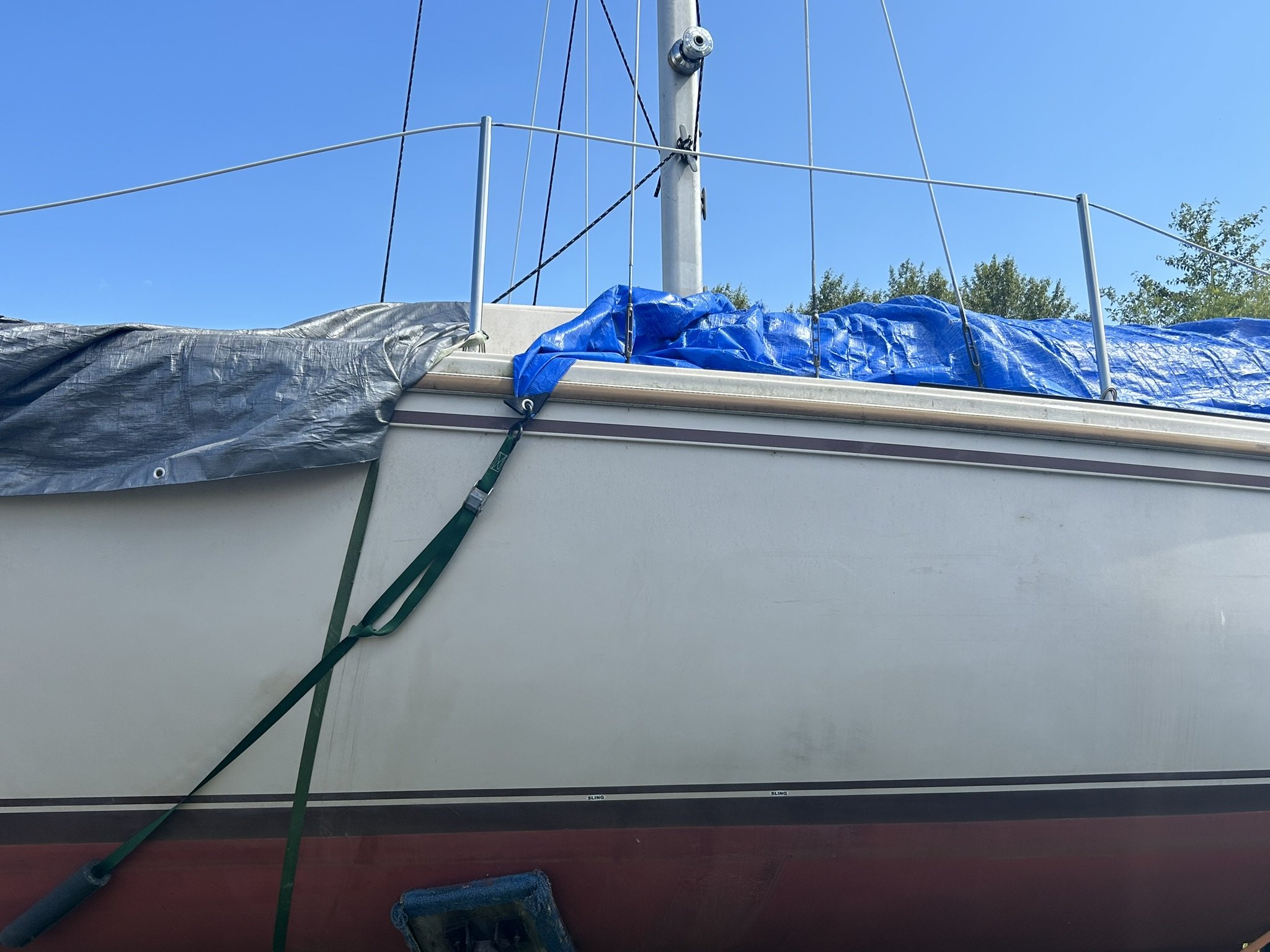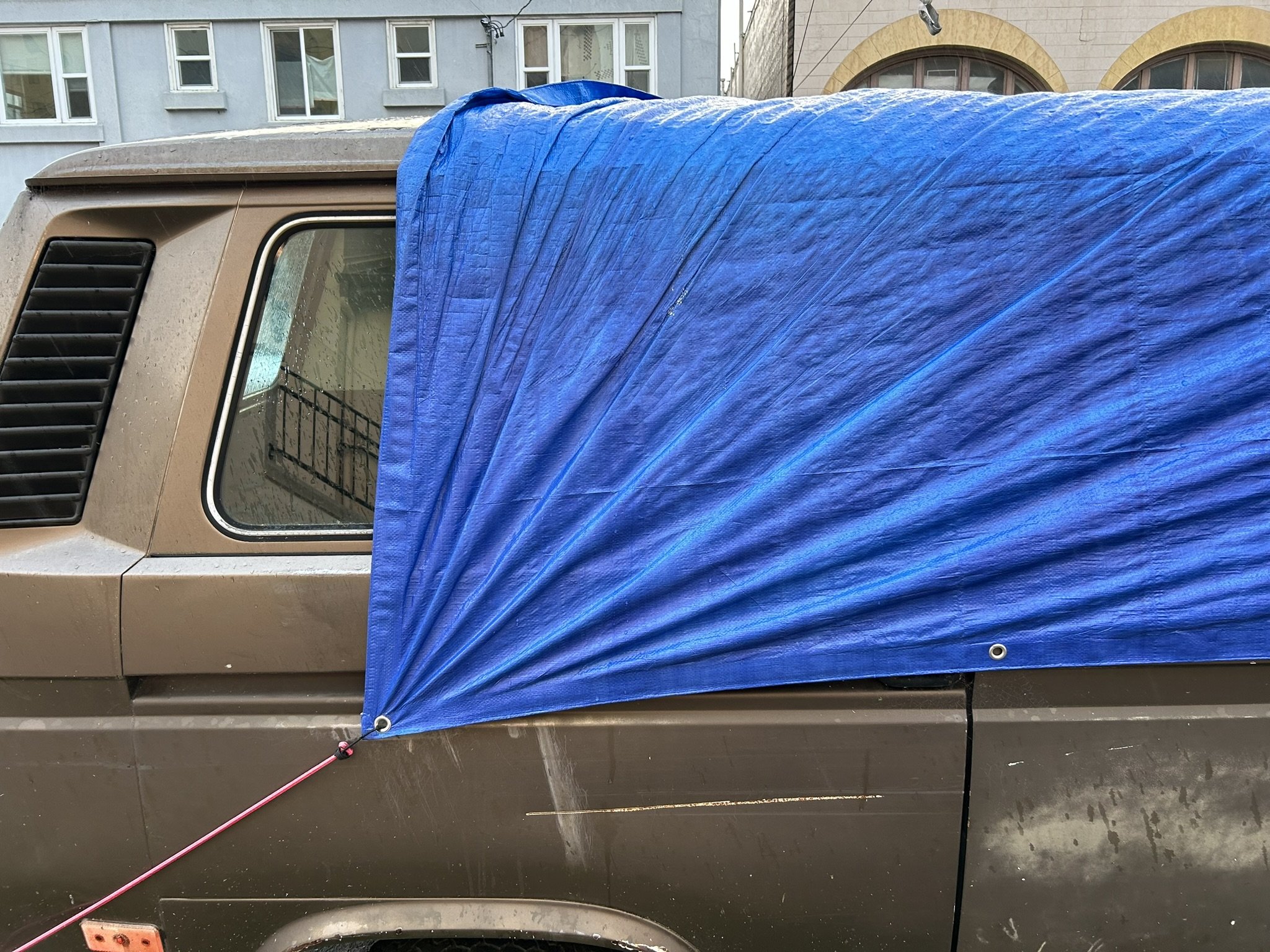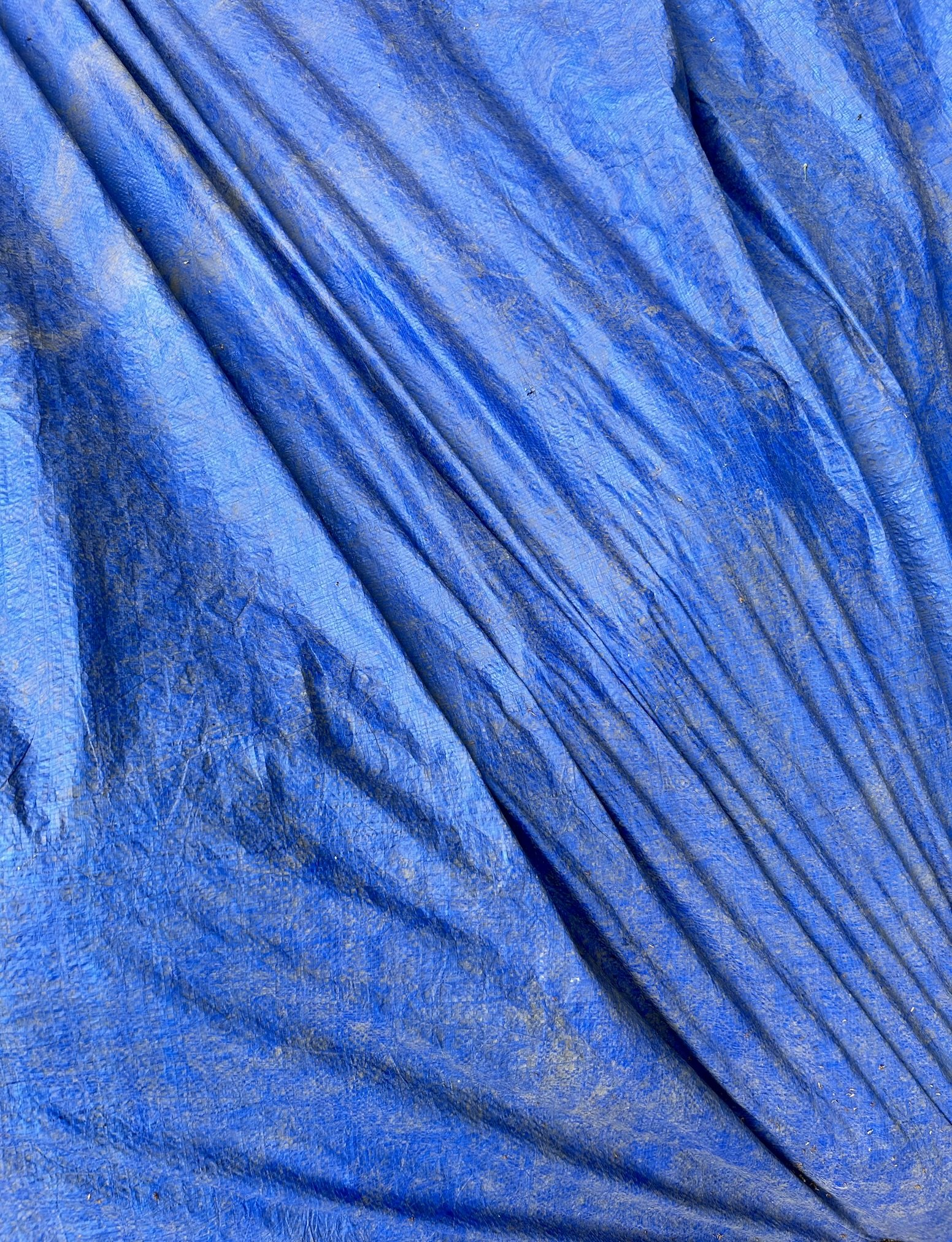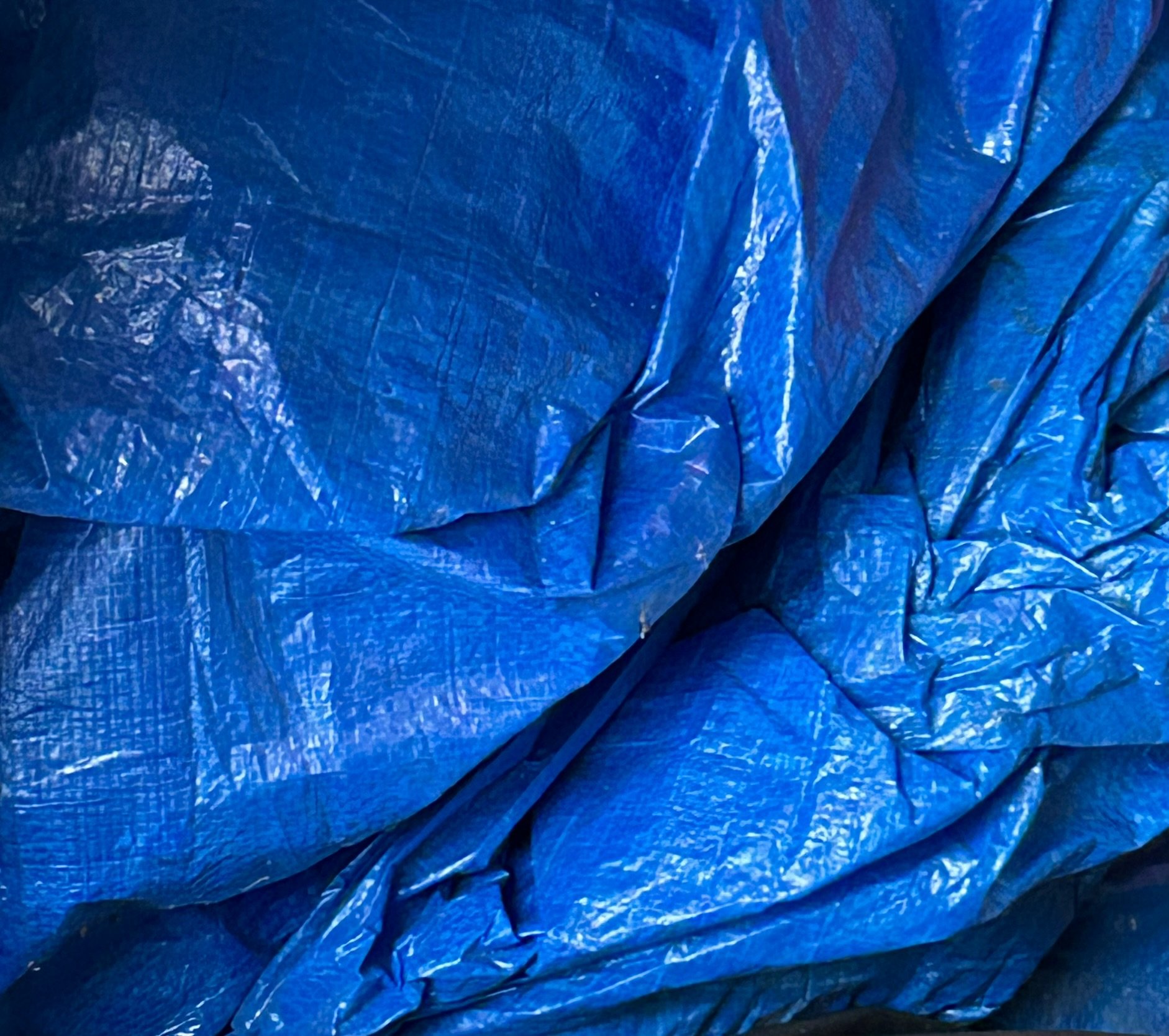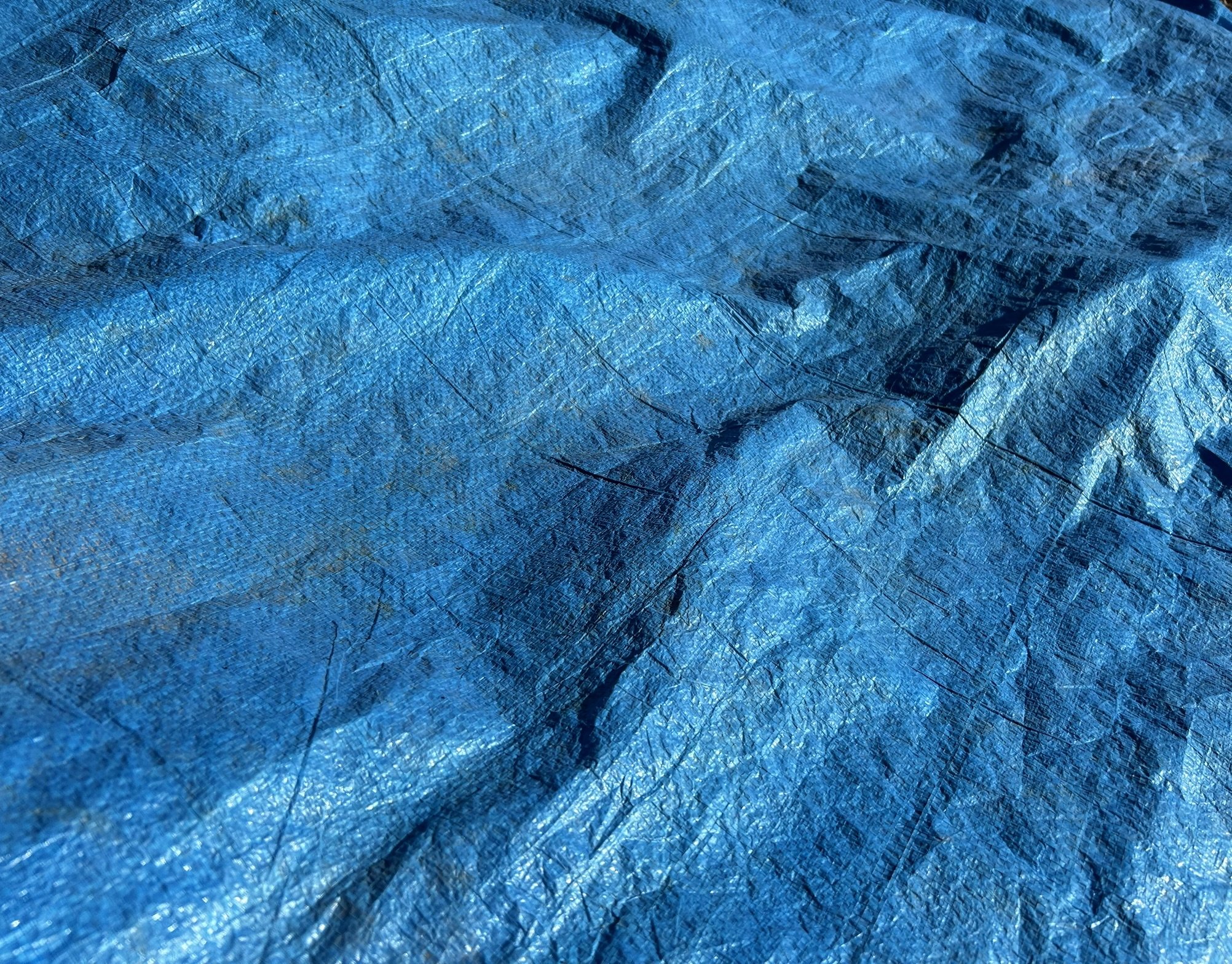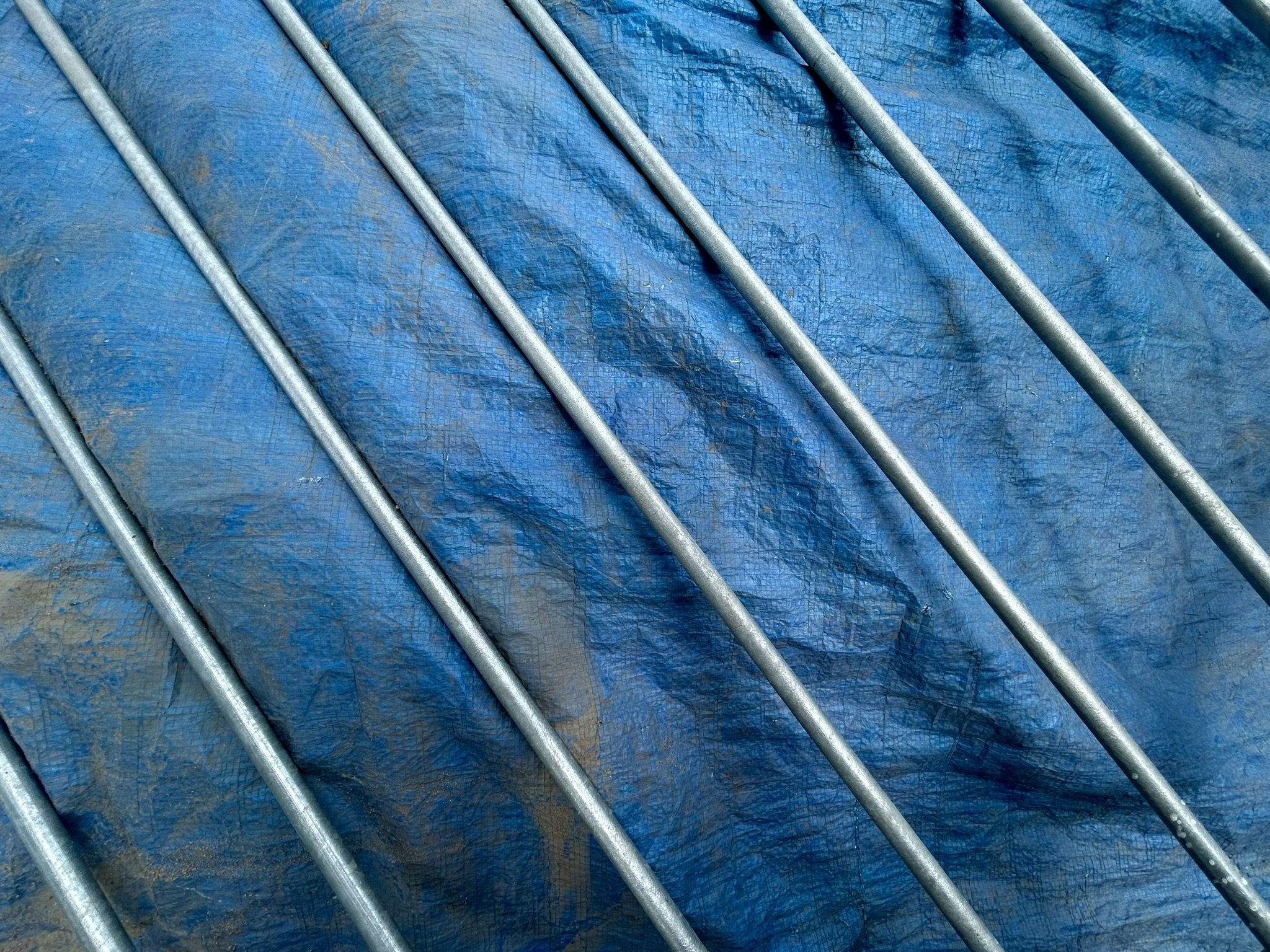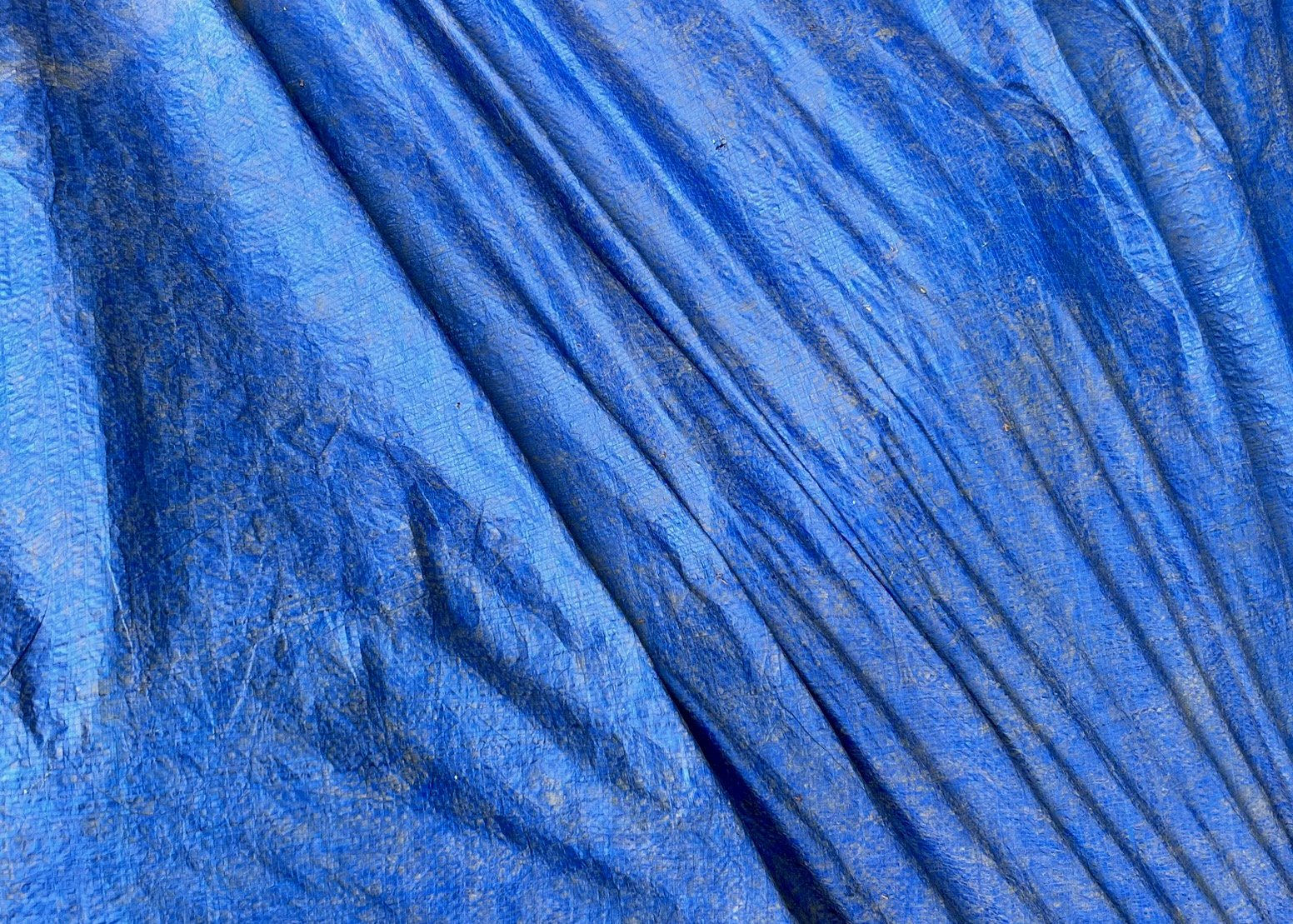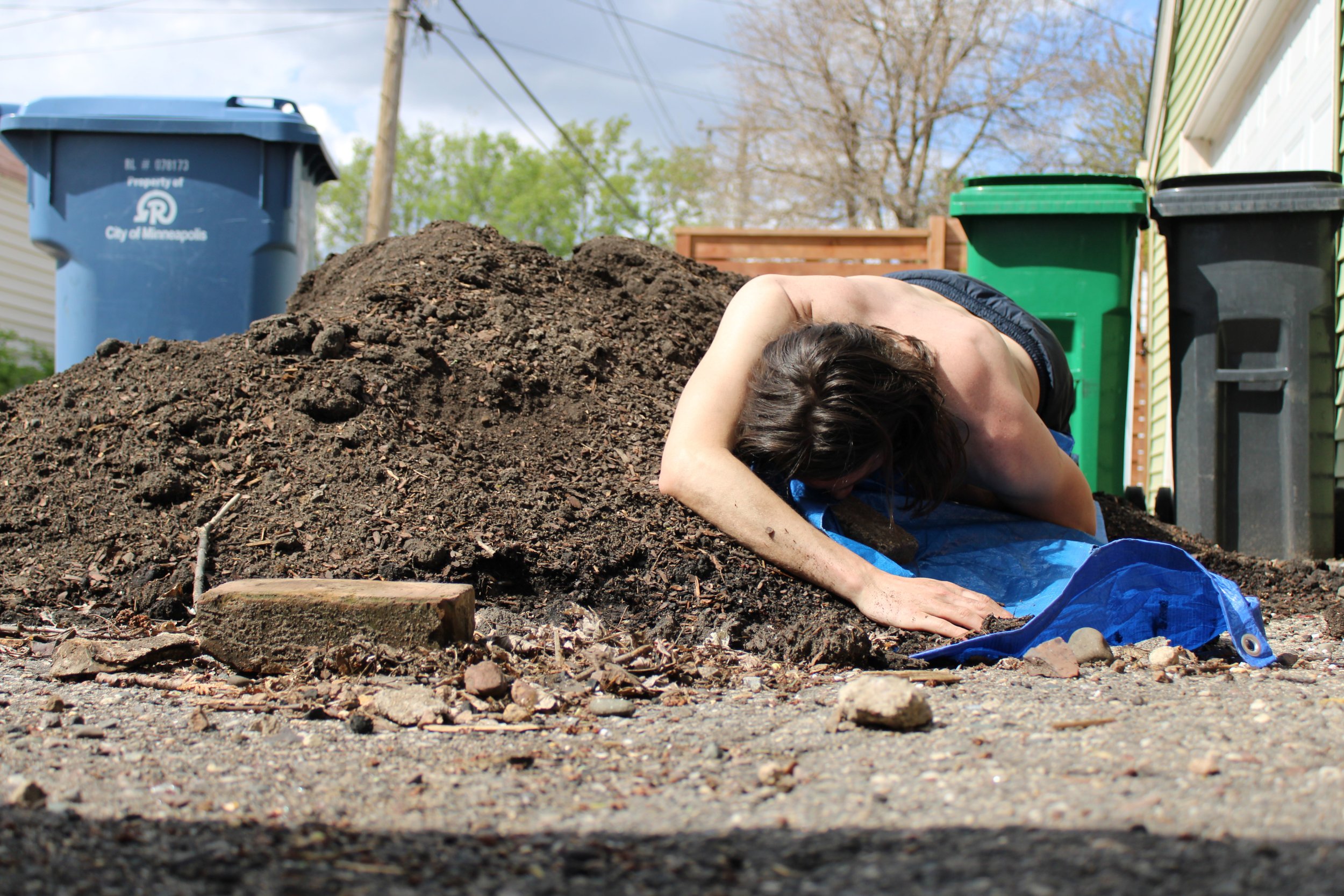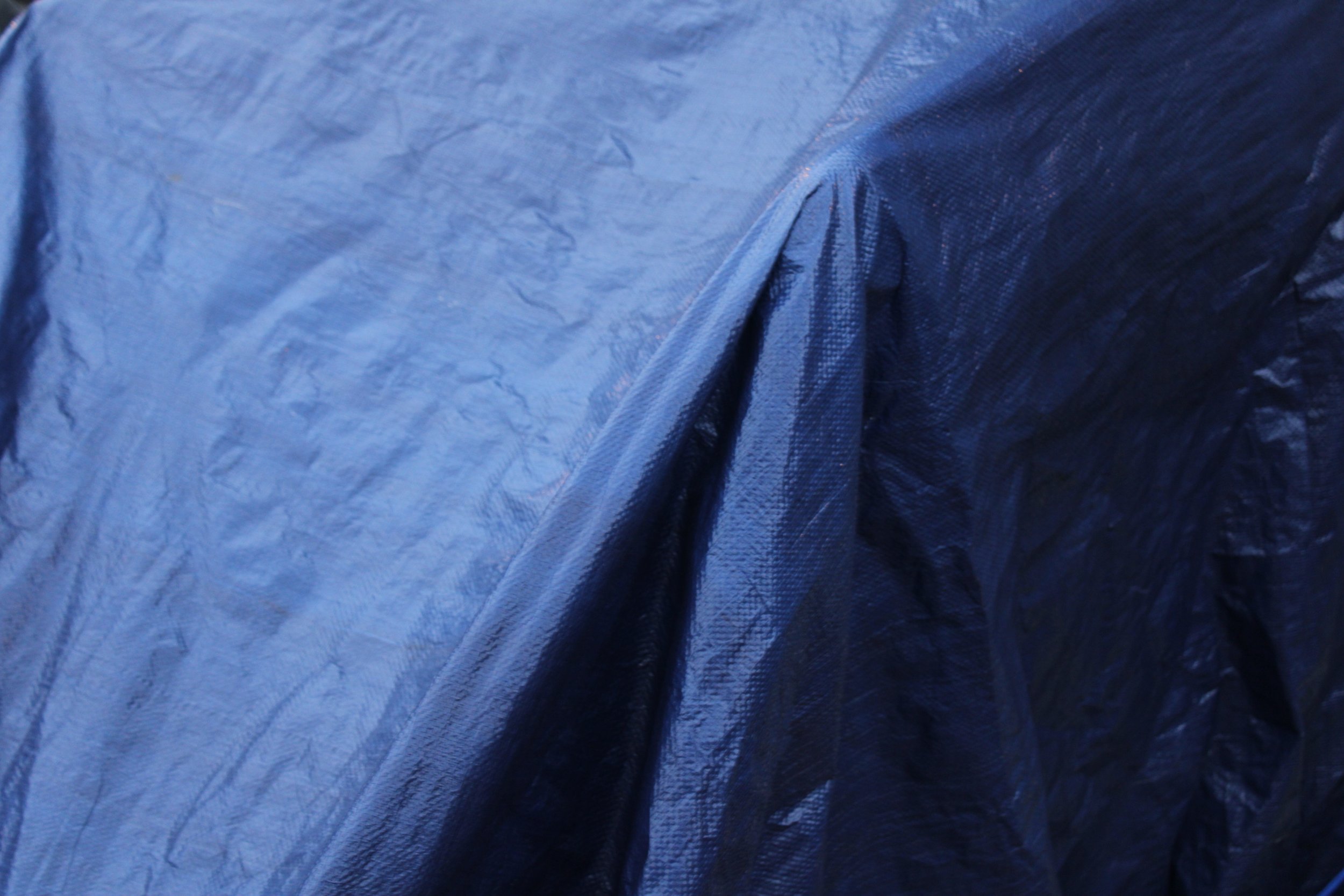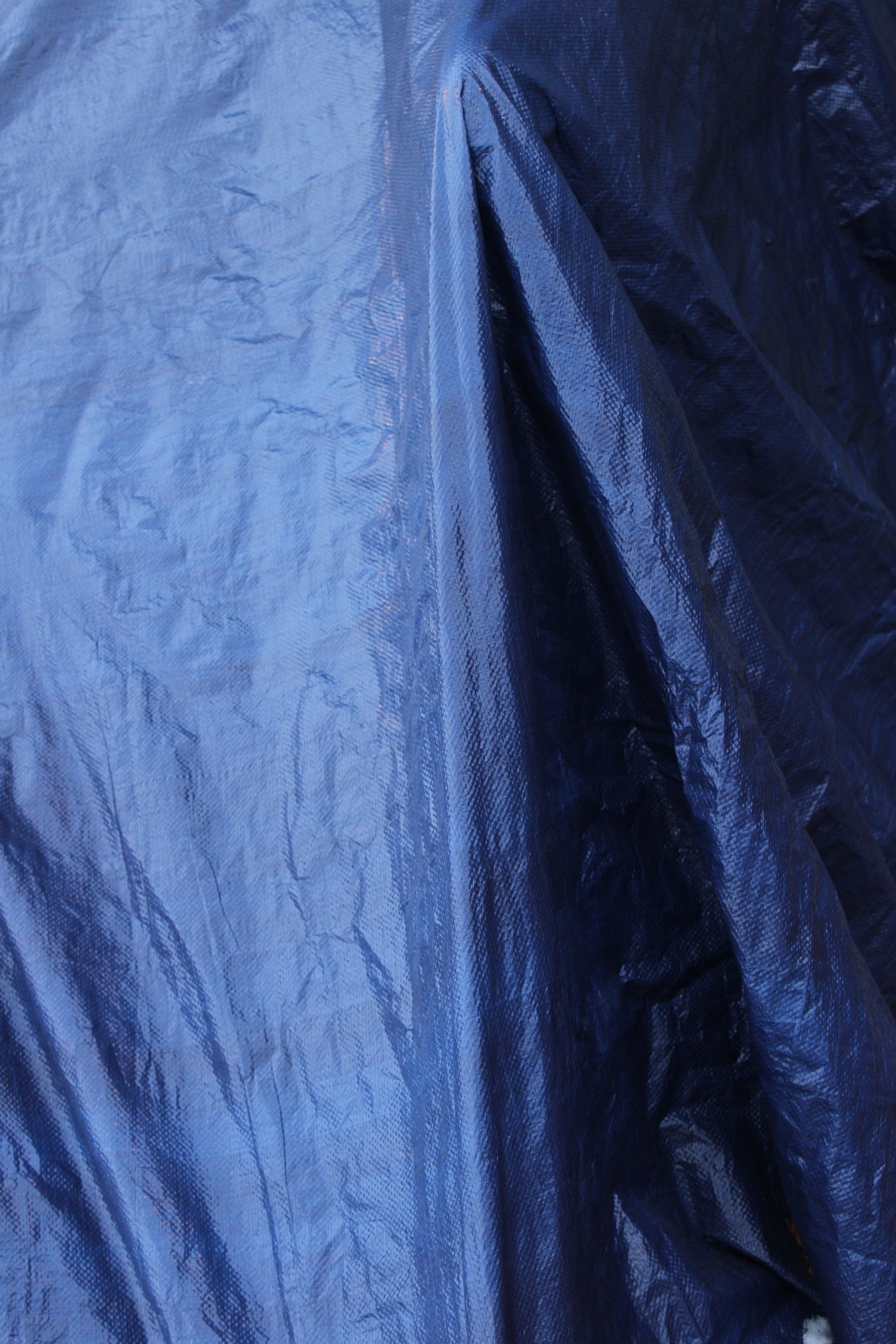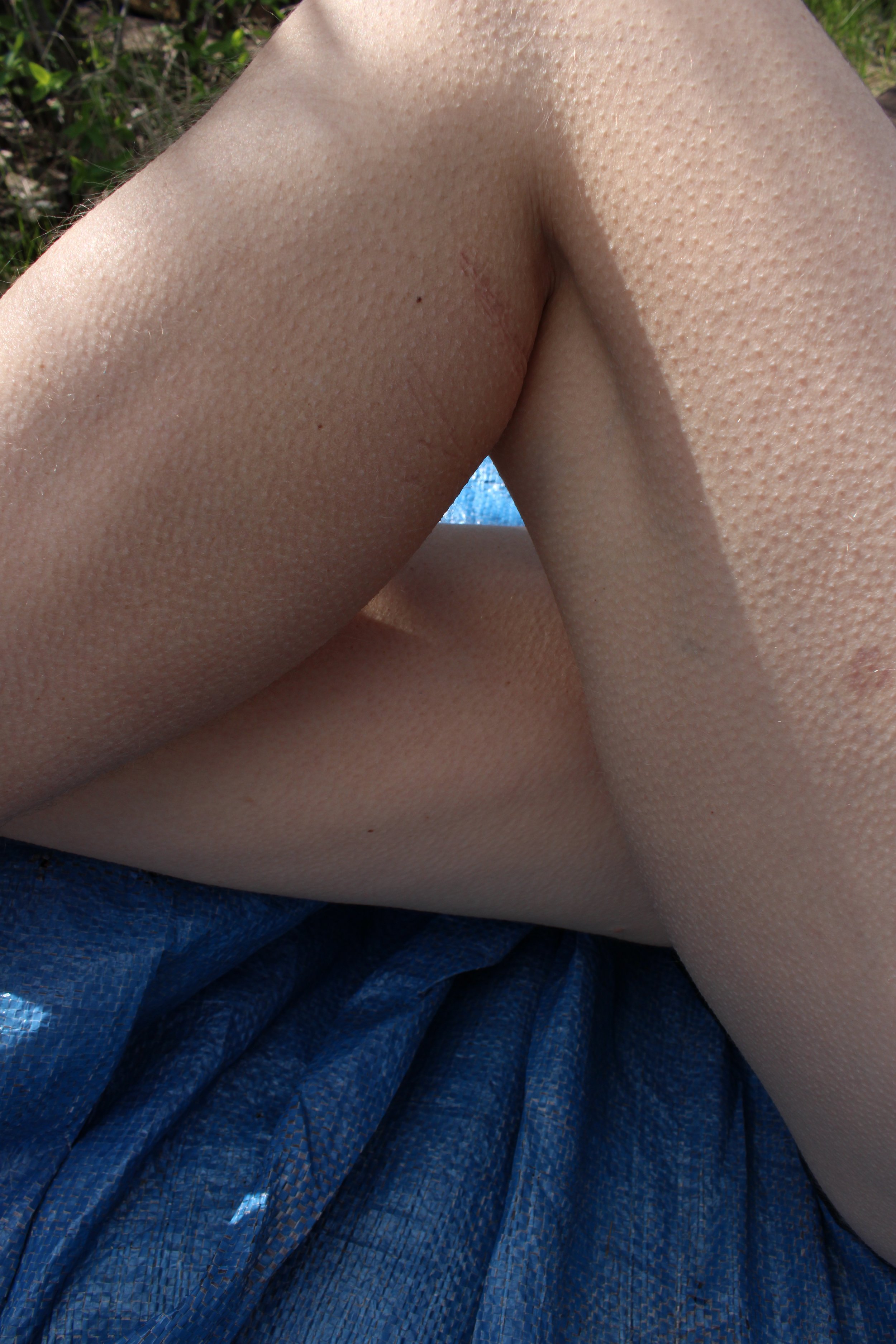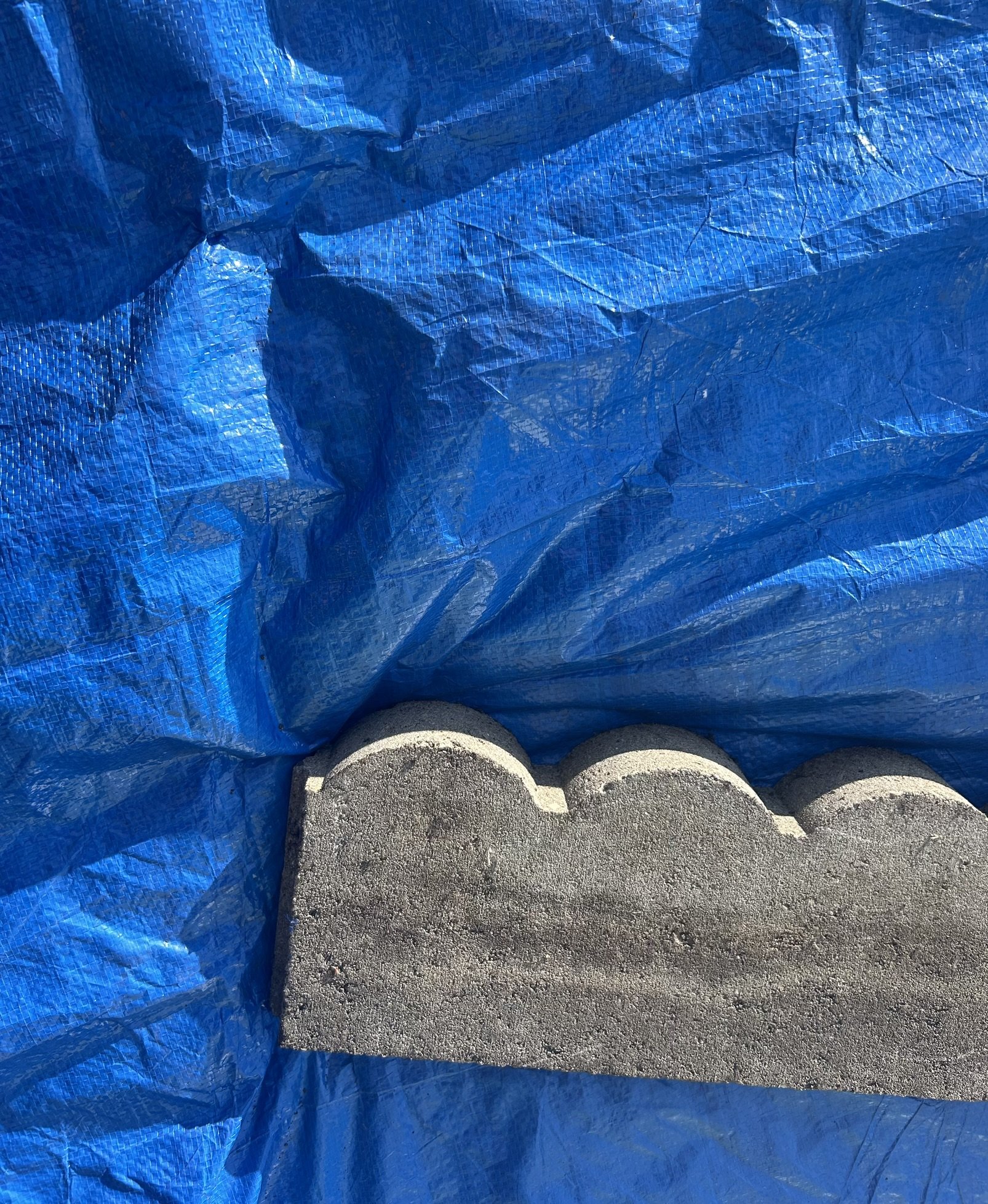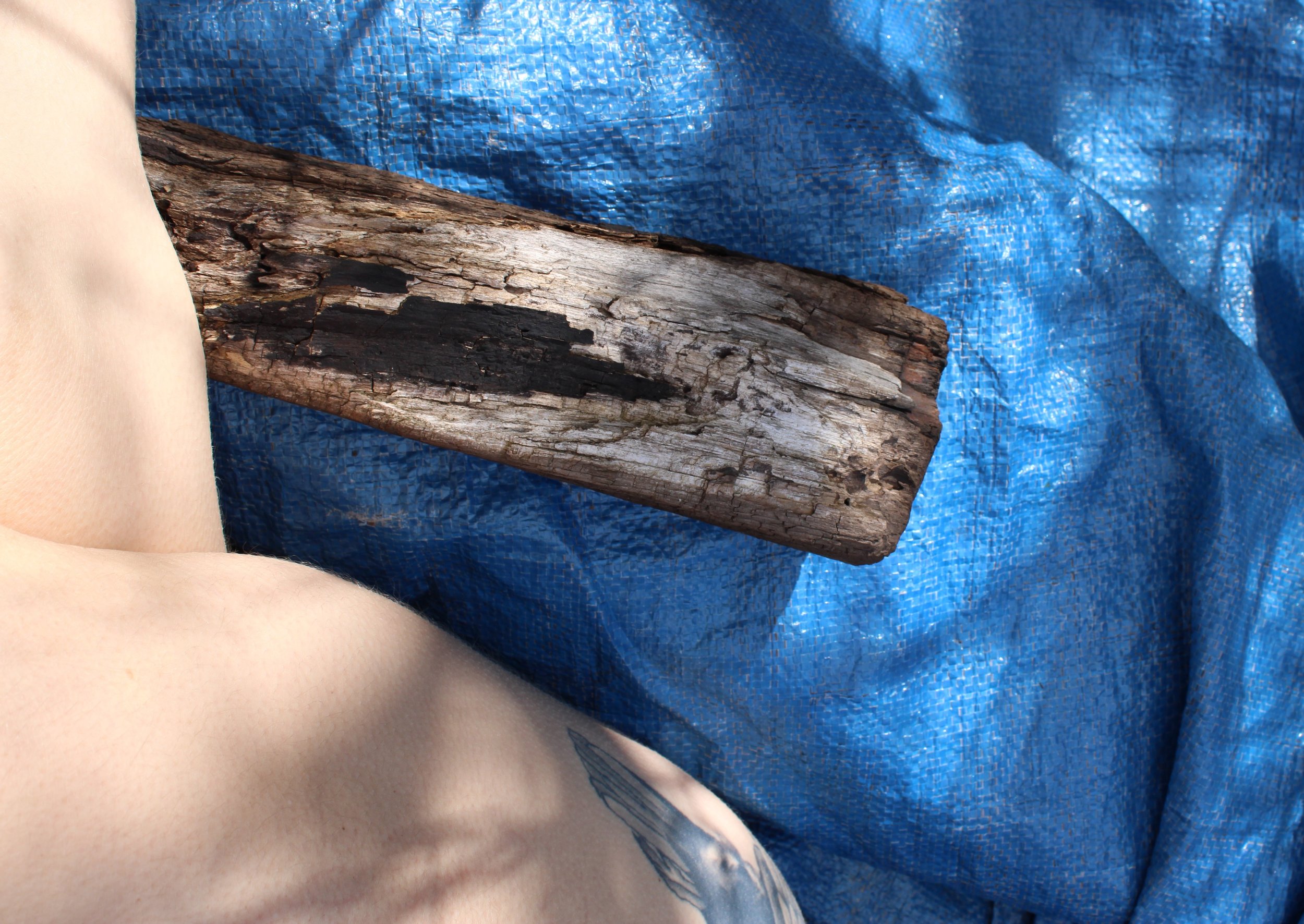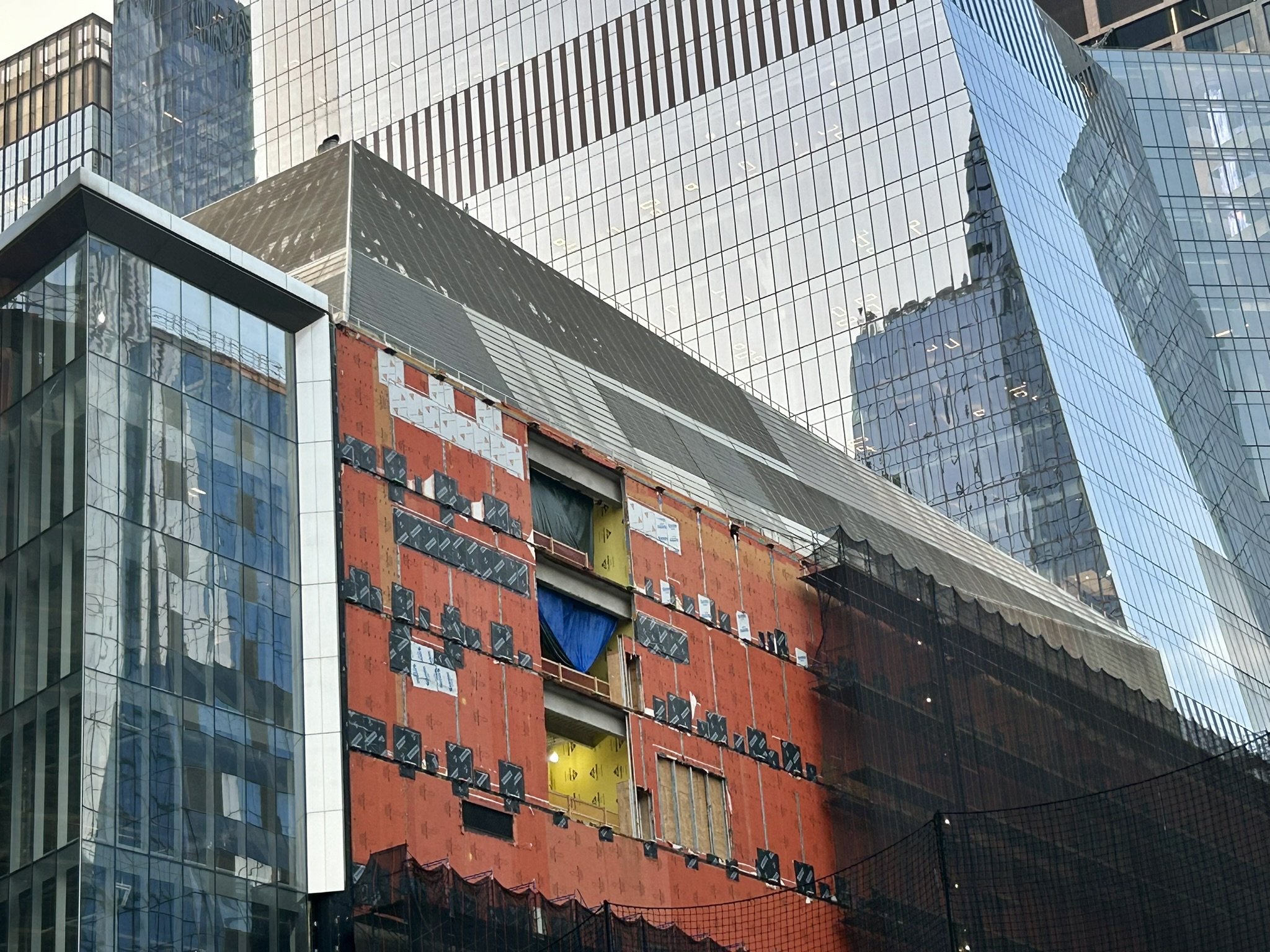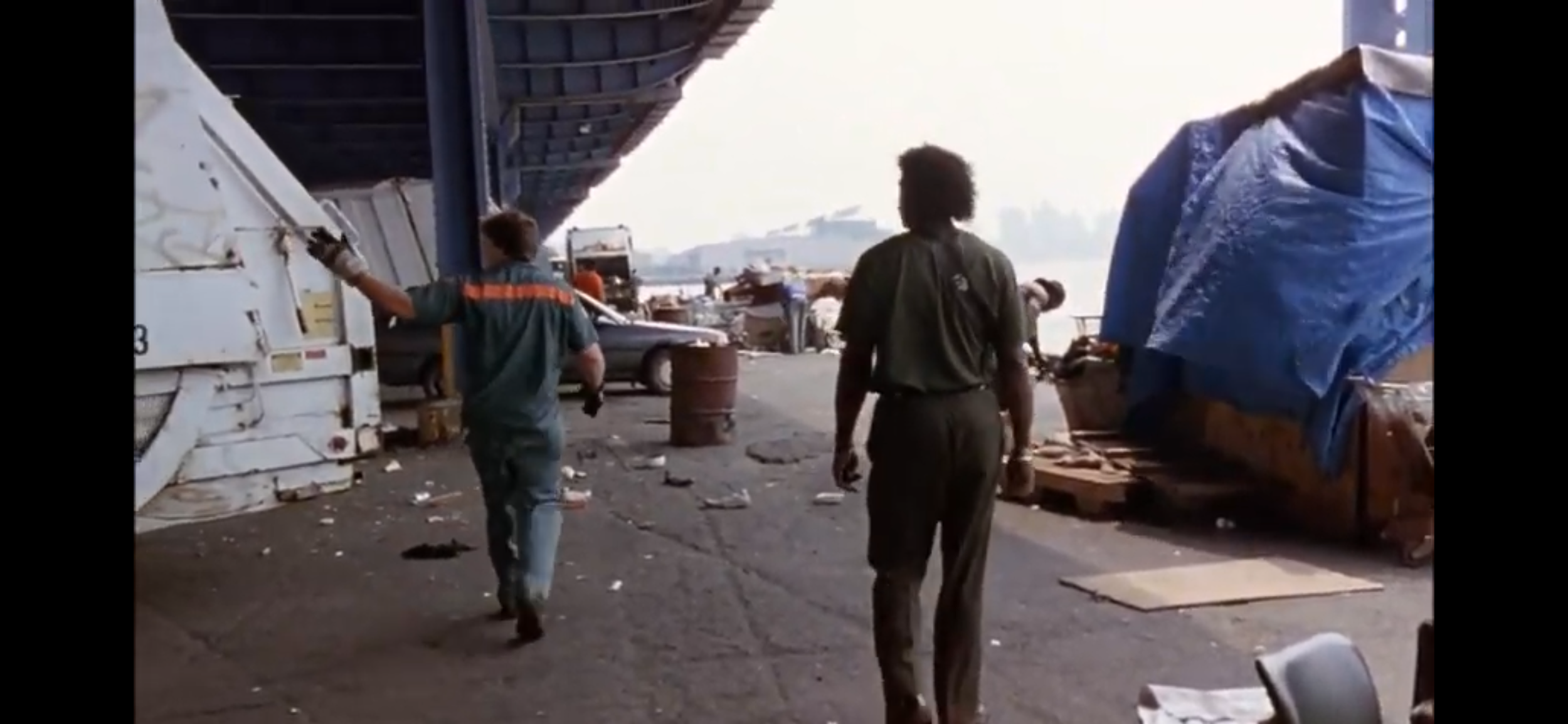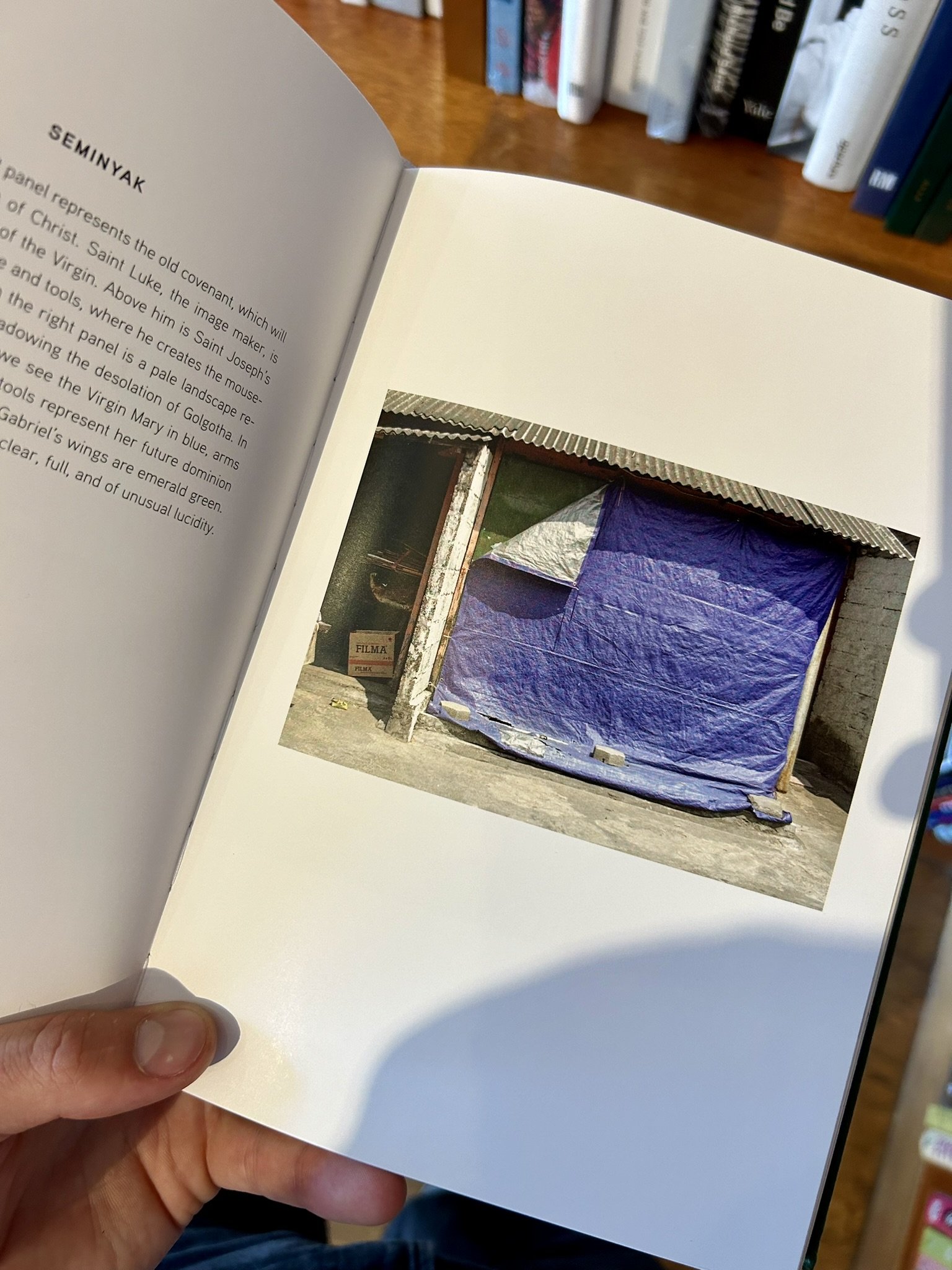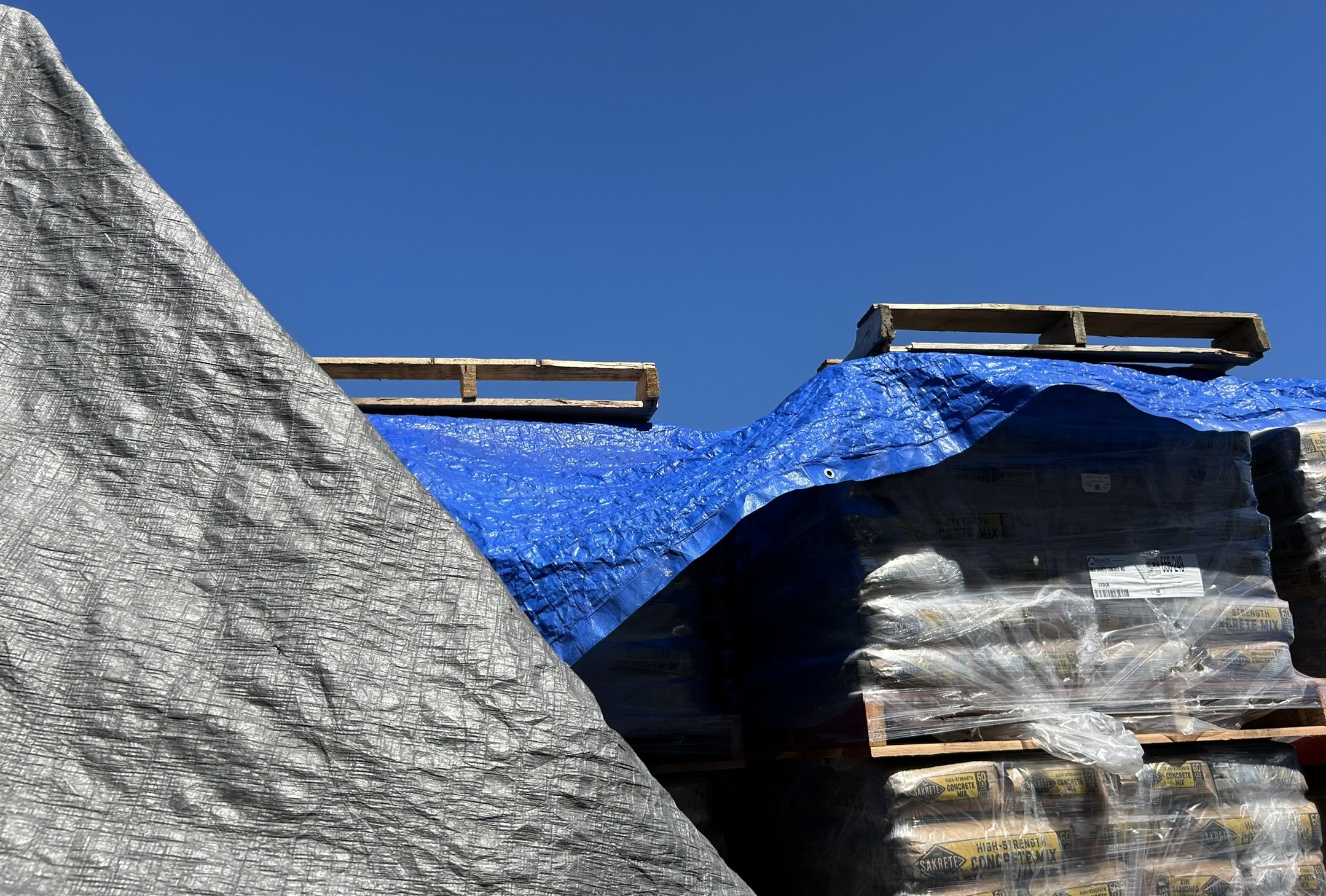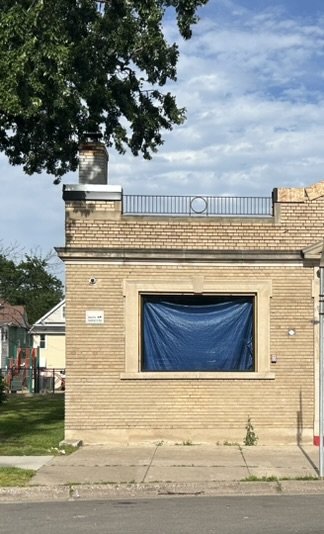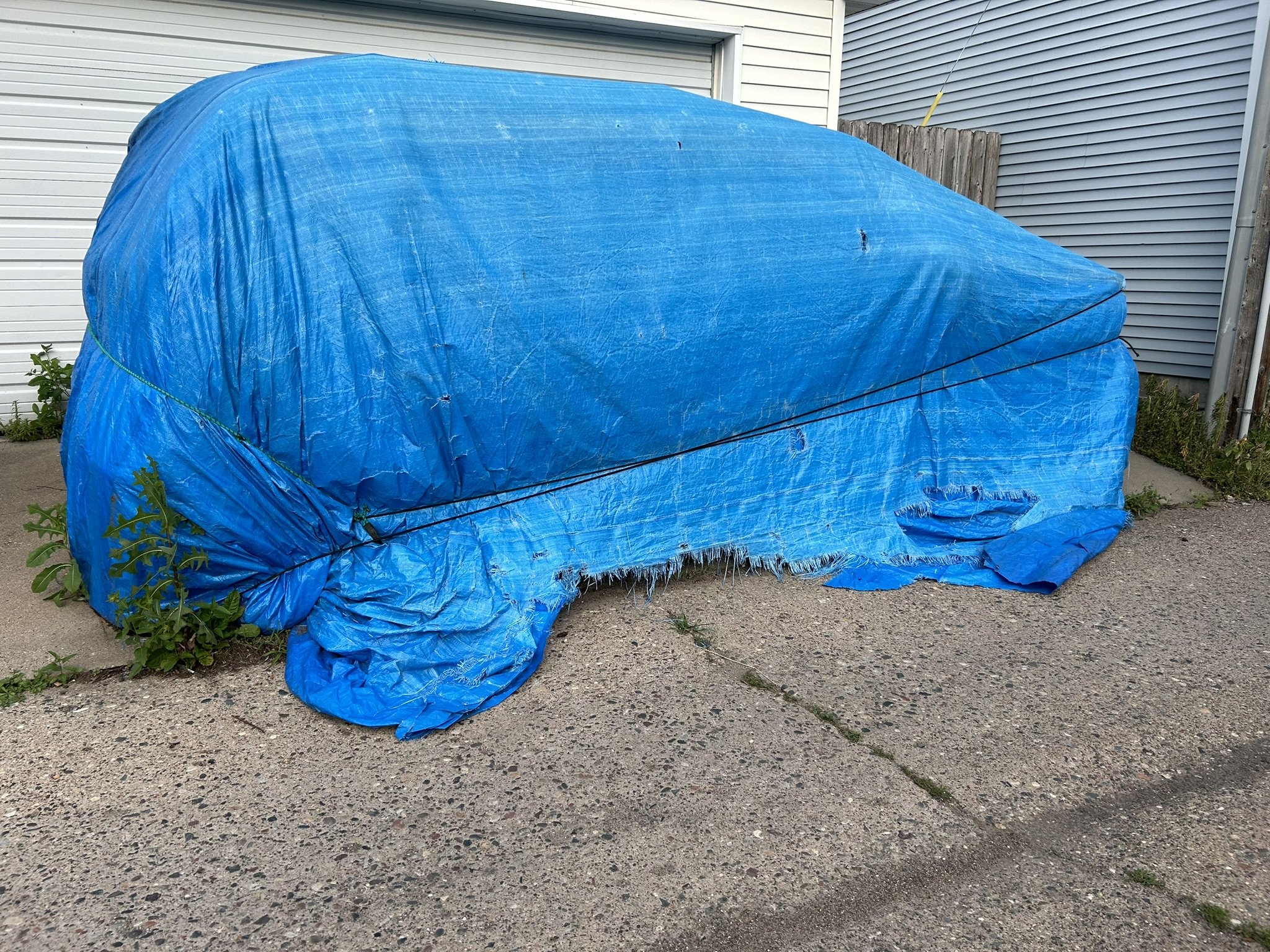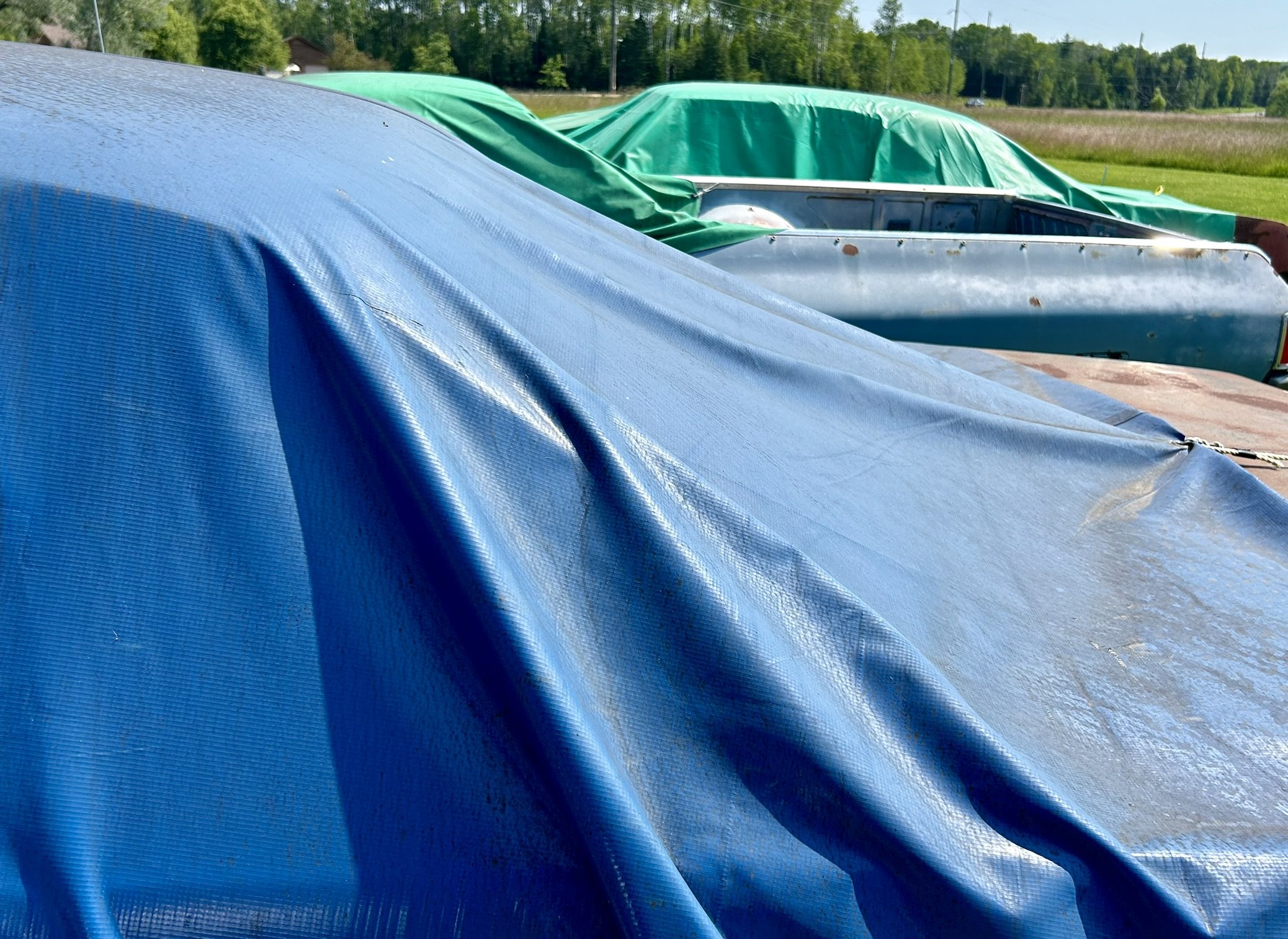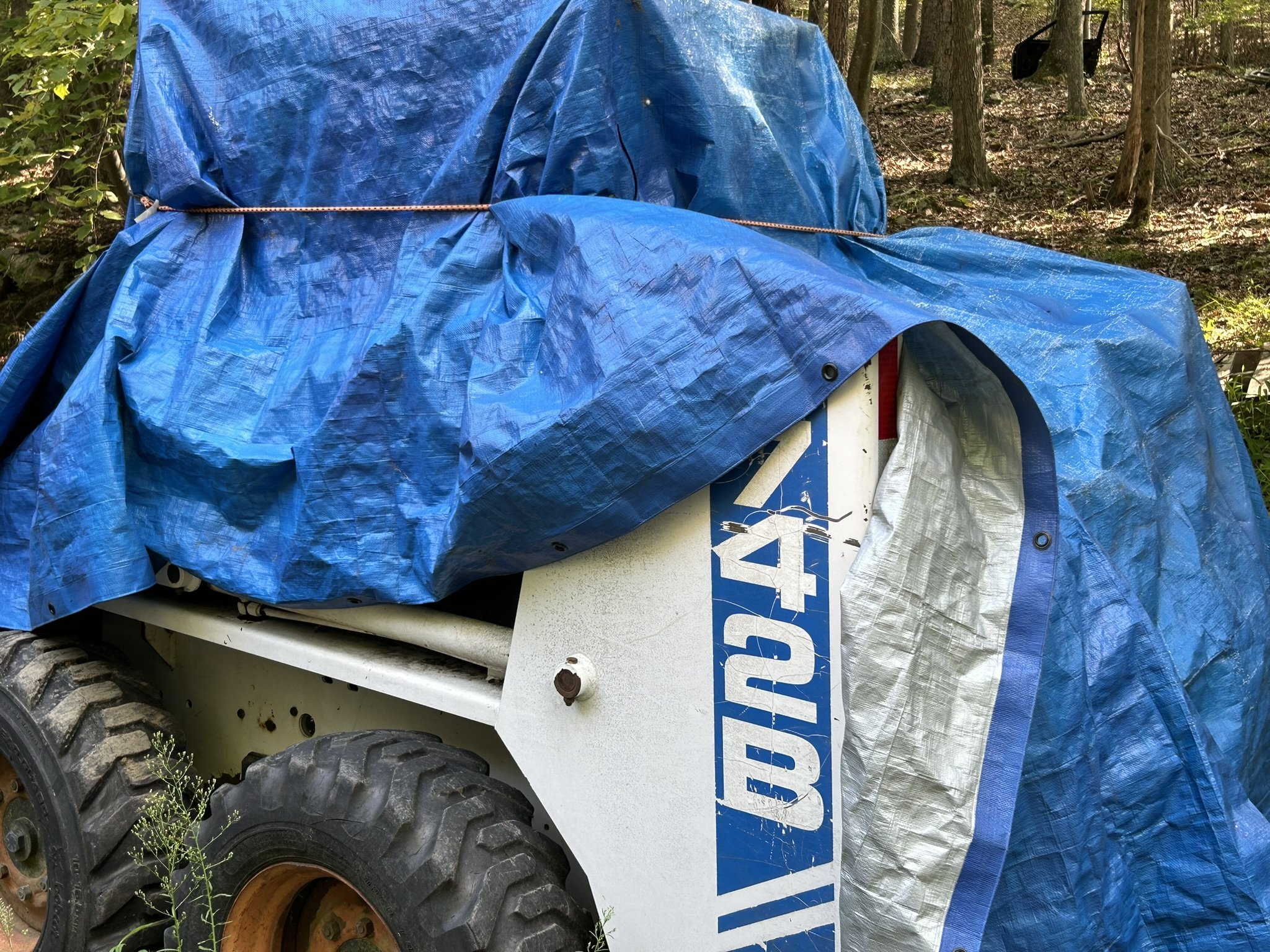january 1, 2024 - january 1, 2025
Year of the Blue Tarp
// the project
For one year—from January 1st, 2024 to January 1st, 2025—any time I encountered a blue tarp, I photographed it with whatever device I had on hand such as a phone camera, a digital camera, or a disposable camera.
I hoped to allow daily pauses for beauty and to invite blue to regularly punctuate my life. The subject matter and method also let me delight in and play with the seemingly endless possibilities of repetition and juxtaposition.
As the project progressed, I intentionally sought out more blue tarps and began to incorporate staged shots, including portraits, self-portraits, and the use of found materials.
Alongside their aesthetic appeal, to me blue tarps have come to represent grief and loss of all kinds, as blue often has, and these photos unintentionally became a way of processing a particular heartbreak. In addition, blue tarps, to me, represent physical labor. And, since they are woven from plastic, they also are a remidner of the catastrophic environmental consequences wrought by the oil and plastics industries which have intentionally intertwined our contemporary lives with petrochemical products in pursuit of maximum profits.
A selection of the resulting photographs are posted below and the complete set of 226 photos are on Instagram (@yearofthebluetarp) and, given the woven nature of tarps, create a sort of online textile installation—a digital quilt, so to speak.
In addition, fifteen of the photographs are published alongside a series of sonnets in a chapbook titled blue sonnets.
-
Since childhood, I've been obsessed with the beauty and utility of blue tarps.
I first fell in love with their many practical uses—covering wood piles, lining loaded truckbeds, giving shelter, sealing broken car windows, patching roofs, wrapping boats, hauling fallen leaves, protecting hay bales, and more—while also being taken in by their unique and vibrant hue, especially when set against the dreary greys of a northern winter.
As I grew older and traveled farther from my home city in northern Minnesota, I kept seeing blue tarps everywhere I went. I began to regard them as a ubiquitous symbol of overlooked beauty, of industrialized textile production, and of the various kinds of physical work I have undertaken to earn a living. I saw blue tarps used especially by scrappers, artisans, tradespeople, workers, farmers, gardeners, and wanderers of all kinds.
It’s not lost on me, either, how blue tarps suggest water in the ways their folds can resemble waves. Or how their expansive surfaces can receive shadows or appear as the sky.
Further, since they are so frequently used to cover other objects, I am drawn to the ways blue tarps create mystery by obscuring something else and how they highlight sculptural outlines by emphasizing form, line, and shape.
Lastly, this choice of subject matter helped me explore the tensions held within a specific textile object, since tarps are made of woven plastic.
-
Modern tarpaulins are typically made from woven polyethylene. Polyethylene is the most commonly produced plastic.
According to the Oxford English Dictionary, a tarpaulin is:
A covering or sheet of canvas coated or impregnated with tar so as to make it waterproof, used to spread over anything to protect it from wet.
The word is generally thought to be formed from tar + pall + -ing and first appears in the writen record in 1607.
The word was also used as a nickname for a mariner or sailor, especially a common sailor.
-
As I approach the halfway point of this project, I am taking a moment to pause and reflect on what I have learned so far.
So far, I have seen about 100 blue tarps this year and have taken 117 photographs.
One modification to my original constraints I decided to implement early on was that I would not photograph blue tarps that are being used by unhoused people as temporary or permanent shelter.
It doesn’t feel right to me in terms of privacy, respect, and consent.
While we desperately need more humane conversations about houselessness, this project is not the one to address that crisis. There is one exception, and that is the photo of Camp Nenookaasi taken shortly before the Minneapolis Police Department cleared the encampment. I made this exception because camp members were actively asking community members to document and spread awareness about the inhumane eviction.
I have found more reasons to love blue tarps.
I love the mystery they create when they are used to cover or conceal. I love that they are depended on to protect objects we value and objects we have forgotten. I love that they can catch the wind. I love that they are often in close proximity to dirt and to wood. I love that they are surfaces that hold light and shadow.
At this point, I have started to take photos of people interacting with blue tarps, experimenting with potraits and self-portraits.
-
One of the unexpected pleasures of this project has been encountering other artists who are seeing and appreciating blueness as well as blue tarps, specifically.
When I started out, I didn't expect to encounter the work of a photographer from Brussels, a visual artist working in Mumbai, an oil painter in the Hudson Valley, an interdisciplinary artist born in San Juan and working in NYC, a Boston-based landscape painter, and a Portland photographer—to name only some examples.
It’s a pleasure to learn from and feel connected to others who are drawn to the color, texture, and sculptural quality of the same material, others like Kevin Quiles Bonilla, Sven Laurent, Magali Duzant, Kirsten Deirup, Sameer Kulavoor, and David McCarthy. It speaks to me both to the global ubiquity of plastic and the blue tarp and to the way art can spread, since the advent of social media.
Which brings me (somehwat reluctantly) to considerations of Instagram and art and some reflections this project has led me to about so-called "amateurism.”
The way that, due to social media, DIY or "underground" or "amateur" art can exist on a platform alongside work featured in museums, galleries, or art publications is still remarkable to me. It’s not new or profound to note the current speed of technological advancement, yet this wonder stills feels true and important to me to recognize and acknowledge.
I wouldn’t go so far as to offer or endorse any uncritical, techno-utopian praise of Instagram as "democratizing," especially since it is owned and controlled by a billionaire, but I do think that because of its visual nature, in spite of itself and its demonstrably net negative impact, it retains a tiny sliver of potential to positively connect us to each other. A crack in the armor, so to speak.
I say that, I hope, without ignoring how it is highly censored, especially with regard to images from or information about the ongoing genocide in Palestine. I say that, too, acknowledging I may simply be rationalizing my own use of a heniously flawed medium. Even still, its counterparts I feel, including those also owned by Meta like Facebook, have more quickly or more fully devolved into spaces that actively foment misinformation and hate and violence (for example, the genocide in Myanmar or the proliferation of harmful Whatsapp groups) and spread fascism (see Twitter, which I refuse to call by its erasure-laden name). Bluesky is lovely but, as far as I can tell, platforms significantly less art or poetry.
It seems, for now, the artists and poets are still on Instagram.
At the outset of this project, thinking mostly about how to share photos in a feasible way, I set as part of the constraints of this project a requirement to post chronologically all the photos of blue tarps I took to Instagram in an otherwise uncurated manner, which means some are inevitably unfocused or hastily taken or flawed or "not good" in one subjective way or another. In retrospect, I'm glad I established this constraint because both the juxtaposition between "high" and "low" I mentioned above has been meaningful to me as has the somewhat quickly-decided commitment to not hide experimentation, development, process, flaws, and imperfections.
There is I think, too, a connection between the above reflections and the part of this project that became more about grief than I expected after a relationship I valued ended while the project was already in motion. I noticed the photos began to be tinged with grief, heartbreak, and my own processing of loss.
I sincerely respect and value this person’s approach to art and learned a great deal from them. This person is committed in a genuine and inspiring way to artisanship, creativity, a DIY ethos, the art happening outside of the colonialist gaze of the academy or galleries or museums, and challenging, with (to me) an admirably anarchist slant, the hierarchies and systems that can define art and culture.
Both the end of that relationship and this project led me to an important place, to honestly pause and reflect and to try and go deeper into answers about questions I had asked myself before, questions about “amateurism,” the categorization of art, and critique like: What might be the valid reasons to criticize art someone is making for themselves? What is the purpose of critique, period?
A.O. Scott’s book Better Living Through Criticism was especially helpful with these reflections. There is much more in there, but two snippets come to mind as relevant. He writes, “It’s the job of art to free our minds and the task of criticism to figure out what to do with that freedom” as well as, “What does it say about us that we have to go to an art museum to find connection with another soul? But why else would we go? Why else have we ever gone?”
On the other side of all these encounters, I feel more strongly in defense of the art all of us would like to make for any reason whatseover and of community-based art. If there is no museum, no gallery available to you, if you are able, make your own! Create your own prestige!
And in my own practice this project recentered questions that have long been present: When is the critical voice helpful, and when does it get in the way of doing the damn thing? At what stage in the artistic process is the critical voice helpful?
It reinforced for me again, as well, how incredibly social the process of creation and critique is.
---
A last note on process:
Over these months, I've learned to become more comfortable being seen as socially odd or aberrant while carrying a camera, saying sentences I never expected to say to strangers like, "I know this may seem strange, but can I take a picture of your blue tarp?" It's a relief that, most of the time, following up quickly with "It's for a photo project" relaxes initial suspicion into trust. That fact alone has restored some of my faith in the average American's appreciation, or at least tolerance, of art at a time when I feel free expression is being restricted and challenged by conservative, fascist political movements like Trumpism.
-
Thank you, Sho Nikaido, for your vision and generosity and thank you to the BlueSky Photo Workshop for your support, feedback, and encouragement.
-
In addition to encountering blue tarps on a near-daily basis, throughout the project I began to notice blue while reading. Below is an annal containing some of those encounters:
"Blueness is a state of mind, a habit of seeing."
Paul Gruchow, "The Blue Mountains of Minnesota"
"Well, under those historical pressures, the desire for choice in partners, the desire for romantic love, operate as a place, a space, away, for individual reclamations of the self. That is a part, maybe the largest part, certainly an important part, of the reconstruction of identity. Part of the "me" so tentatively articulated in Beloved. That's what she needs to discover. It will account for the satisfaction in the blues lyric and the blues phrase whether or not, and mostly not, the relationship flourishes. They're usually, you know, somebody's gone and not coming back or some terrible thing has happened and you'll never see this person again. Whether or not the affection is returned, whether or not the loved on reciprocated the ardor, the lover, the singer, has achieved something, accomplished something in the act of being in love. It's impossible to hear that sort of blues cry without acknowledging in it the defiance, the grandeur, the agency that frequently belies the wail of disappointed love."
Toni Morrison, "The Source of Self-Regard"
"Blue is difficult to find in the natural world, despite its ubiquitous presence as the color of the sky and of the sea; these are simply meteorological phenomenon. These deceptively stable blues are simply reflections and refractions; this amorphous characteristic adds to the possbility of blue skies and blue haze, places to get lost and to be found."
Magali Duzant, Light Blue Desire
"One loses sight of things when they fall into the blue."
Magali Duzant, Light Blue Desire
"Blue jeans originated in Genoa; denim, named for its origins in France ("de Nîmes"), was dyed with indigo for longevity and the ability to conceal stains, and was sold in droves to prospectors on the hunt for gold."
Magali Duzant, Light Blue Desire
"Blue is the color of contradictions; it is the color of royal blood, but also of the working class."
Magali Duzant, Light Blue Desire
"In northwestern Morocco, there is a town called Chefchaouen, known for its labyrinthe streets of blue-rinsed buildings. It is almost a blue tunnel of a town. Locals believe that the blue wards off mosquitoes. Others say it reminds inhabitants of the sky and the need to lead a spiritual life."
Magali Duzant, Light Blue Desire
"It's how a painting, real in itself, also reveals reality by connecting a blue scarf with a woman's blue eyes, for example."
Mei-Mei Berssenbrugge, A Treatise on Stars
-
My obsession with blues of all kinds has been shaped by and deepened through encounters with blues music, the poetry of Jericho Brown, Maggie Nelson's Bluets, William Least Heat-Moon's Blue Highways, Bob Dylan’s “Tangled Up in Blue,” the research of Horace-Bénédict de Saussure, and other encounters.
Below is an incomplete list of places to find more blue and a blue playlist:
CYANOMETER by Martin Bricelj Baraga, Museum of Transitory Art
“Langston Blue” by Jericho Brown
Light Blue Desire by Magali Duzant
"Carryover (Blue Tarp Series) by Kevin Quiles Bonilla







